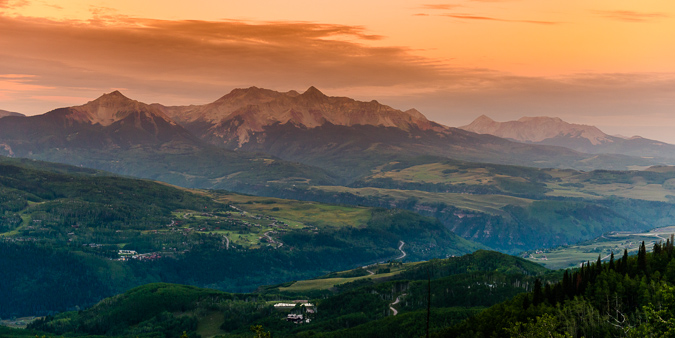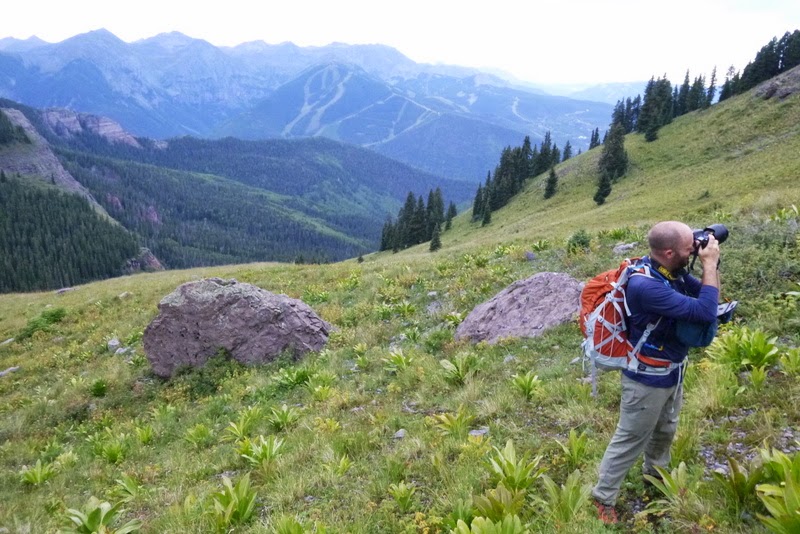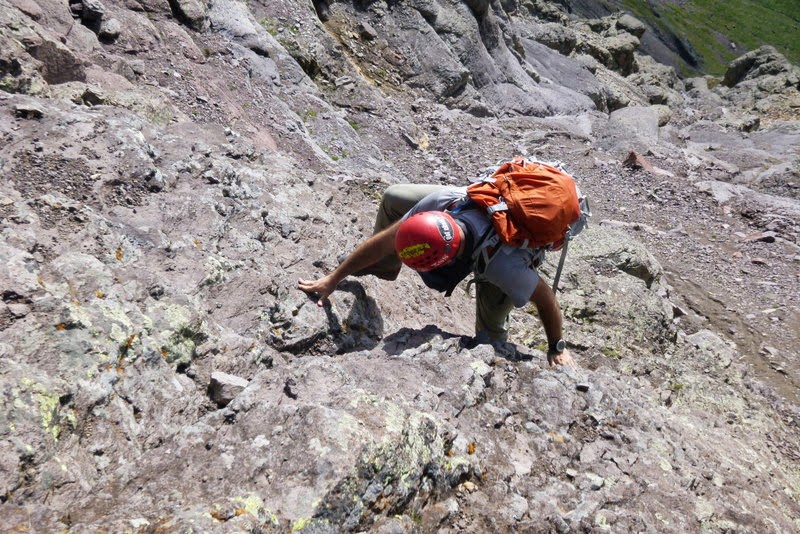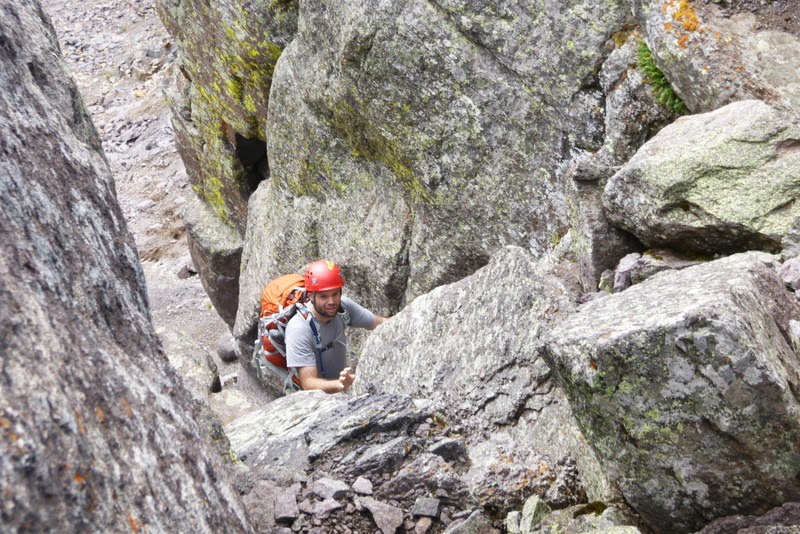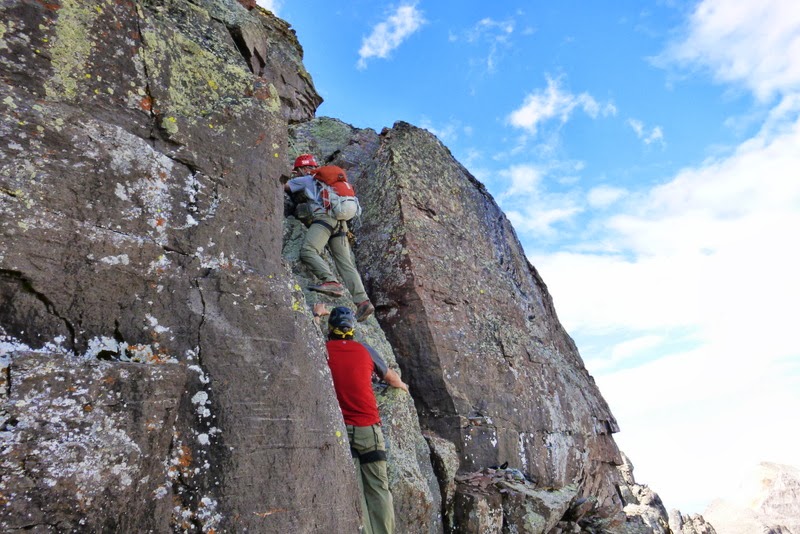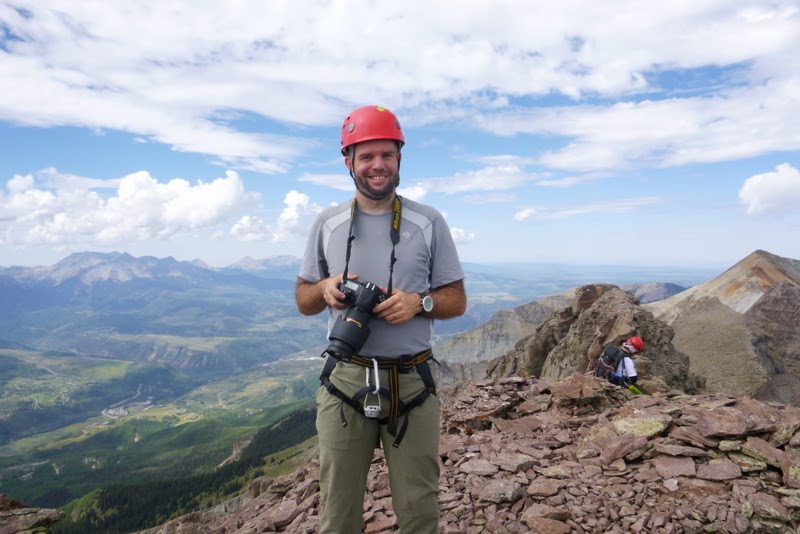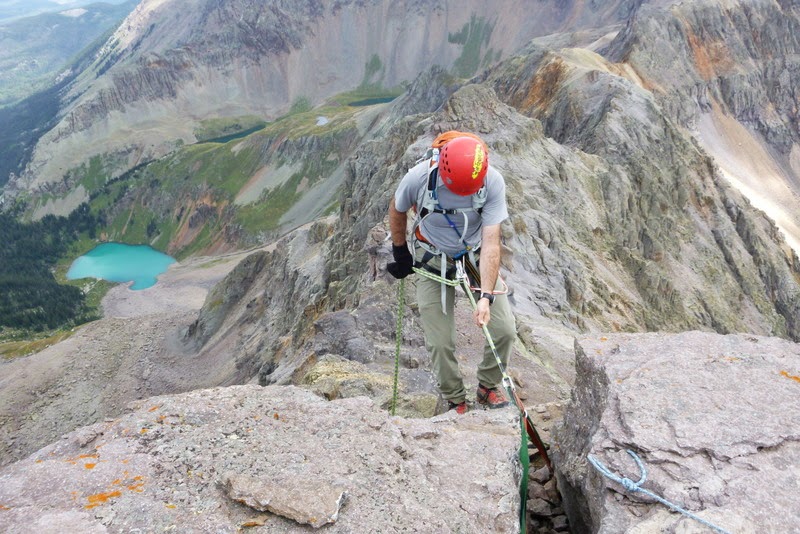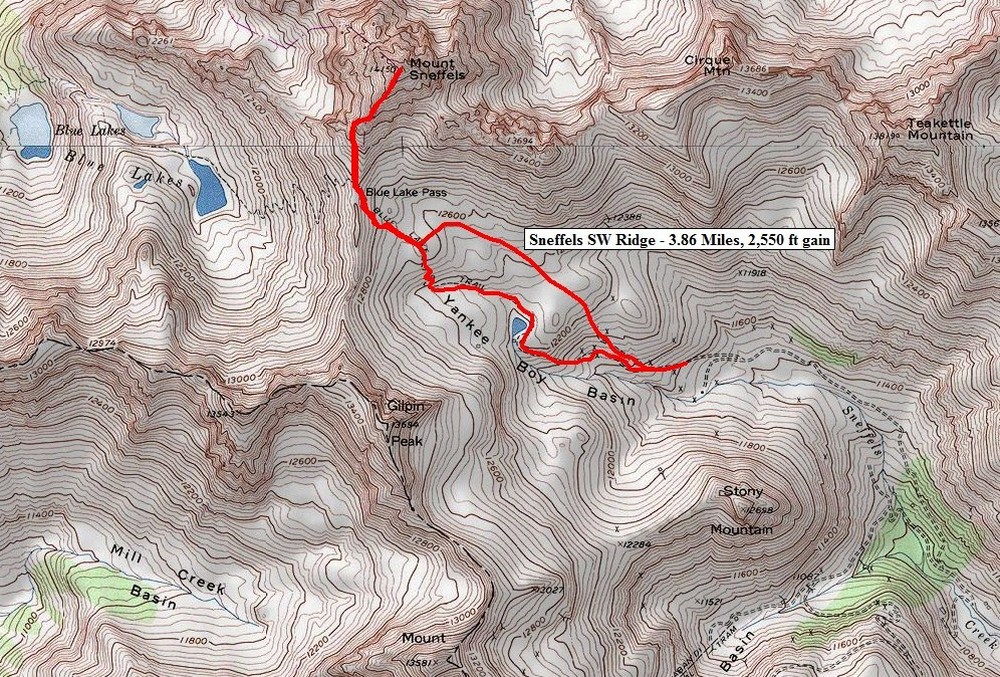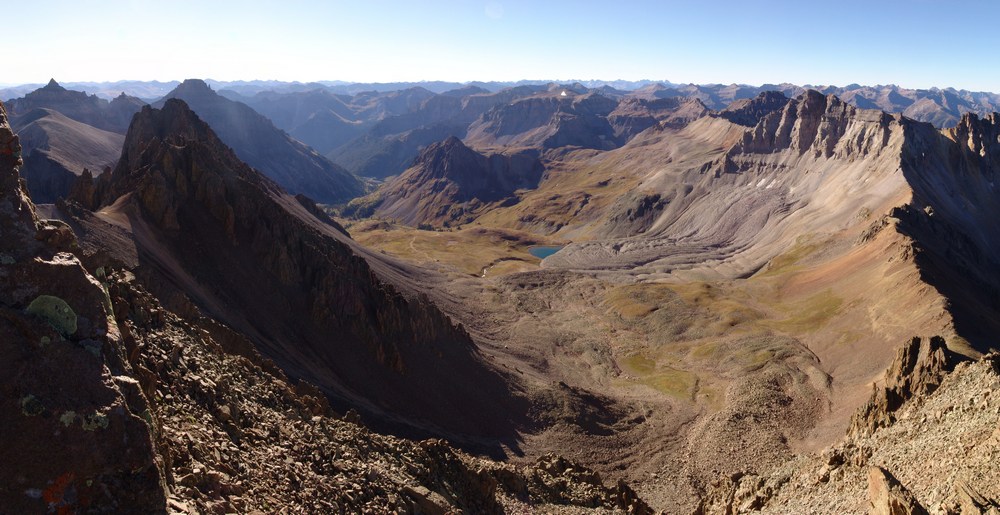Displaying items by tag: Dallas Peak
Climbing Dallas Peak - Roped Up Above Telluride Colorado
August 30, 2013
Distance: 11.5 miles (according to GPS)
Elevation: ~5,700 ft (according to GPS)
Time: 10.5 hrs (4.50 am to 3.20 pm)
Team: Rick McBee, Ben, Matt Payne and Natalie Moran
I suppose I never dreamed of climbing Dallas Peak. First viewing it's full stature from the summit of Mount Sneffels in 2010, I was immediately struck by how intimidating the peak appeared and how overwhelmed I was with a sense of fear and surrender. I'm pretty sure my exact words were, "F*!$ that!" :-)
Fast forward three years and a few climbs later and my attitude towards difficult mountaineering feats has shifted quite a bit. Peaks like Dallas are a now a hearty and welcome challenge in my quest for the highest 100 mountains of Colorado. Ever since reading about Dallas as a boy, I've been fascinated with the technical aspects of how to summit it. When you're a kid, everything looks a lot harder than it really is, and this is especially true of mountains. My mountaineering hero, my dad Ray, never did make it to the top of Dallas, having deferred his quest for the highest 100 for a middle-aged devotion to my baseball career, which surely made him father of the year multiple years running. Knowing Dallas was never completed by Ray made it even more magical and impossible in my mind, just as I had thought of Vestal's Wham Ridge before I also completed it successfully in 2010. Exacerbating my Dallas Peak magical thinking was its extremely short-lived climbing history. The thing has quite simply not been climbed a whole lot. As Rosebrough puts it:
"Interest was renewed in Dallas Peak in 1976 when Spencer Swanger made a solo climb of the peak, which was the last of the hundred highest peaks in Colorado which he had not climbed. Swanger felt that of the nearly 300 climbs he had made, 'perhaps Dallas had been the toughest.' Indeed, only two ascents of Dallas have been recorded before Spencer Swanger's, Don McBride and Everett Long in 1934; and Stuart Krebs in 1956." - Robert Rosebrough - The San Juan Mountains - A Climbing and Hiking Guide.
So, when I received an email from Rick McBee about climbing Dallas and Teakettle on Labor Day weekend, I immediately responded with a prompt "I'm all in." Rick and I became acquainted with each other last year when he sent me a message after I completed the 14ers. He purchased several of my photographs for his company after seeing my shots from my Pyramid Peak and Maroon Peak trip report. I knew Rick as a fellow 14er completer and a very awesome dude. He had also named another accomplished mountaineer, Natalie Moran, as being a part of the climbing party, so my confidence in our success was very high. I had heard great things about Natalie from other 14ers.com members and so I felt great about our odds. The plan was to meet at the Mill Creek Trailhead above Telluride on Thursday night and climb Dallas on Friday morning. After Dallas Peak, we'd head over to Ouray and climb Teakettle Mountain on Saturday. Both mountains demanded the use of ropes and a keen ability for rappelling, neither of which being things that I am an expert in. I warned Rick of this and he assured me it was not a problem at all.
I debated a great deal as to which camera lens or lenses to bring for this trip, knowing I would be doing some technical climbing and quite a bit of tricky maneuvering on shaky terrain. I eventually decided to bring the heavier yet versatile Nikon 24-70 f/2.8 attached to my D800. Strapping the camera and lens to my chest vis-a-vis my Lowepro Toploader would not be too difficult, and I could always opt to throw the camera bag into my backpack for the roped sections. Note and shameless disclaimer: those are affiliate links above, so if you like to shop at B+H and want to help keep the site running, please consider using them.
The drive to Telluride was totally uneventful minus some construction on Highway 50 between Gunnison and Montrose. My last stint through Montrose led me to a Denny's which was not exactly the most vegetarian-friendly establishment. I regretted not doing more research, again, and opted for a trip to Subway before heading to Telluride from Montrose. The trip began well, as I caught up on my email while eating dinner to learn I had won tickets to see Bill Burr at the Pikes Peak Center. Woohoo! A good omen indeed. Per usual Centennial procedure, I consulted Gerry Roach's "Colorado's Thirteeners" book for directions on how to find the trailhead. The description provided by Roach was quite accurate, taking me up an un-marked road exactly 1.9 miles east of the Highway 145 turn-off for Telluride. So far so good. My Subaru Forester made it up the hill without incident and I found both Rick and Natalie's vehicles parked on the side of the road near the end of the Mill Creek Road. I parked my car and introduced myself to Rick and his friend Ben, who was joining us for Dallas. Natalie was already fast asleep in her Forester. I decided to sleep next to them in front of my car, so I would have to test the sleepability of my Forester another night. The stars were out, but only for a brief moment as clouds rolled into the valley.
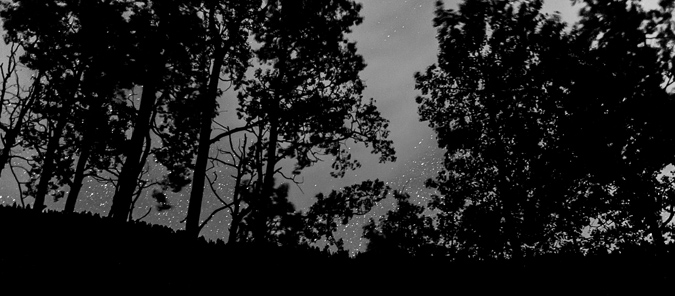
We all woke up at 4:30 AM for a 5 AM start. I introduced myself to Natalie, after having exchanged several private messages with her over the past couple of years on the 14ers.com forum. I knew that Natalie was from Russia, so it was quite awesome to hear her accent. You see, as my wife will attest, I have a thing for accents. They intrigue me, and I love listening to people talk with them. We began our hike up the trail and were immediately stumped by a marked split in the trail, a common occurrence when you begin hikes in the dark. Fortunately or unfortunately, depending on your outlook on the accuracy and usefulness of Roach's route descriptions, Natalie had brought a copy of the route description from Roach's book, which clearly stated to take a left at the signed trail junction, which we eventually did after some debate. Here's a photo of that trail junction taken later in the day on our waydown, which is clearly marked as the Deep Creek Trail.
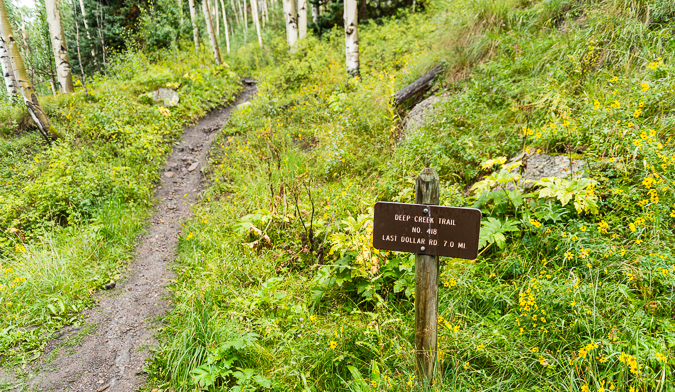
From this junction, Roach writes that you need to hike another .7 miles through three switchbacks to a meadow at 10,000 ft. and then west through the meadow. For some reason we thought there would be another trail to take after finding the meadow; however, that was our misunderstanding. We found the large meadow in the dark, which continued west and then north. A heavy layer of clouds still obscured our views. We knew we were looking for the Sneffels Highline Trail after reaching a ridge at 10,600 ft. We found this trail without any issues as well, but were confused quite a bit in the dark before finding and turning right onto the marked trail junction as depicted below.
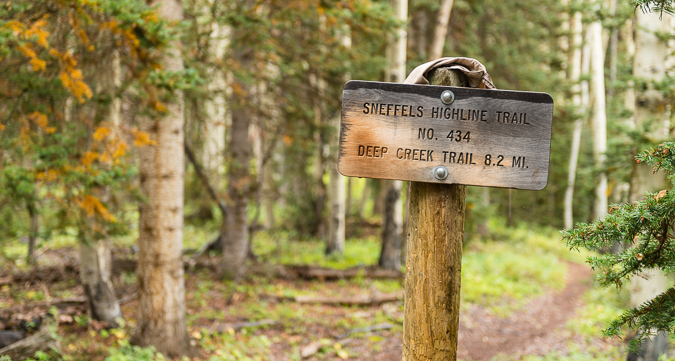
The views from the Sneffels Highline Trail were divine in the early morning light, showcasing amazing scenes of the Wilson Peak group to the southwest of us.
The light hitting the mountains above Telluride was absolutely sublime, and made for quite the stunning black and white image.
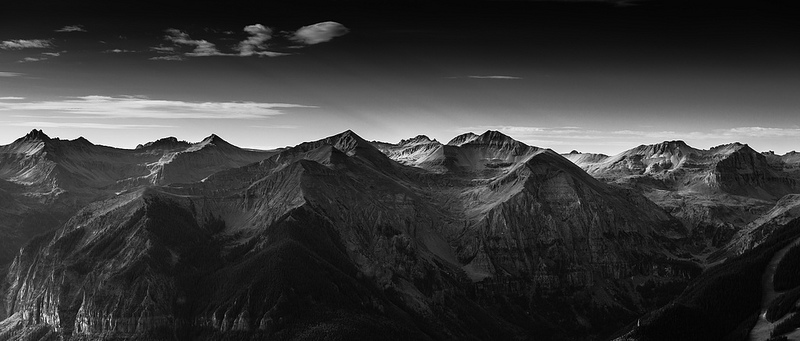
We followed up the trail through seven switchbacks as described by Roach and then found ourselves wondering when to start climbing up the slopes of Dallas. We found the trail quite easy to follow but often questioned our location and direction, having to consult GPS and map quite often before agreeing on our next course of action.
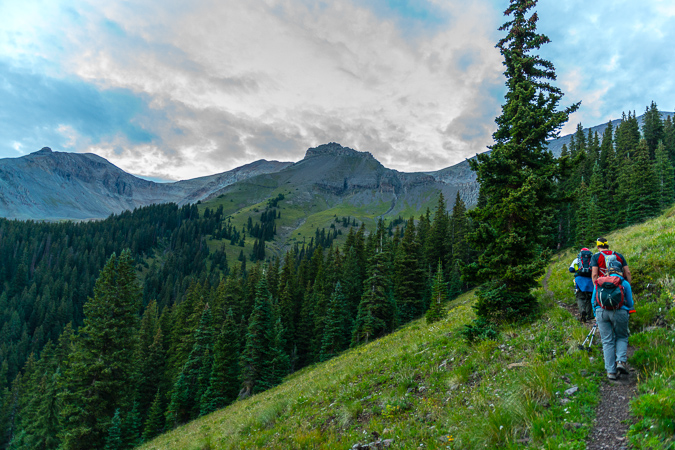
As the trail wrapped up and around the southern flank of Dallas, views to the north and west continued to wow us as the morning progressed. We were making great time, taking minimal breaks. I tried to stay back a little so I could get some good photos of the route heading up and of our awesome party.
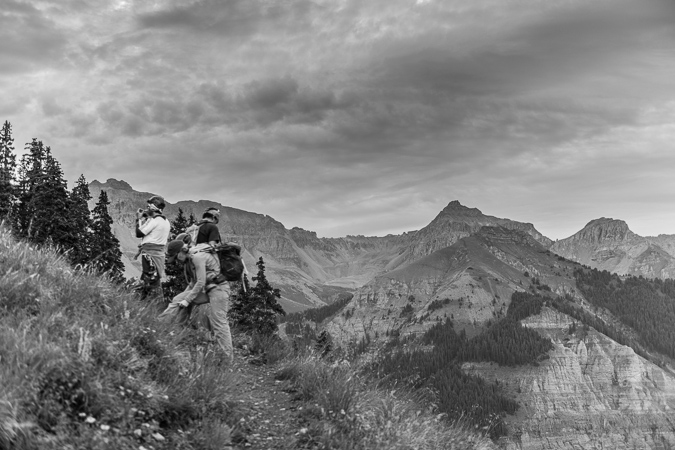
Rick and Ben were setting the pace and keeping us on the right path, with an occasional team discussion about our next moves. Man, it was great having competent mountaineers on this trip. Rick was a strong leader, and Ben was a true champ.

The sky was pretty overcast most of the morning, but that did not stop the sun from lighting up the San Juan peaks above Telluride, across from us to the south.
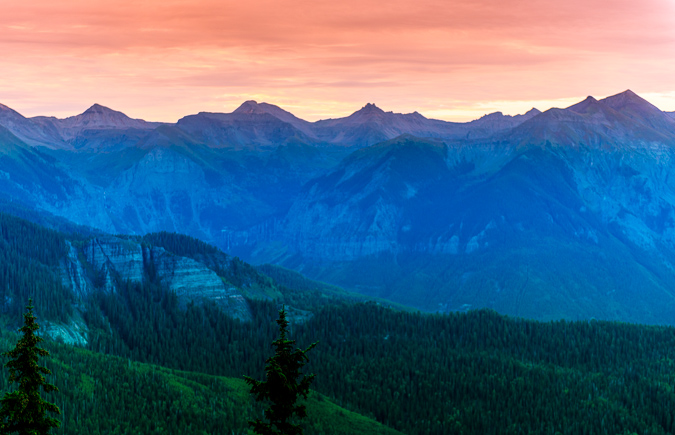
We continued up the Sneffels Highline trail and enjoyed our views to the south very much. It was a very calm morning, and we were holding onto hope that the weather would improve and that our day would be marked with success on Dallas.
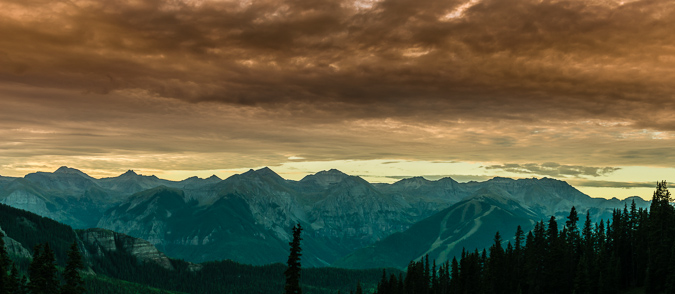
After losing a little elevation and crossing a small creek, the trail wraps around to the south and west and then across a large grassy area below Dallas, where we began eye-balling our route up to the first cliff bands on Dallas' southern flank, shown as a white band in the photo below.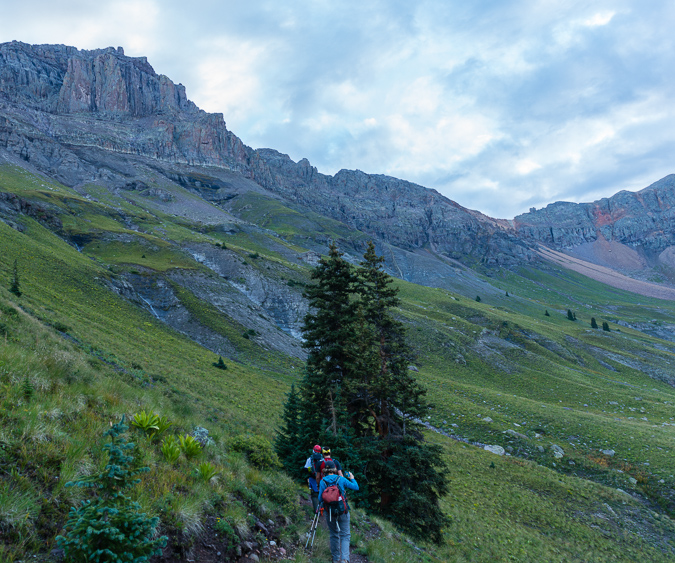
We left the trail at stream coming down from Dallas and fanned out to ascend the very steep grassy slope up to Dallas' cliffs.
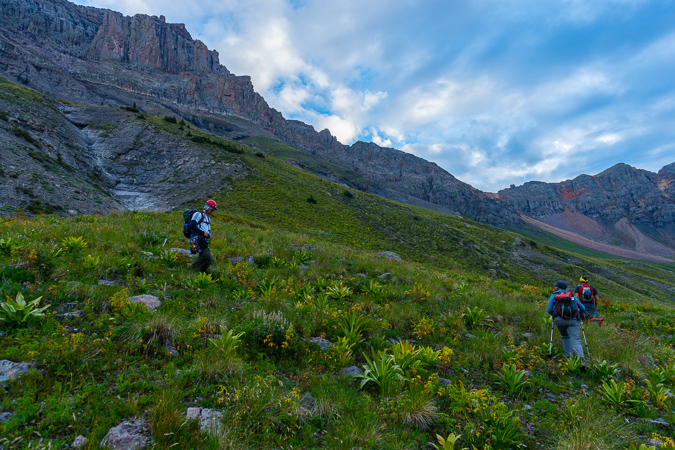
As we climbed, a deer was seen above us on a ridge. I did not have a telephoto lens with me, so this is heavily cropped from the D800 (about 100%).
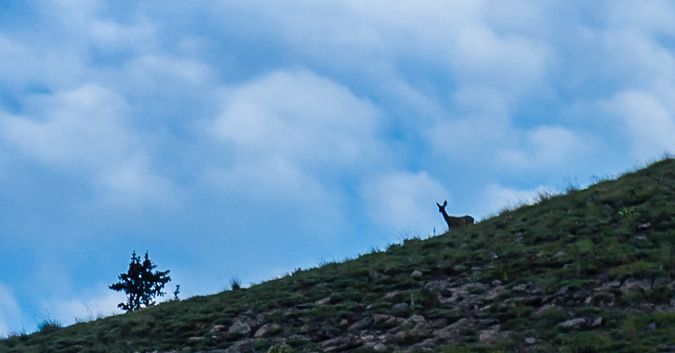
Natalie sneaked a photo of me taking that shot. It was great having some people other than me taking photos!
Telluride was still looking great in this photo of Natalie as we continued up the steep grassy hillside.
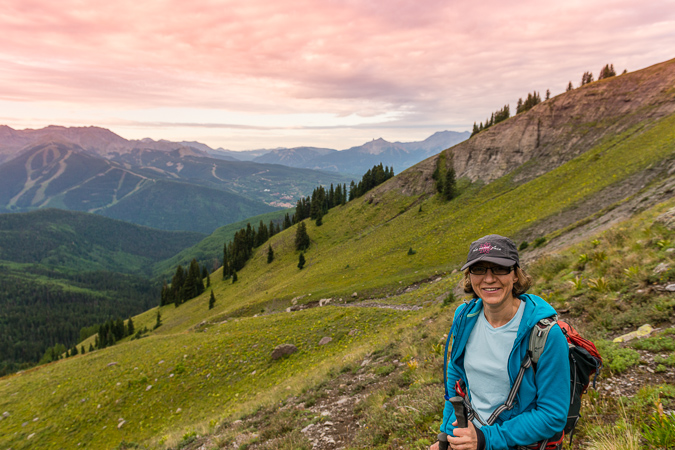
And of course Lizard Head, Mount Wilson, El Diente and Wilson Peak (left to right) looked amazing across the valley from us.
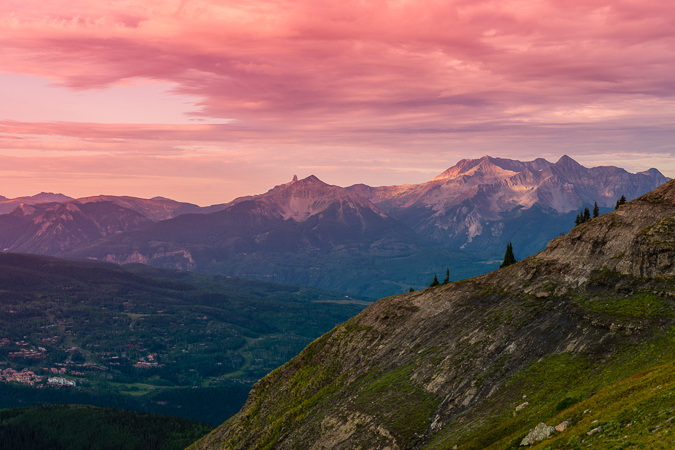
Ben volunteered to take a shot of me heading up with my camera, with the great light behind us. Thanks Ben!
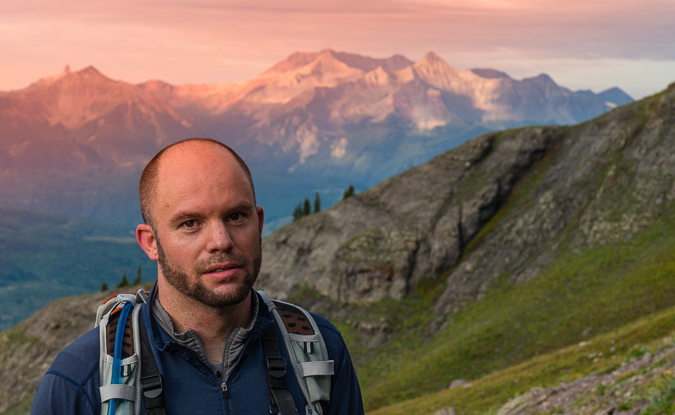
Mount Emma was also looking amazing as we ascended to the cliff bands, with early sun behind.
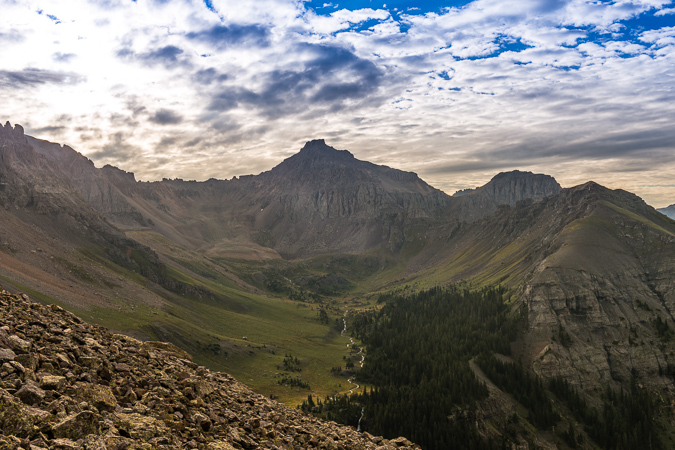
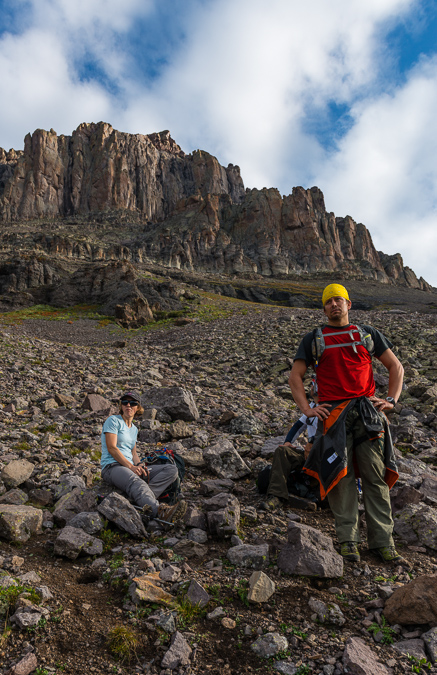
The lower section of this part of the climb was pretty straight forward, albeit rather steep. There was good rock and grass to grip with our boots, and the larger rocks were quite avoidable through here. We found this part of the climb to be relatively simple with little to no route-finding needed. There were numerous areas that had a clear trail identified all the way up to the cliff bands. We stopped a few times to catch our breath and take in the views.
We were a very strong group, so stops were not very frequent. Also, for not climbing together before, we were quite friendly and the group's conversations were very enjoyable. Rick carried the rope while I did the heavy lifting with the camera. Ben and Rick wore their harnesses all the way up, while Natalie and I opted to leave those in our packs until they were needed later.
We continued up the easier section without any issues. When we reached the first set of cliff bands, we were a little unsure where to go until some cairns revealed themselves to us and the route up past the cliff bands to the left became obvious. Also, the climbing become much more exciting as we entered some very fun class 3 sections of rock ledges.
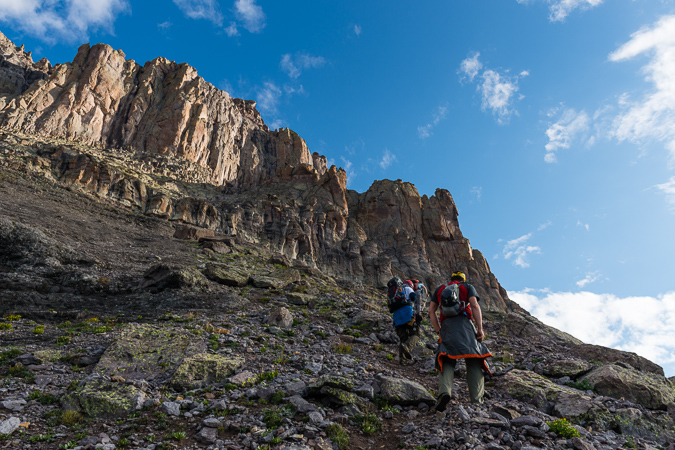
Here's a shot of me heading up the class 3 section, taken by Rick. You can also see the general area we came from, having left the trail about where the trees end near the bottom of the rock gully far below.
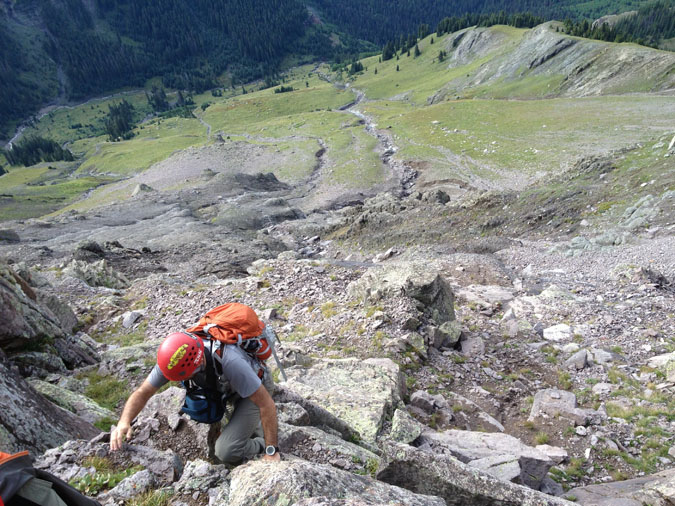
As we continued up the lengthy class 3 section, the light below Mount Emma improved, illuminating the awesome stream coming down from above.
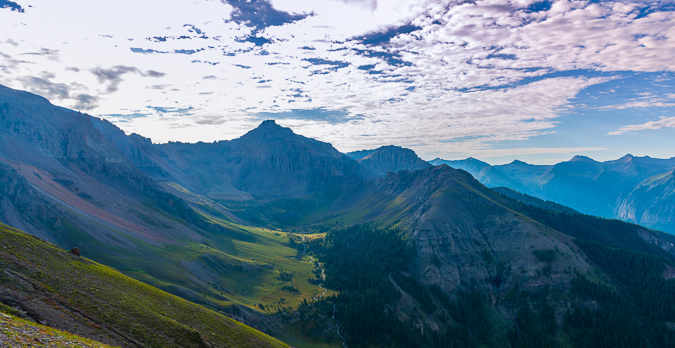
We found the climbing in this area to be very fun and enjoyable, with only the occasional loose section of rock. Natalie was a wicked climber and did a wonderful job of surveying the route.
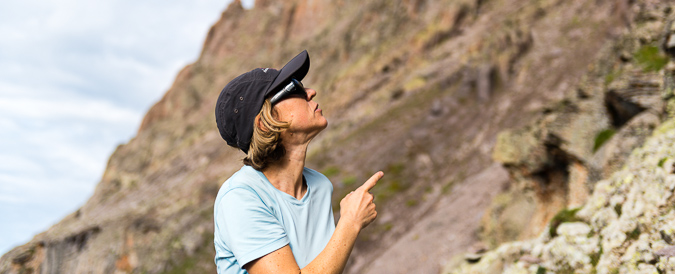
Dallas was quite imposing as we reached higher and higher to the base of the peak.
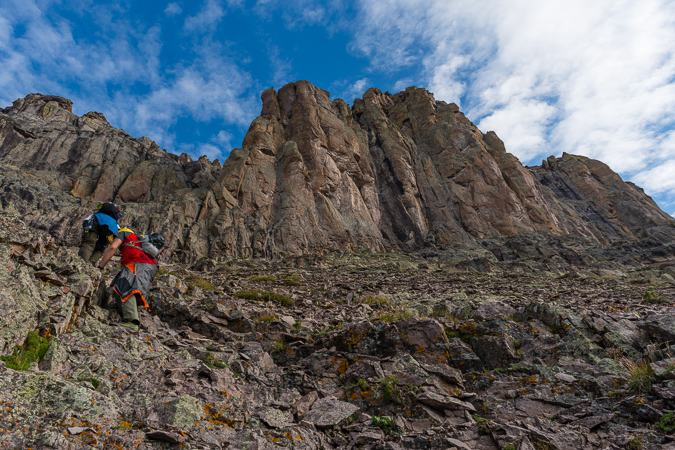
And damn, the light over on the Wilson's was spectacular in the early morning sun.

The terrain got a little more tricky as we kept heading higher on the southern flank of Dallas, forcing us to find fun and entertaining routes up the mostly solid rock. Here's Natalie powering up one of the final sections of this part of the route.
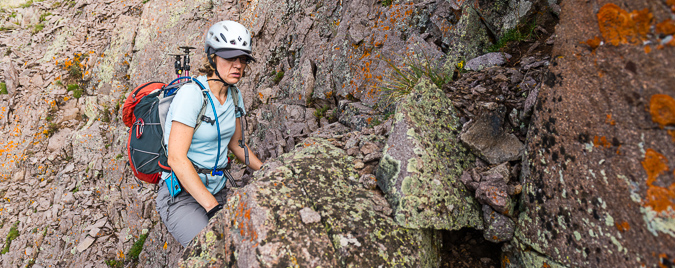
Once up to the end of the cliff band, the route evened out quite a bit and lead us to the west to a notch referred to as 13,000 ft. notch. Rick led the way.
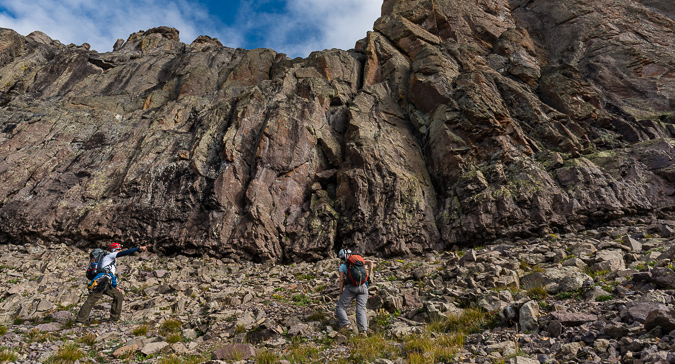
The route heading up to the notch was very straight-forward, we just followed the cliff band and up a boulder field on a very well-established trail.
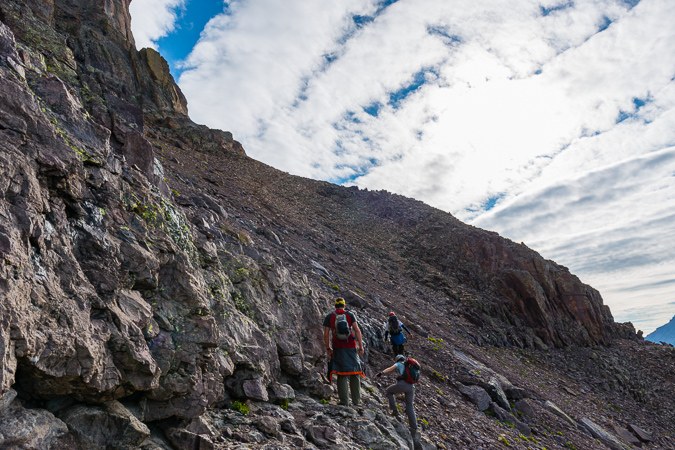
A look back on the route we took up to the notch.

As we rounded the corner a bit, the route to the notch became even more apparent - stay as far left as possible without climbing straight up a wall.
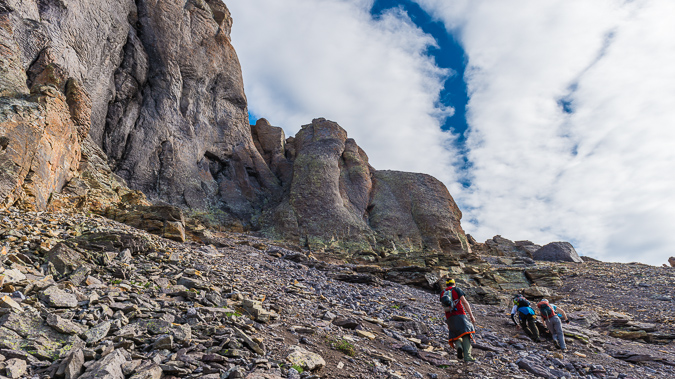
We stopped just below the notch to enjoy the views.
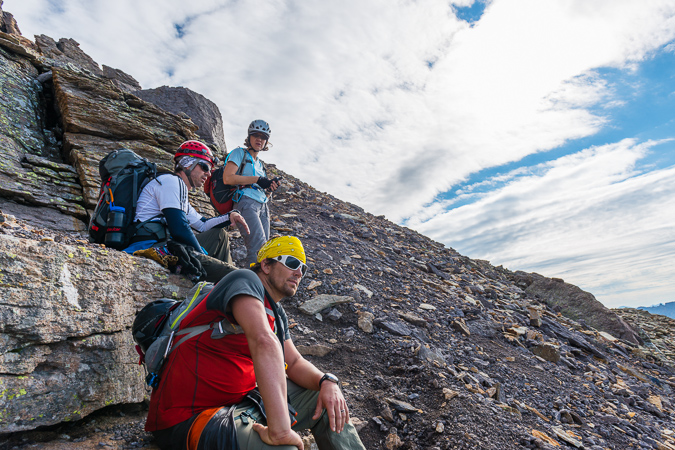
The frequent rain over the past few months really greened-up the mountain-sides. Vestal and Arrow were just coming into view in the distance (left middle).
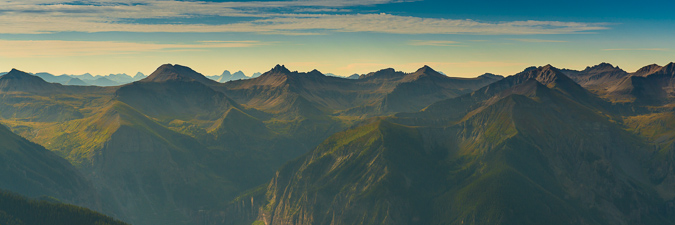
A look back at the Wilson Peak/Mount Wilson massif shows the trail we followed up to the notch.
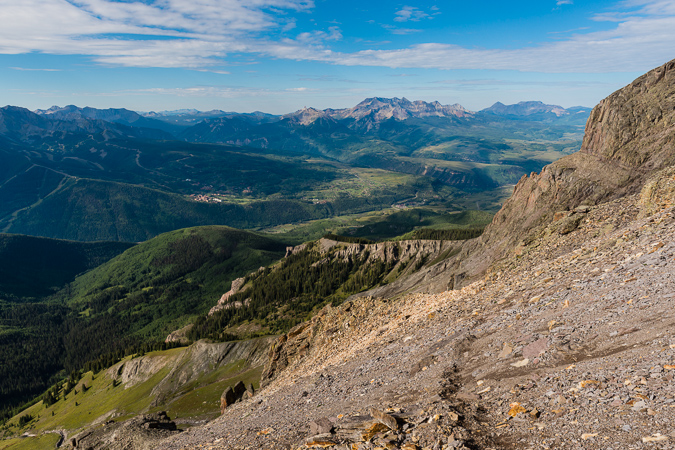
As we reached the notch and rounded the corner to head up the west face of Dallas, Sneffels and Teakettle came into view, filling us all with a sense of excitement and glory.
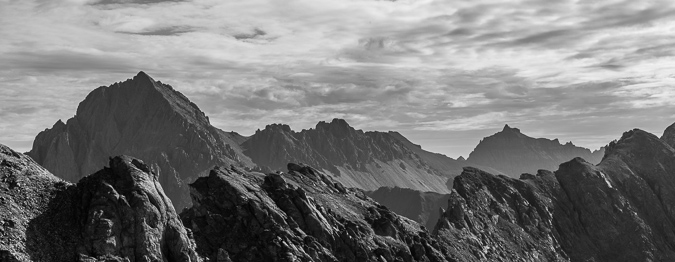
Once the notch is reached, the fun begins. We immediately began working our way up a fairly obvious route towards Dallas' summit towers above through loose dirt and rocks.
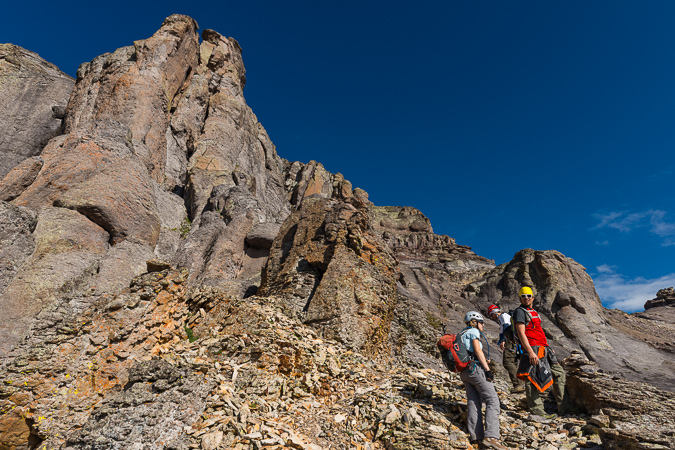
Teakettle was looking quite awesome. I was savoring it already. I was wishing I had a longer lens to get a nice zoomed-in look at the handle of the kettle, but a super-cropped shot from the 24-70 would have to do.
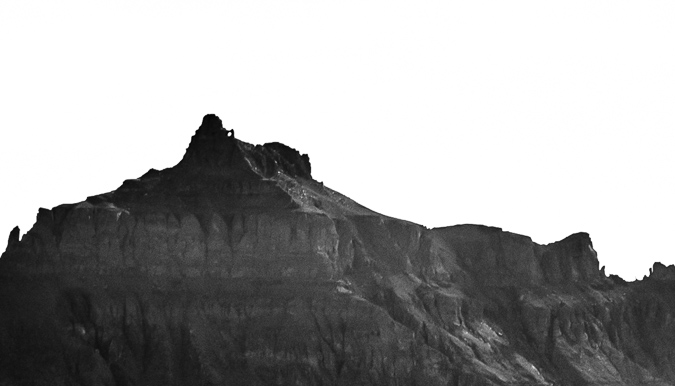
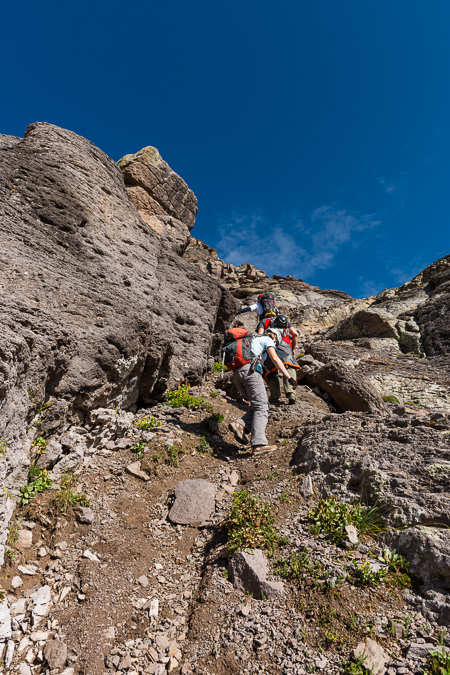 Climbing up this section was pretty straight-forward, but quite loose. I could see this being a challenging section if there was snow on the ground still or if significant rain had happened prior to the climb. There seemed to be a feint trail all the way up to the class 4 section on the west face. The trail led us up this loose gully that was directly against the face of the peak, and then over some ledges to the west.
Climbing up this section was pretty straight-forward, but quite loose. I could see this being a challenging section if there was snow on the ground still or if significant rain had happened prior to the climb. There seemed to be a feint trail all the way up to the class 4 section on the west face. The trail led us up this loose gully that was directly against the face of the peak, and then over some ledges to the west.
Once over the ledge system we reached what was clearly the class 4 section. To our left was an impassable chimney and to our right was a huge drop-off into the basin between Dallas and Sneffels. We worked our way up to the base of the class 4 section and mentally prepared for the steep rocks that awaited us above.
Finding the class 4 section was not hard, but locating a route up it was quite the challenge! I love class 4, personally, so I was very happy to find this section, as I had mostly forgotten about it from the route descriptions I had read. A look back down where we came up showed just how steep the west face was, but it was certainly nothing too hard, in my opinion.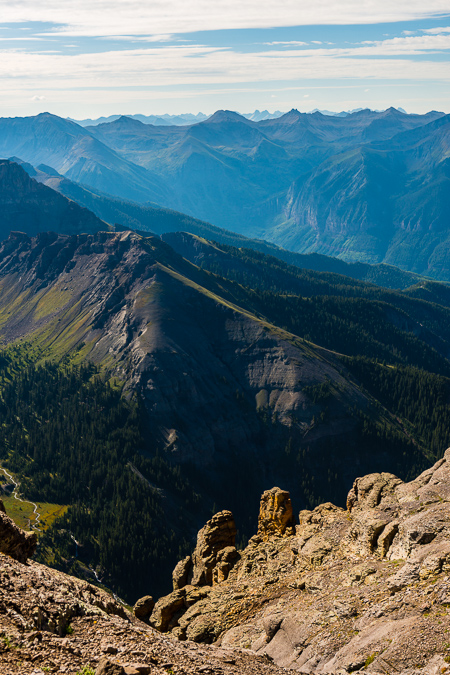
Approaching the class 4 section was not hard, but it was strewn with a lot of loose garbage.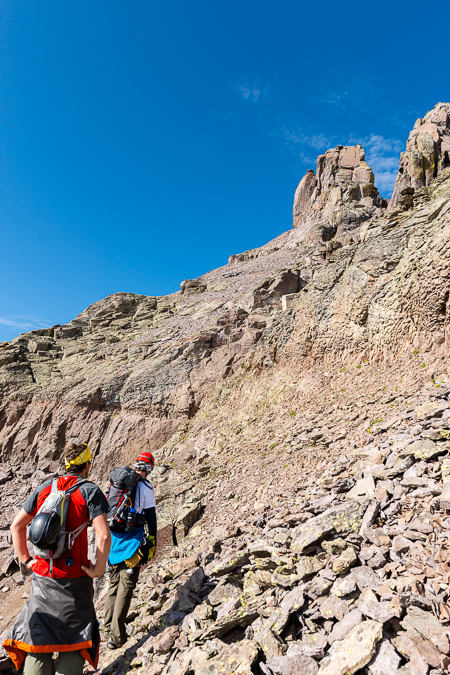
I kept my position as caboose and Natalie fired off some shots of me coming up the class 4 section, which I found to be quite exposed but very solid.
I continued to enjoy the views of Sneffels as we continued up the side of Dallas.
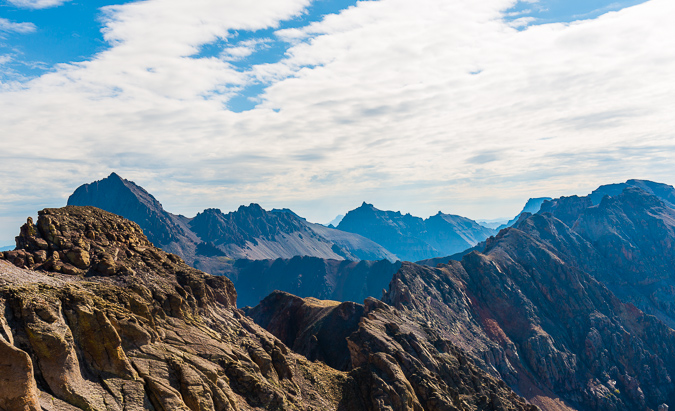
We found the class 4 anchor station, which we figured some people used to rappel down the class 4 on the way off the mountain.
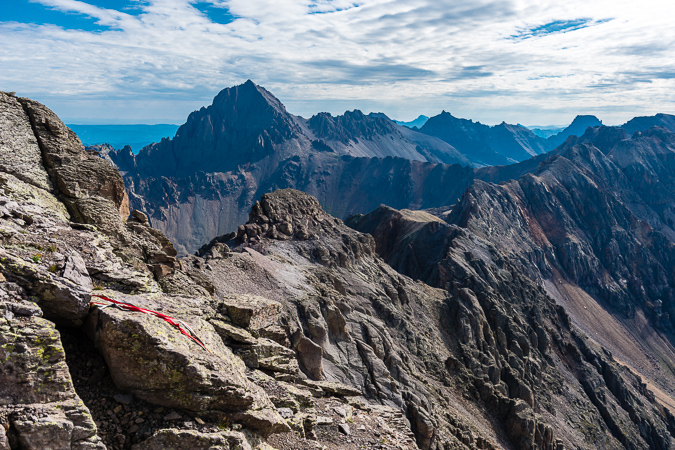
At this point, the route became looser and steeper, but nothing overwhelming in nature. We followed the loose scree up to the first crux below the summit towers.
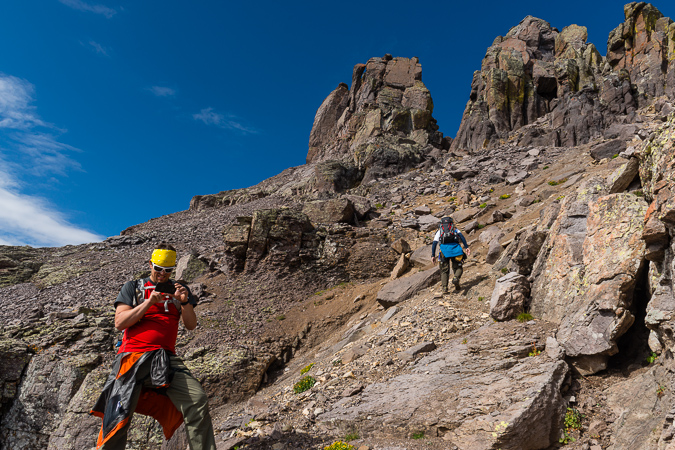
A look back towards Sneffels revealed some awesome hoodoos on the ridge. What a cool geologic playground.

Almost to the first crux, Ben and I stop to revel in the San Juan glory behind us.
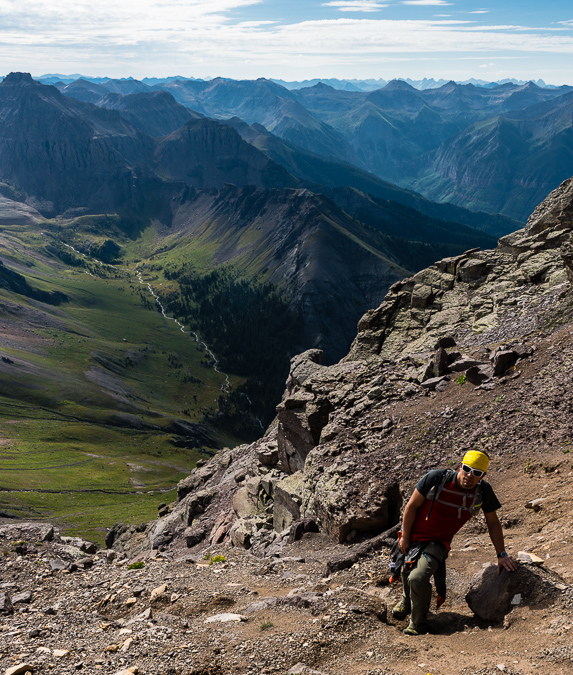
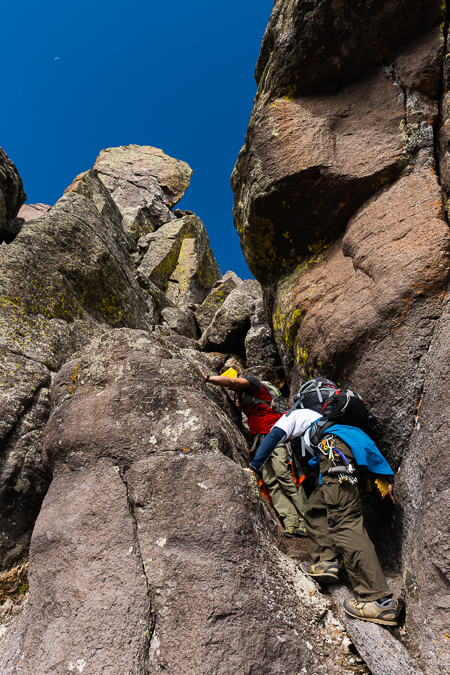
We reached the first crux, which was quite obvious and marked at its base with a cairn. This chimney looked very challenging and I was wondering how I would get up it with my camera on my chest.
Thinking that would not work out so well, I opted to put my camera bag away and head up the same way as the rest of the group. The chimney was low class 5, for sure.
I found ample but difficult handholds on the left side of the chimney and worked my way up to the first ledge seen just above Ben's yellow bandana above.
From this ledge, the route becomes a little less obvious, and the footing is somewhat unstable due to the slope of the rock you are standing on; however, I decided to head to the left through an awkwardly diagonal weakness between rocks.
We did not rope up for this short section, but I think some parties might benefit from a rope at this spot for some added security and peace of mind.
Natalie captured a photo of me coming up the small chimney from above.
A view from above, shot by Rick:
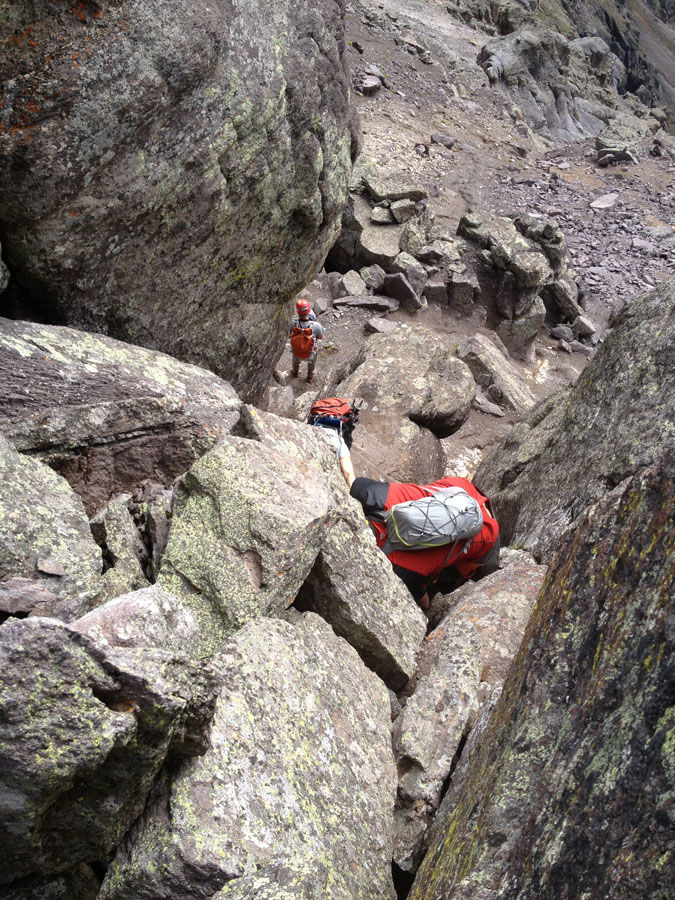 |
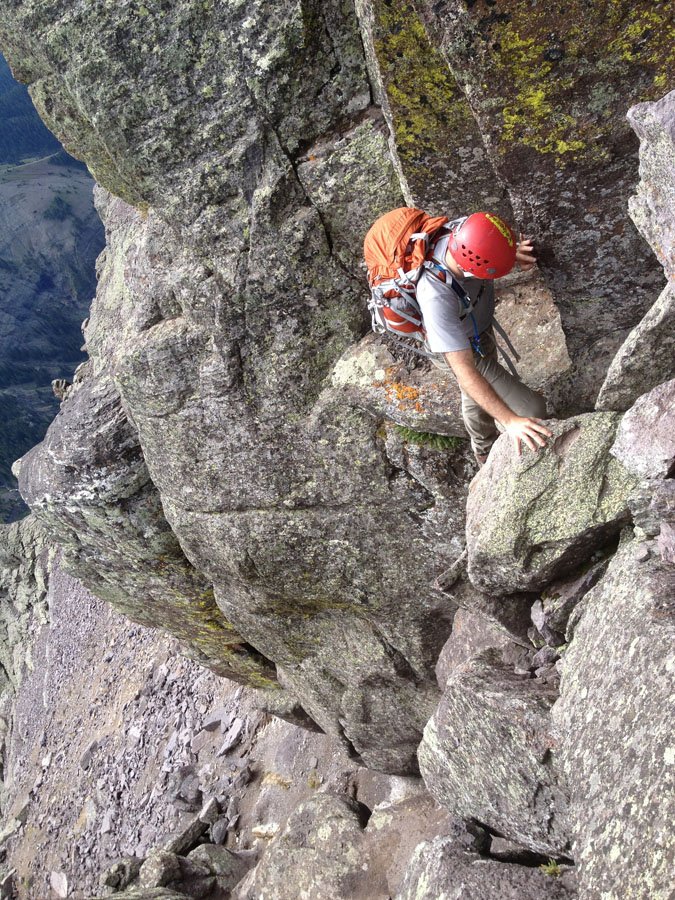 |
Here's another view looking up from the bottom, showing the general line you take to reach the top of the chimney.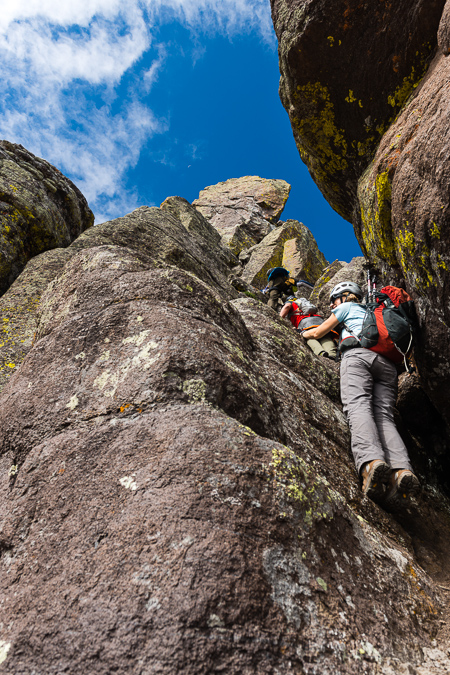
We also found an anchor at the top of the 1st crux and figured it was used to top rope the chimney. Photo by Natalie.
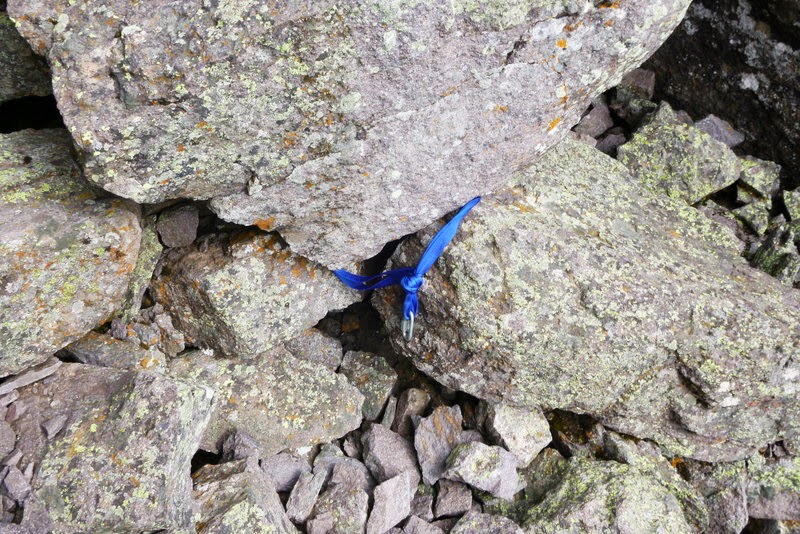
Once past the chimney, we were a little perplexed as to where to go next. Ben and Rick study the route in this photo from Natalie.
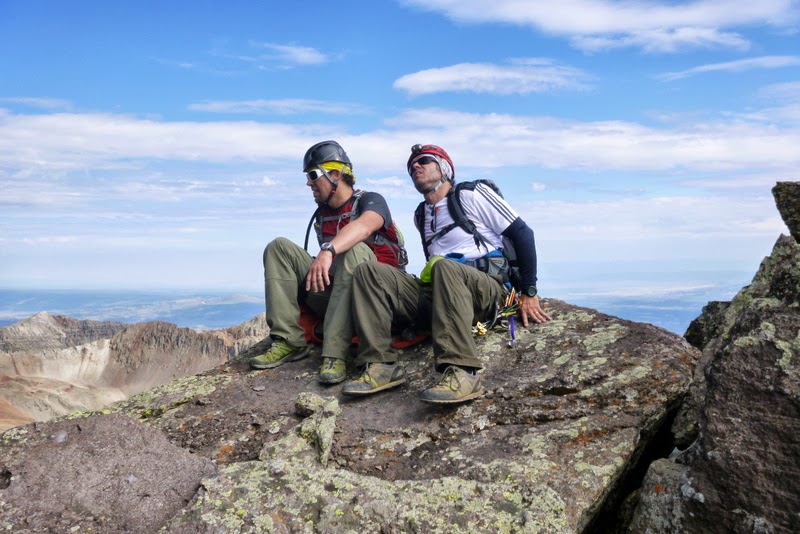
The route was not obvious at all. Roach describes down-climbing from here, but we found no such need or desire. The only way that looked even do-able was a ledge system going up and around the north face of Dallas, which had dramatic exposure as seen in this photo snapped by Natalie. Would you downclimb here? No - thanks though Roach.
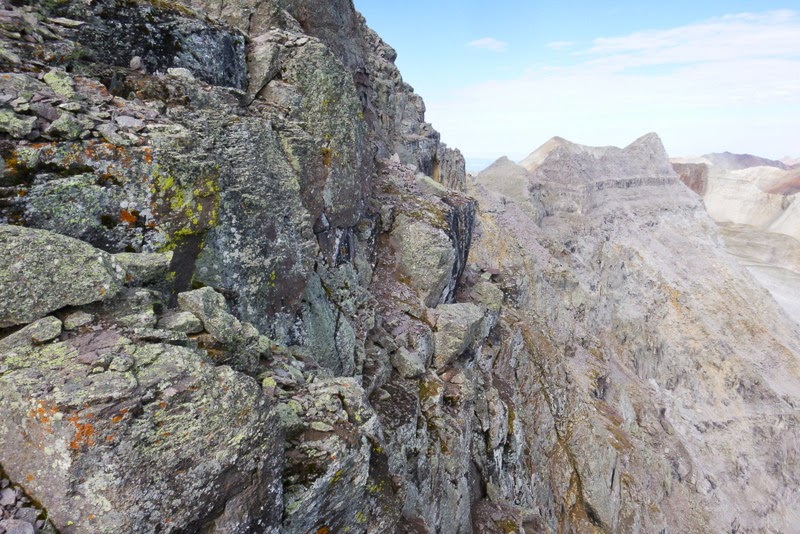
Following a lightly worn area of rock up a small series of ledges proved to be the best bet.
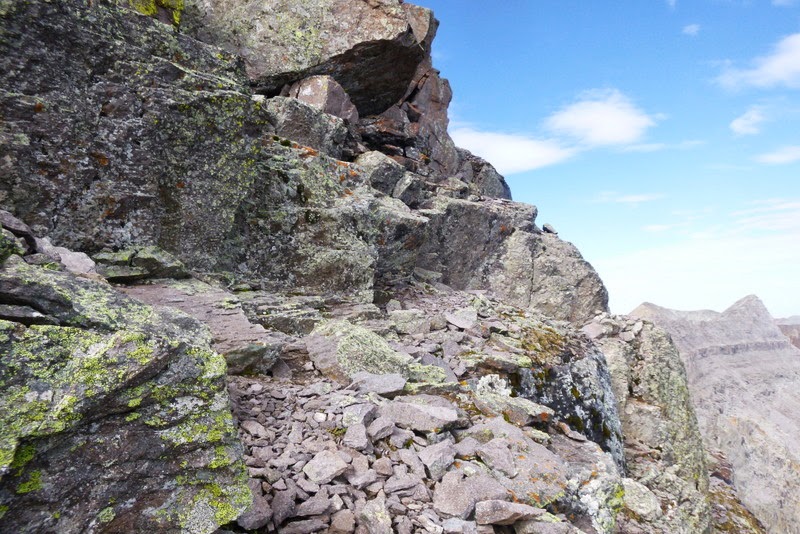
At least the views were still holding up.
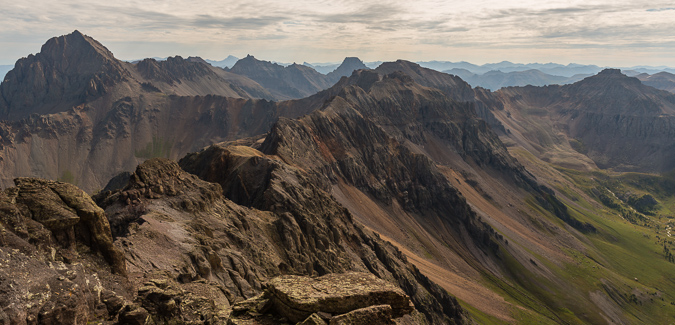
We found it difficult to find the summit pitch, but some sleuthing by yours truly discovered a dirt gully leading up to a ledge which was at the base of the summit pitch, which looked quite challenging. Rick set-up his rope and got down to business as soon as Ben arrived to belay.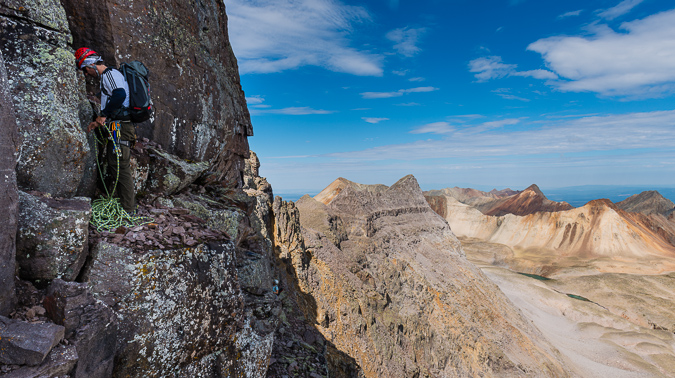
Here is another view of the dirt gully leading up to the summit pitch.
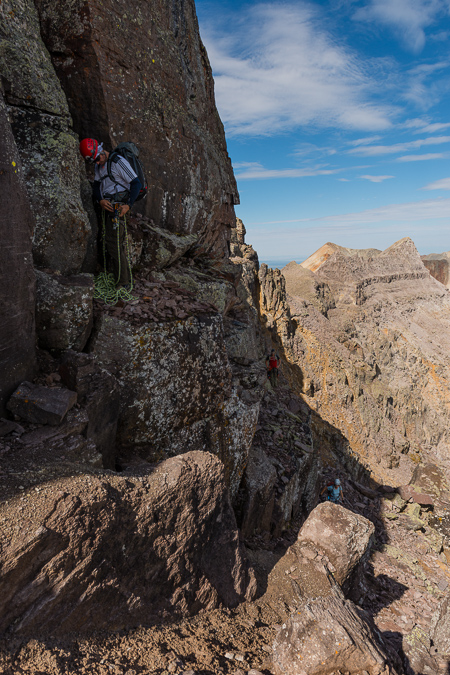
Rick placed only one cam for protection before reaching a belay ledge about 30 ft. above. Our route went right over the first boulder and then up to the right.
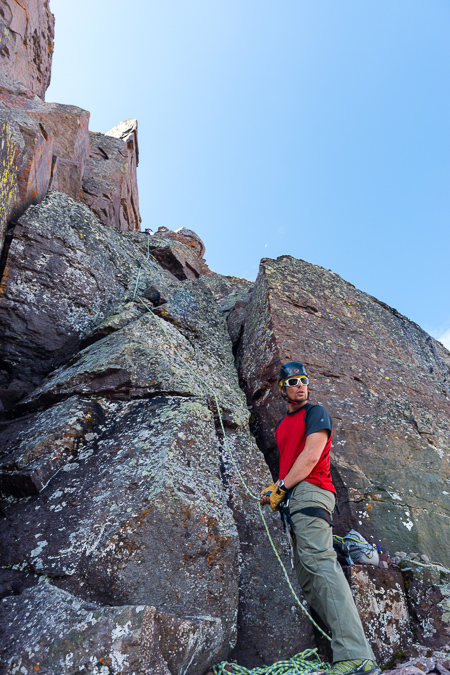
After watching Rick tear up the face to the belay station, I took one last look over at Sneffels and Blue Lake before mentally preparing for the ascent up the face. Rock climbing is not really my area of expertise, with only a few other forays into the alpine roped climbing arena in my past. Ben ensured I was tied in correctly and helped clean some mud off my boots.
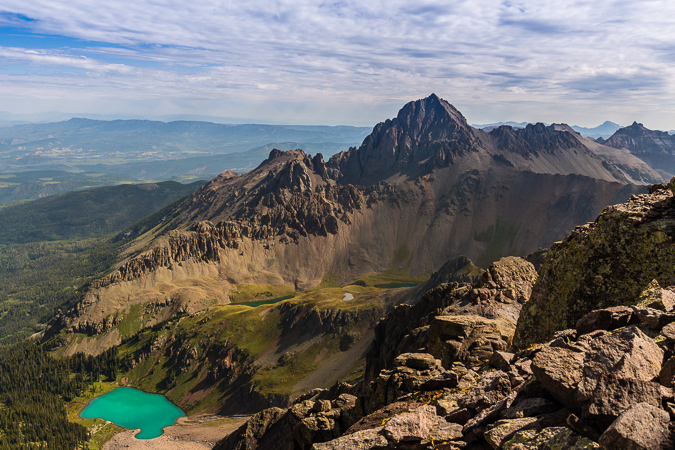
Natalie got one last photo of me before my first alpine ascent in several years. Adrenaline started pumping.
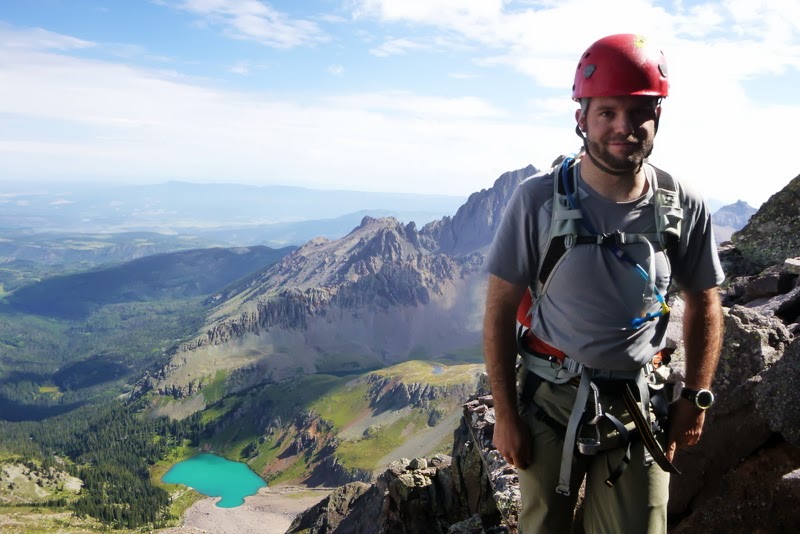
A look up revealed my route. Nothing too crazy, right? That's Rick perched up there with the white hat barely showing. Oh, and hey, an appearance by the moon.
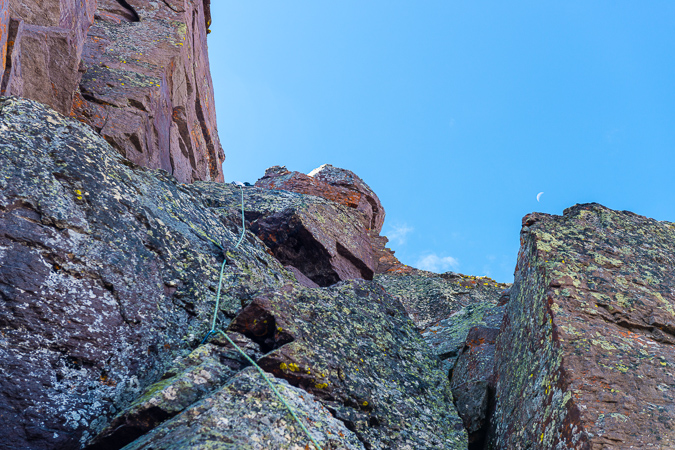
Up we go into the crazy class 5 crux. I found it pretty tough in muddy mountaineering boots, but managed to find some solid footholds with the help of Ben's finger pointing out some spots for me to try. Photo by Natalie.
A patient and watchful Rick watched from above. I'm not sure if I should be happy or disturbed he got photos of me while belaying. All is well that ends well. All joking aside, Rick was an awesome leader.
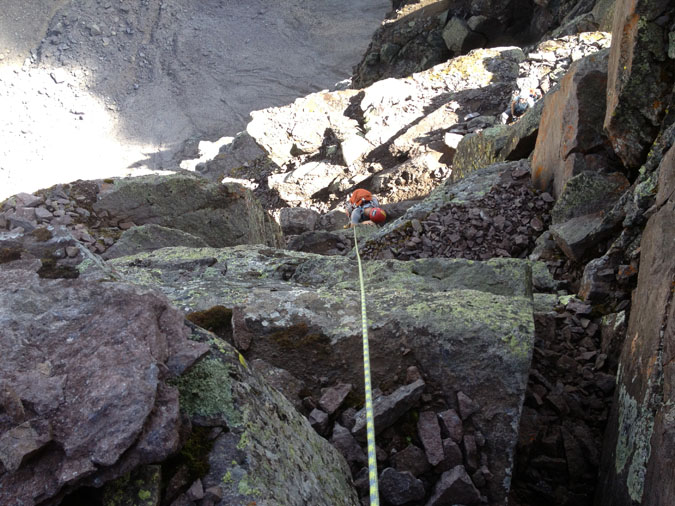
Once up the 1st big boulder, climibing became quite a bit easier.
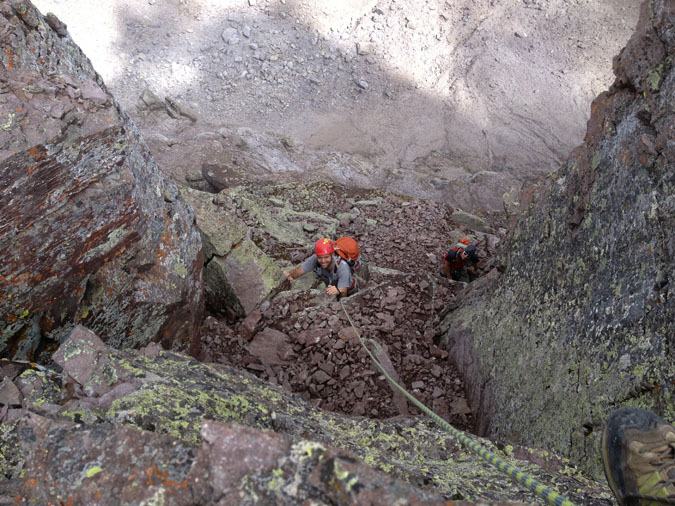
After I unclipped, Rick threw the rope down to Ben.
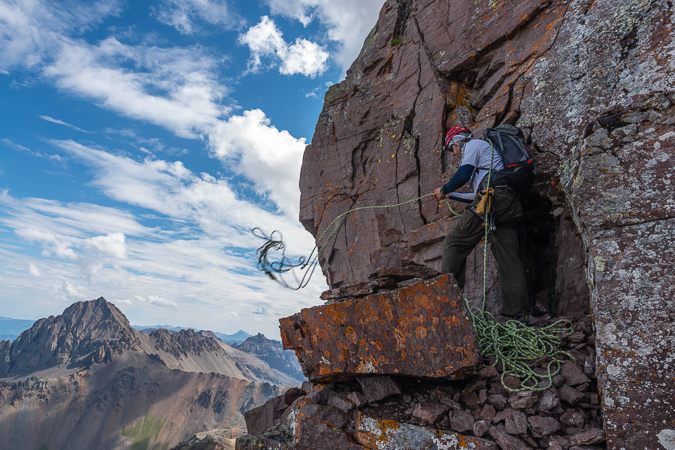
Ben topped out with ease and enjoyed the views of Sneffels while Natalie roped up.

Natalie made it up to the belay station without any issues and Rick continued up the route. We found the next section to be a bit easier.
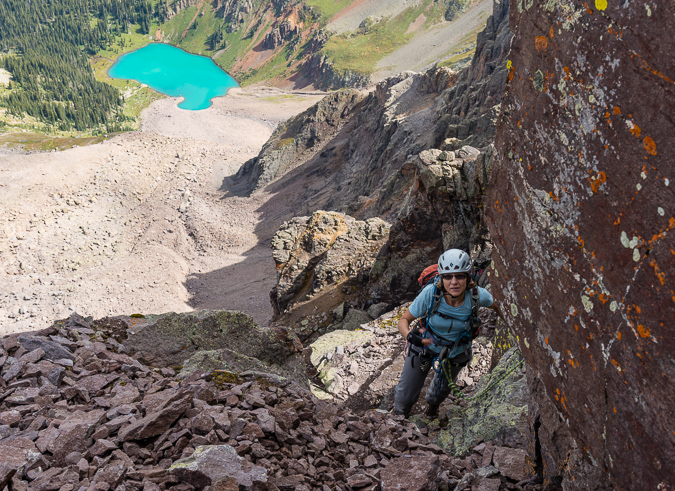
Rick went first and got to the top within about a minute. He setup a belay and I went 2nd, deciding to clip in for added security. The final section was exposed but there was a lot more handholds and footholds to choose from and it felt very low class 5, perhaps class 4. I reached the top of Dallas and was overwhelmed with joy. What an amazing climb! Natalie came next, and I was able to document her topping out beneath Rick's "meat anchor."
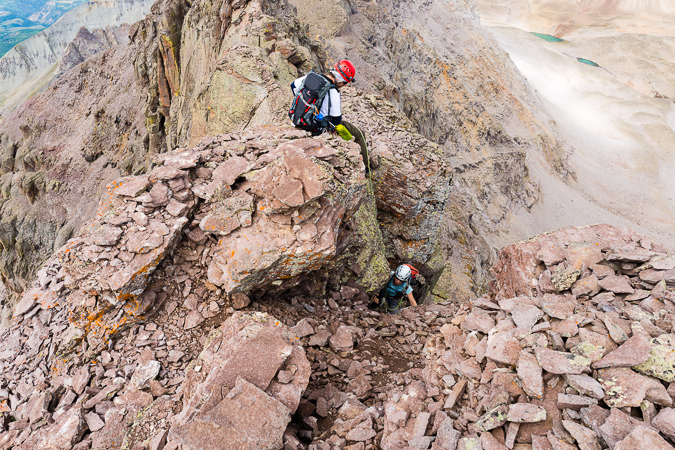
Natalie was just as excited to get to the top as I was.
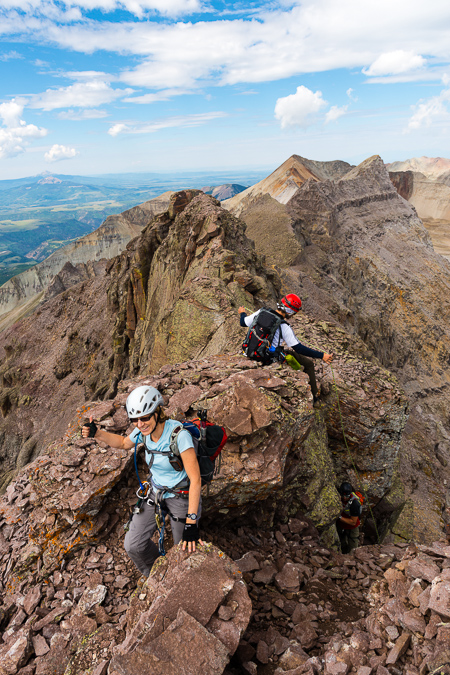
The views from Dallas were expansive and incredible. Blue Lake was awash in light. This panorama is pretty huge. In the full resolution version, you can see all of the buildings at Telluride and make out people on top of Sneffels. Click on it to go to my photography gallery.
I was all smiles on top of the world. Only 18 more Centennials to go!
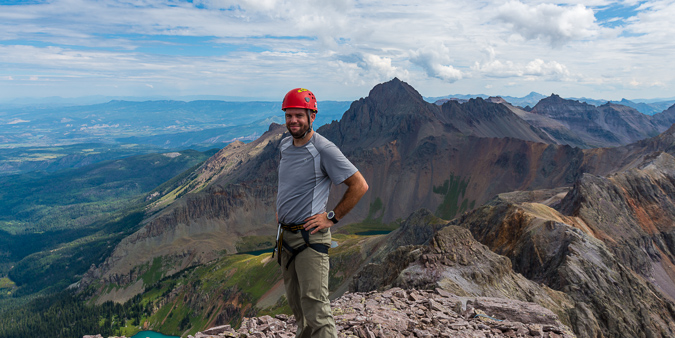
Natalie got a great shot of me after I fired off my summit panorama.
After enjoying some lunch and watching the storms build to the west, we decided to get a group photo and prepare for the rappel off the top.
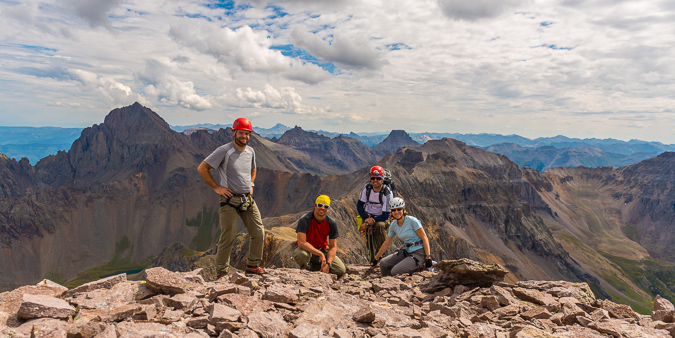
Rick set up the rappel and everyone gave me a needed refresher on rappelling. Rick went first and I went second. Setting up the rappel for this was a bit tricky. Natalie let me borrow some cord to anchor myself to the anchor and then I got onto the final ledge and roped up. We had about a 90 foot rappel off the west face of Dallas, which contained some interesting rappelling features. First of all, as soon as you step off the edge, the rock inverts and you're off to the races. Second of all, you have to aim for a hole between a giant car-sized chockstone below, about 60 ft down. Natalie got an awesome shot of me moving into the first part of the rappel.
I think the rappel was even more heart-pumping than the climb up. Don't get me wrong, I really enjoy rappelling, but it had been at least two years since my last rappel and I was hanging off the side of a huge mountain. Amazing stuff.
Once I popped through the hole below, I was ectatic. I photographed the others coming down through - here's Natalie.
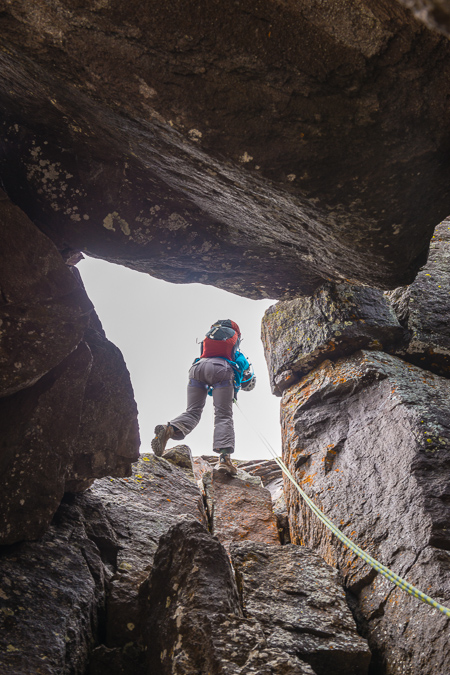
Our fearless leader awaited us below.
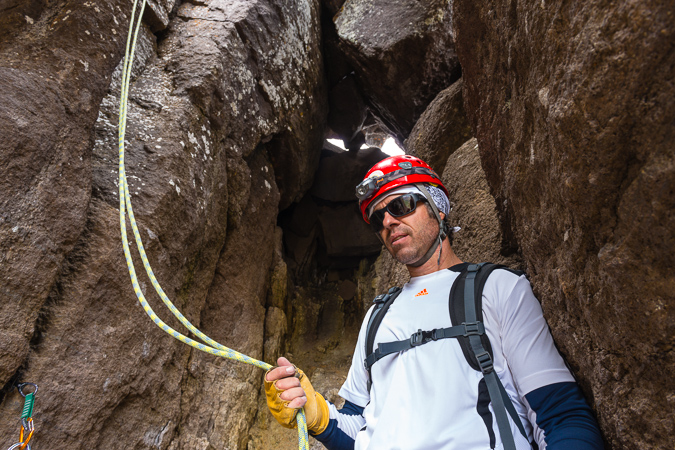
Another view of the hole we rappelled through, this time Ben coming down.
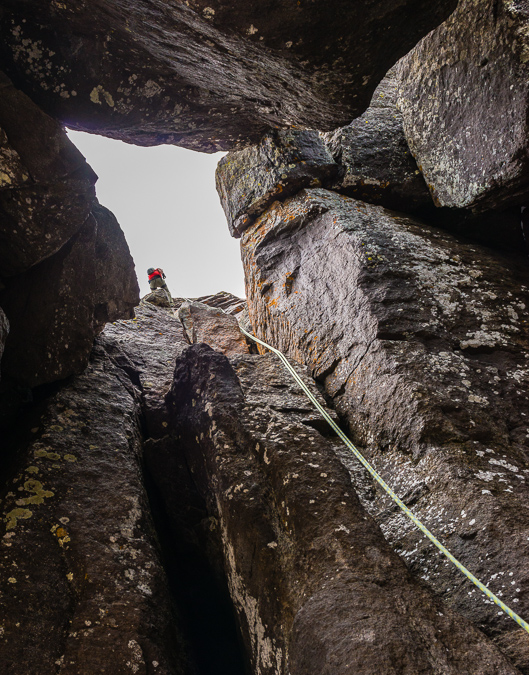
After the rappel, we head down pretty fast. I took a nice tumble on the class 3 section on the south slopes and got a few cuts, nothing too crazy. We made it down to tree-line just as rain began to move in.
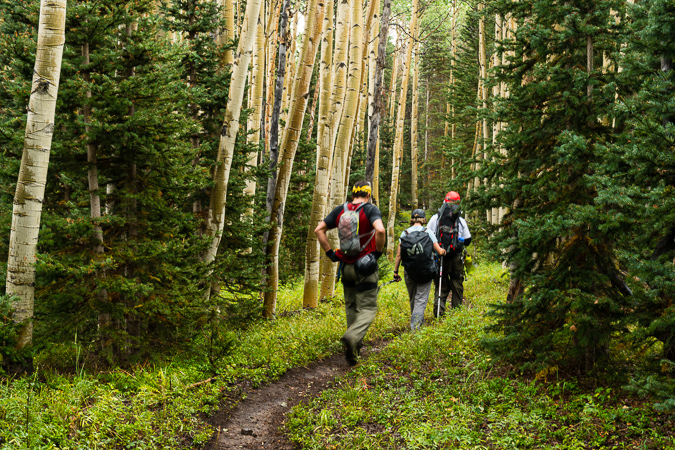
We reached the infamous meadow that Roach refers to and I decided to get a parting shot of Dallas above.
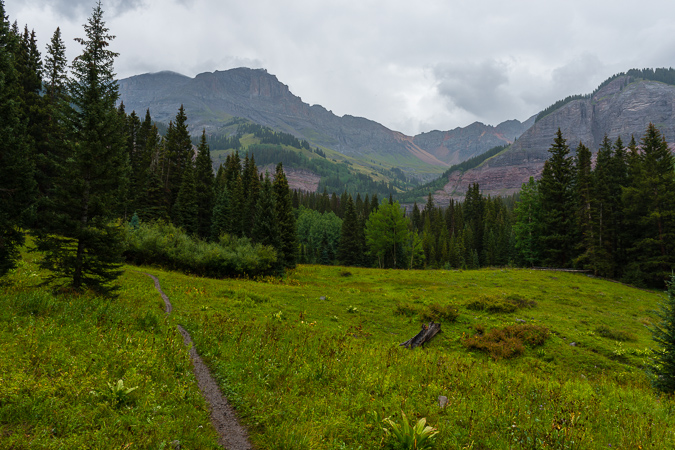
Back at the parking lot, we conspired for our plan of attack on Teakettle for the following day.
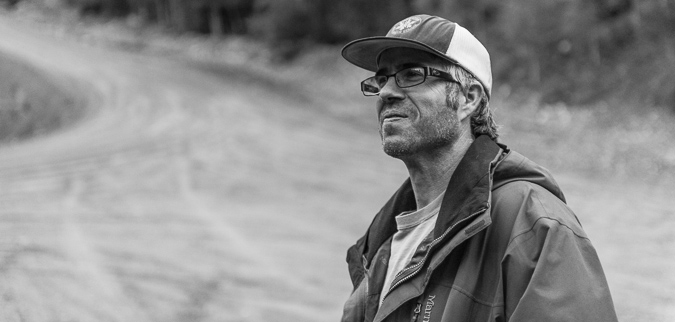
Overall, I would rate Dallas Peak as one of the hardest Centennials (highest 100 mountains in Colorado). The long, steep approach coupled with the challenging route-finding and intense class 5 climbing as well as the bomber rappel make this one of the most demanding peaks in Colorado. So far, I think Dallas would be rated as the hardest mountain I've climbed to date. As far as route-finding goes, don't rely to heavily on Roach. We found his descriptions somewhat lacking, especially on the upper section of the route after the 1st crux. Study our photos carefully and you should have no problems finding your way if you should choose to attempt Dallas. I would highly encourage other climbers to use Natalie's GPX file and reference her trip report as well. Here's a map and a rough hand-drawn route to reference as well.

For more information on travel and lodging in and around Telluride, check out this site, full of great information.
Lastly, I want to thank my amazing climbing partners, Rick, Natalie and Ben. These three were amazing to climb with and I could not be more happy with how our climb went. Next up, Teakettle...
Mount Sneffels - A taste of the Southwest Ridge
I've had my eye on Mount Sneffels for quite some time. This gem of a mountain located near Ouray, CO, is one of the most splendid-looking mountains in all of Colorado. Sneffels first caught my attention back in February, when I snowshowed on Miller Mesa, to the North of Sneffels.
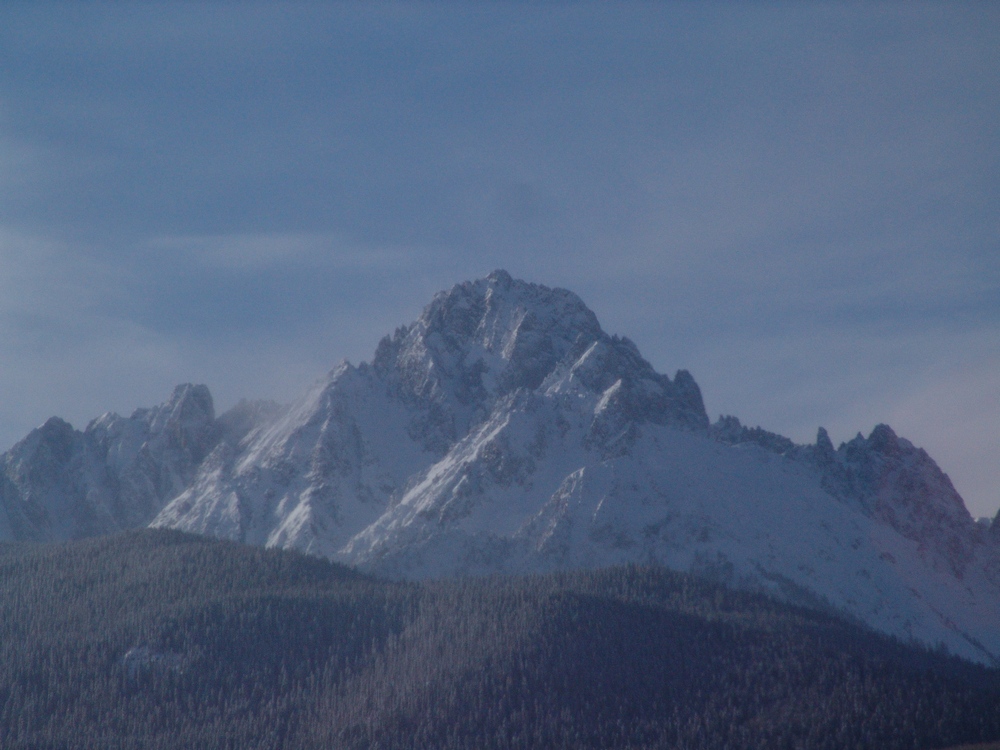
Mount Sneffels as seen in February, 2010.
Additionally, I was able to get great views of Sneffels and the surrounding rugged peaks back in June from the summit of Handies, and in July from the summits of Arrow and Vestal.
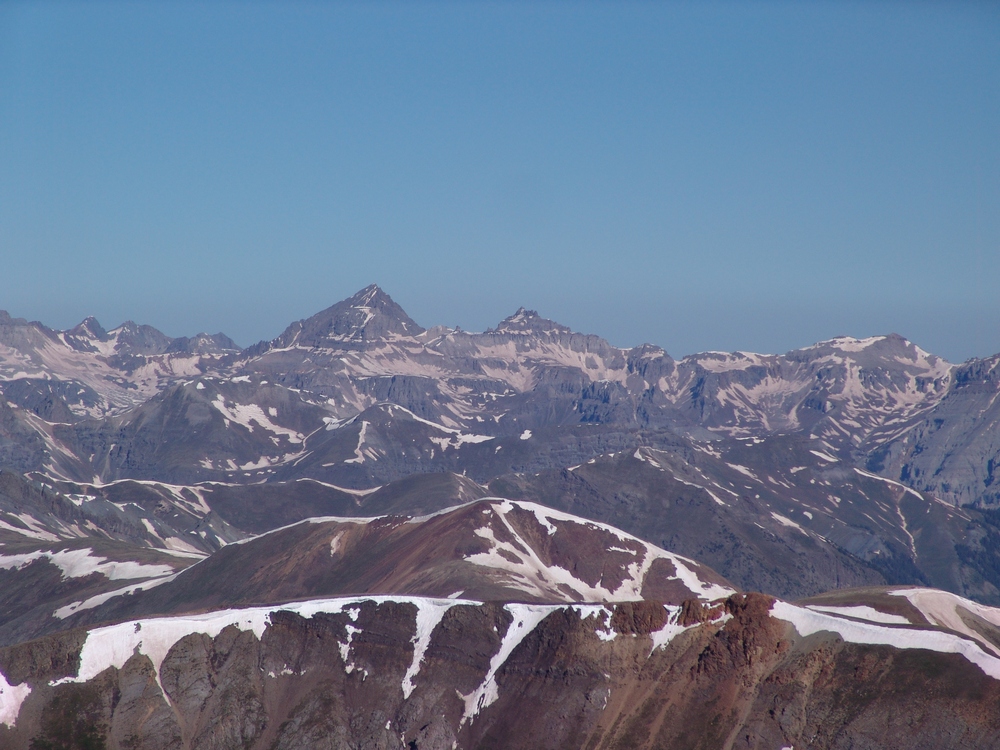
Sneffels and Teakettle as seen from Handies. Sneffels' pinnacles can barely be seen at the base of the Southwest ridge.
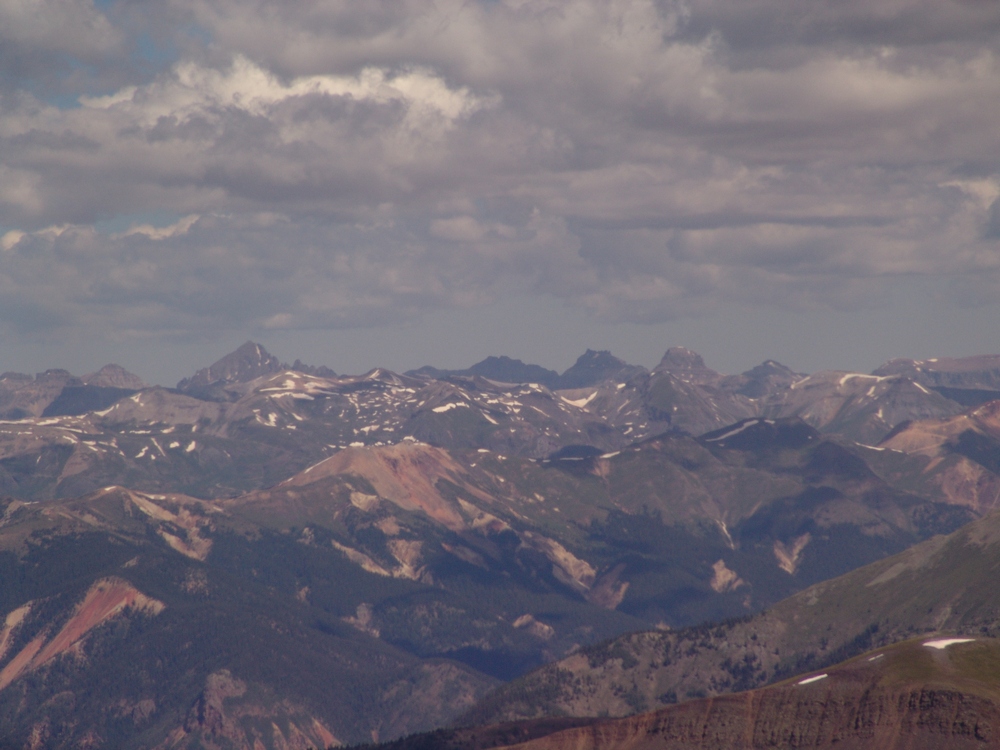
The Sneffels group as seen from Vestal.
The surrounding mountains are all very rugged, and access to the peak is accentuated by the well-traveled and world-famous Yankee Boy Basin.

The Sneffels "sub-range" (seen above) is probably the second most rugged group of mountains in all of Colorado, next to the Grenadier-Needle range. Sneffels is generally climbed via Yankee Boy Basin from the upper trailhead at 11,600 ft and up what is known as the Southeast Couloir route; however, for this trip, I'd had my mind set on the Southwest Ridge route of Sneffels, which follows the same basic start path of the standard route, but instead of going up the couloir, you gain the top of "Blue Lakes Pass" and then continue up the ridge to the top. In fact, the first recorded ascent of Sneffels, on September 10, 1874 (almost exactly 136 years before) was made by the Hayden Survey via the Southwest Ridge. The Hayden Survey had to "climb with care" because this route is "quite steep in some places."1
From Yankee Boy Basin, the Southwest Ridge looks to be unclimbable because of the jagged pinnacles, known as "The Hand." However, these are avoided by going up the back side of the pinnacles and up a series of steep gullies to gain the ridge, and eventually the top of Sneffels.
Here are some meaningful statistics from this adventure:
Peak summited:
Mount Sneffels: 14,150 ft. (ranked 27th in Colorado)
Total elevation gain: 2,550 ft.
Total distance hiked: 3.86 miles
Total time hiking: 5.5 hours
Total photos taken: 330
Total distance driven: 620 miles
14er # 41 for me.
Joining me on this ascent of Sneffels was my wife's best friend's husband - Arron Shaver. Arron is not an experienced mountaineer by any stretch of the imagination; however, he is a very athletic and fit individual with a love for the outdoors. Arron and I made plans earlier in the summer to tackle Sneffels together in September, and when the week we had planned to climb it rolled around, I received a very prompt call from Arron and we finalized our plans. We left Colorado Springs on Friday night and arrived at Yankee Boy Basin at around 10:30 PM. The drive was made more interesting because the power steering of my Jeep had begun to fail on the way over. Fortunately, this did not prove to be a huge problem and we were able to make camp near where the road has a sign that indicates that "short wheel-base 4WD vehicles only past this point." Although my Jeep is very capable, I did not know what to expect up the road, and did not want to test my vehicle in the dark. We set the alarm for 5 AM and crashed very quickly.
When the alarm went off we were both amazed by the huge drop in temperature from the night before. I am guessing that we woke up to 25-30 degree temps in the morning. After a quick breakfast of oatmeal, we were off to the races. We continued up the road another mile to the end of the road and the start of the trailhead. I was not overly impressed with the difficulty of the road and in retrospect, I would have driven much further had I known it was not a very difficult road. Once at the trailhead, Arron and I were greeted there by a few other hikers, about 5 in total. We started up the trail and quickly reached the fork in the trail for the two different routes available from this trailhead: the Southwest Ridge route (Blue Lakes Pass) and the standard Southeast couiloir route (Mt. Sneffels trail). We broke to the left towards Blue Lakes Pass and watched as the rest of the hikers headed up the standard route. From this point until the summit, Arron and I did not see another person the rest of the ascent.
Our route up Mount Sneffels.
Views of the surrounding peaks were outstanding, right from the start. Teakettle Mountain, Gilpin Peak, and Potosi Peak were impressive. Having seen them all at a distance from many vantage points this summer, it was great seeing them up close and personal!
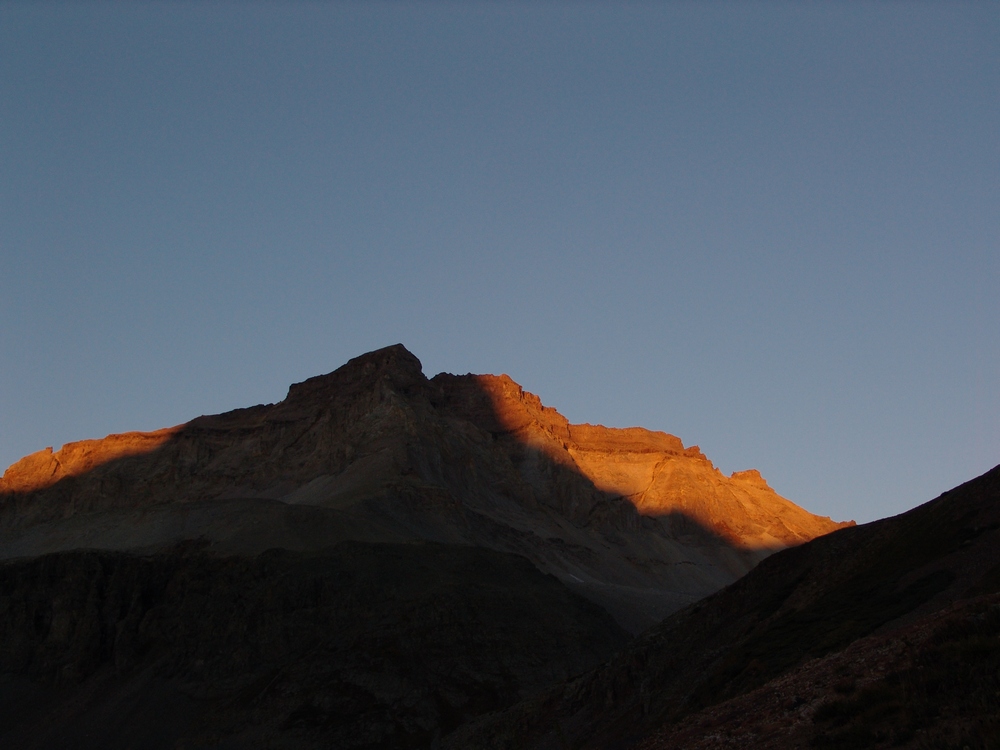
Gilpin Peak in alpenglow.
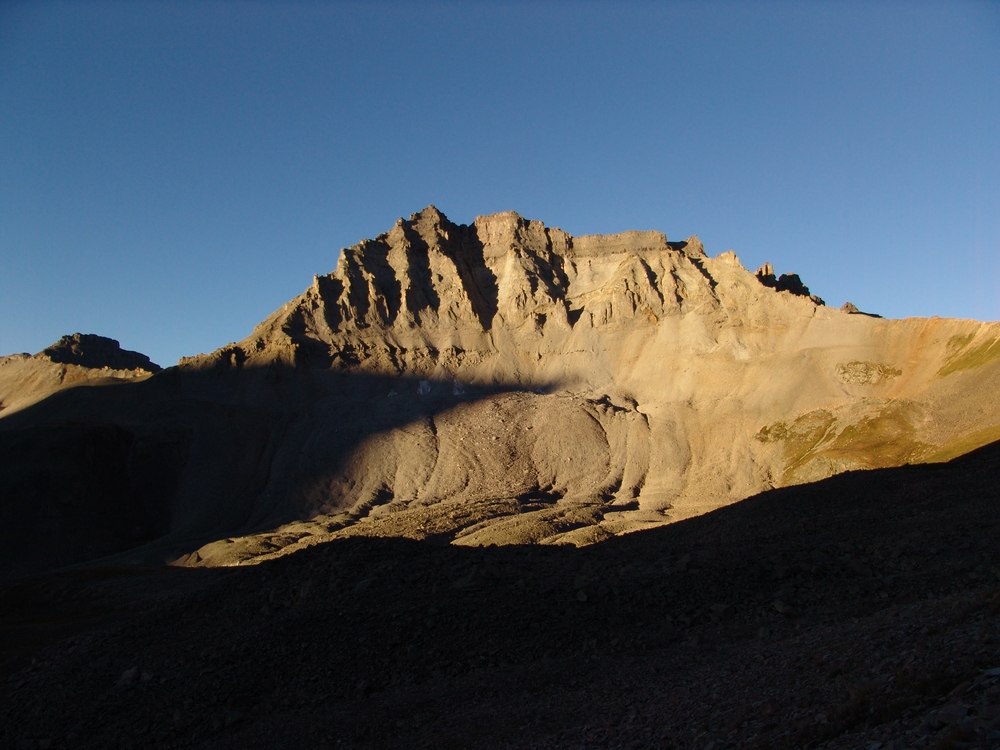
Gilpin Peak at sunrise.
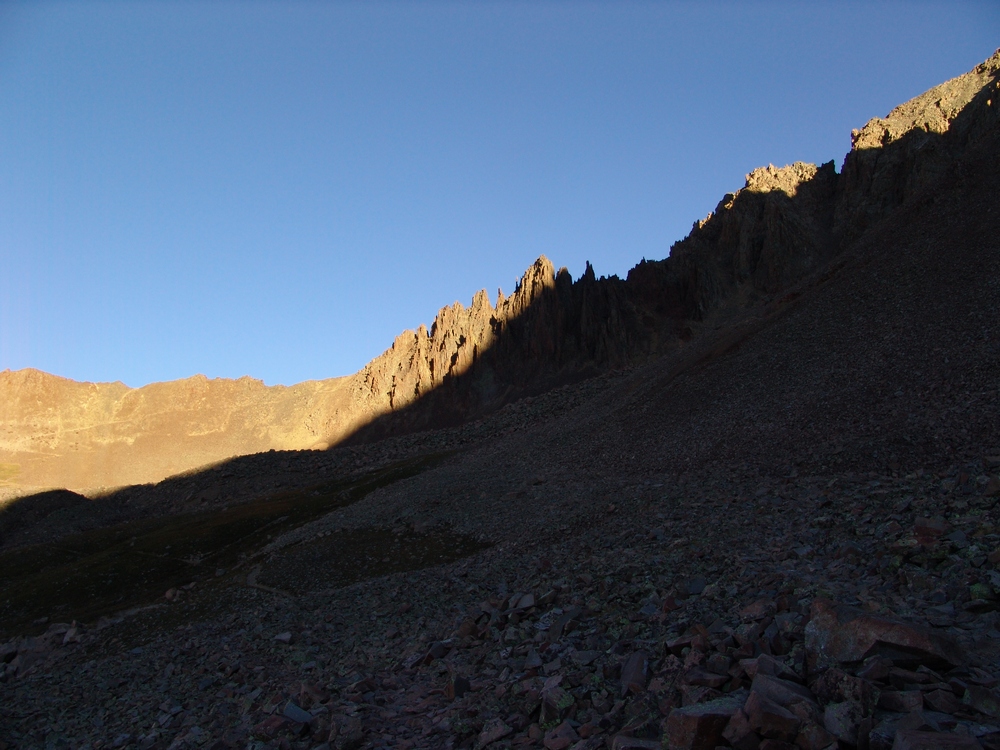
Sneffels' pinnacles.
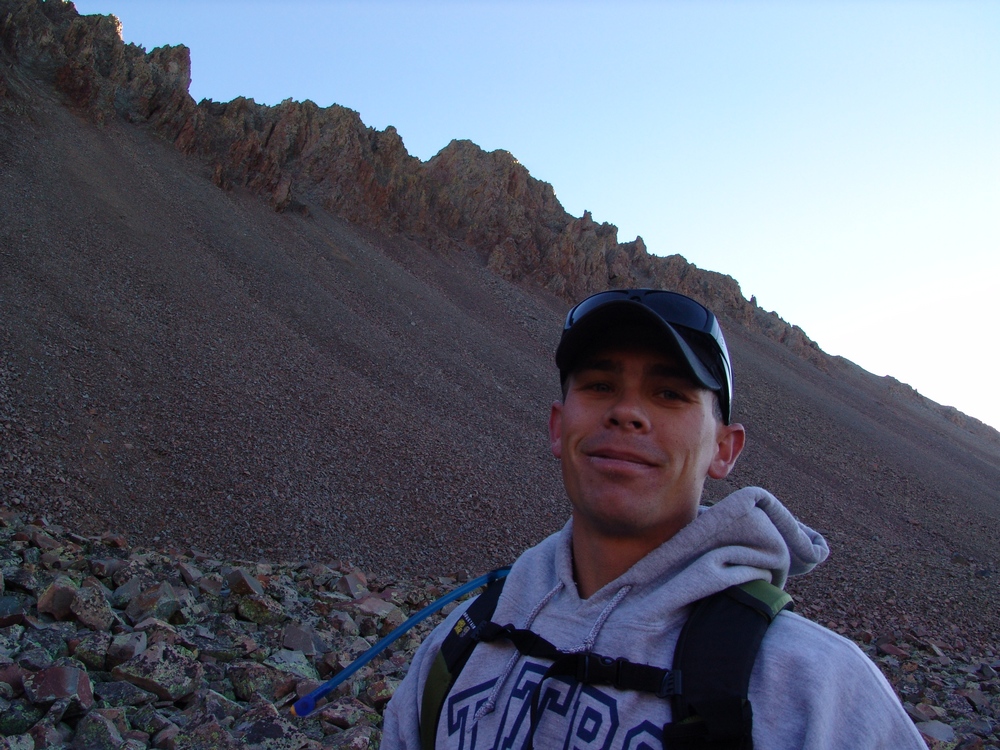
Arron Shaver - trusty hiking partner.
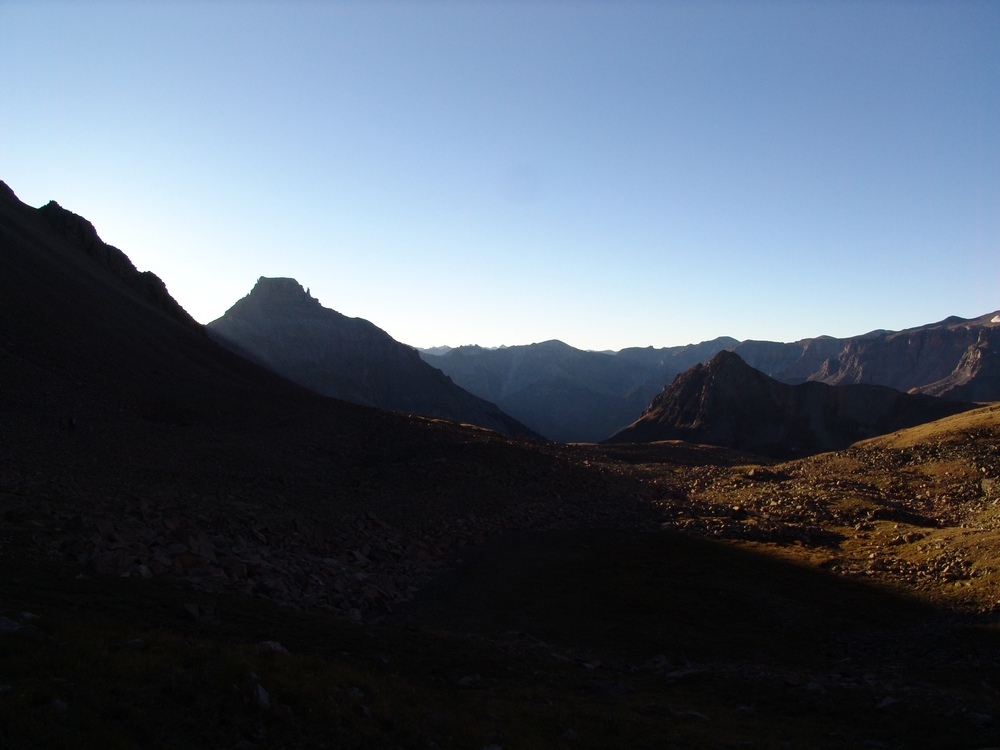
Potosi Peak.

Gilpin Peak in the early sun.
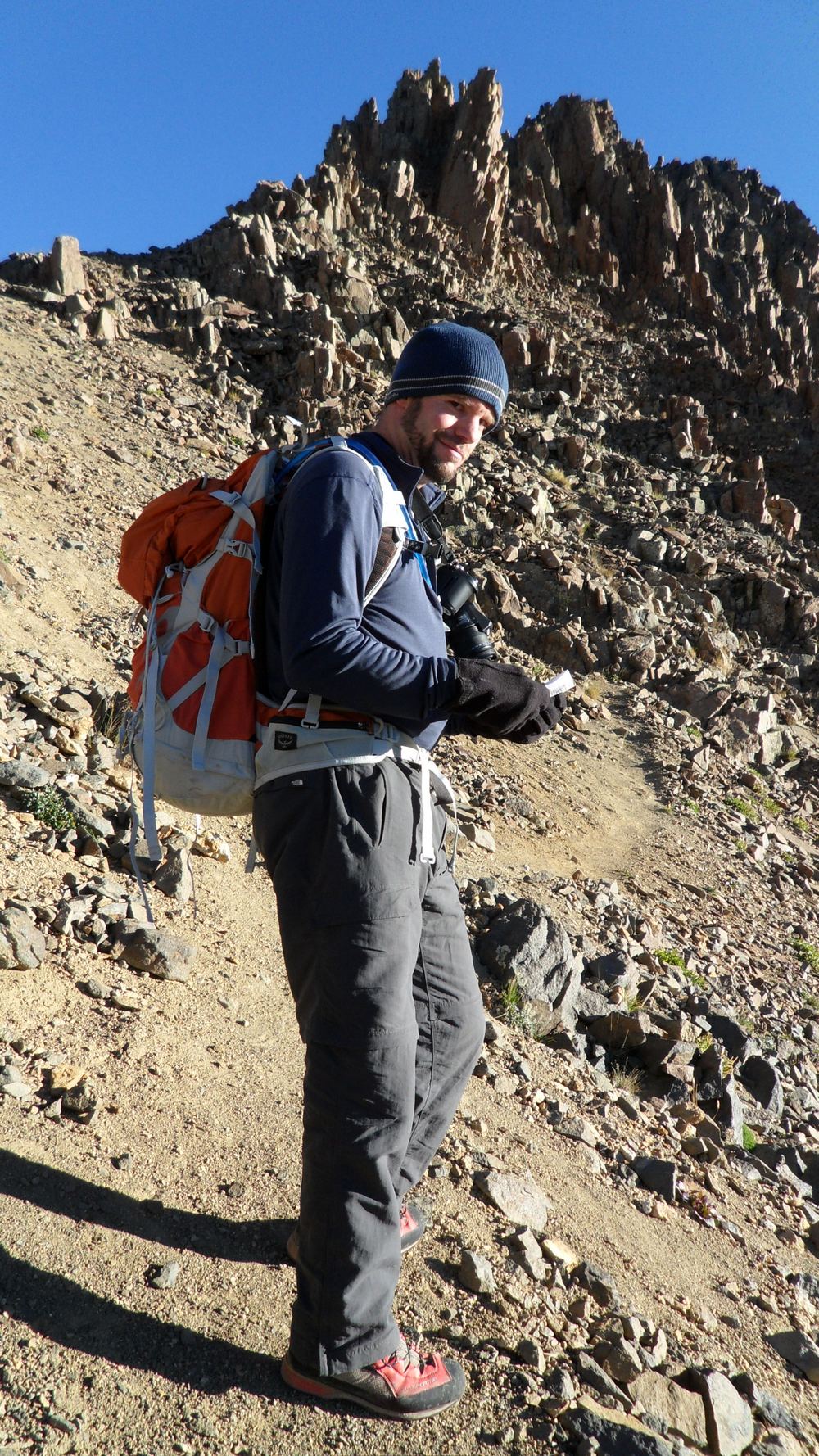
Matt Payne nearing the top of Blue Lakes Pass. The ruggedness of the pinnacles can be seen.
The hike up to Blue Lakes Pass was quick and painless, and before we knew it, we were enjoying intense views of Dallas Peak, West Dallas Peak and "T 0" after crossing into the Mount Sneffels Wilderness Area.

Blue Lakes Pass provided awesome views of Dallas Peak.
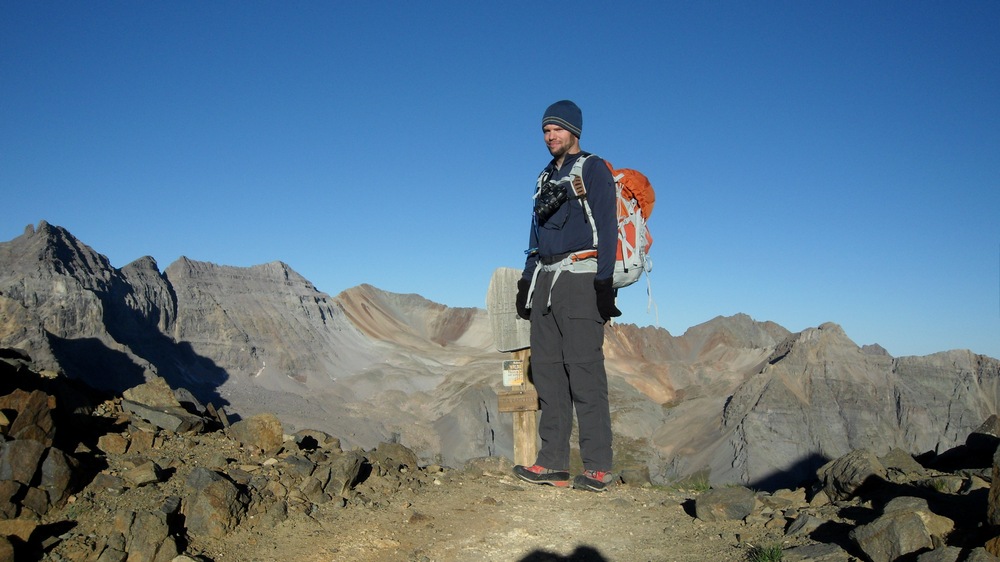
Matt Payne at the top of Blue Lakes Pass.
From the top of Blue Lakes Pass, the route heads directly behind the pinnacles and up a somewhat steep boulder field.
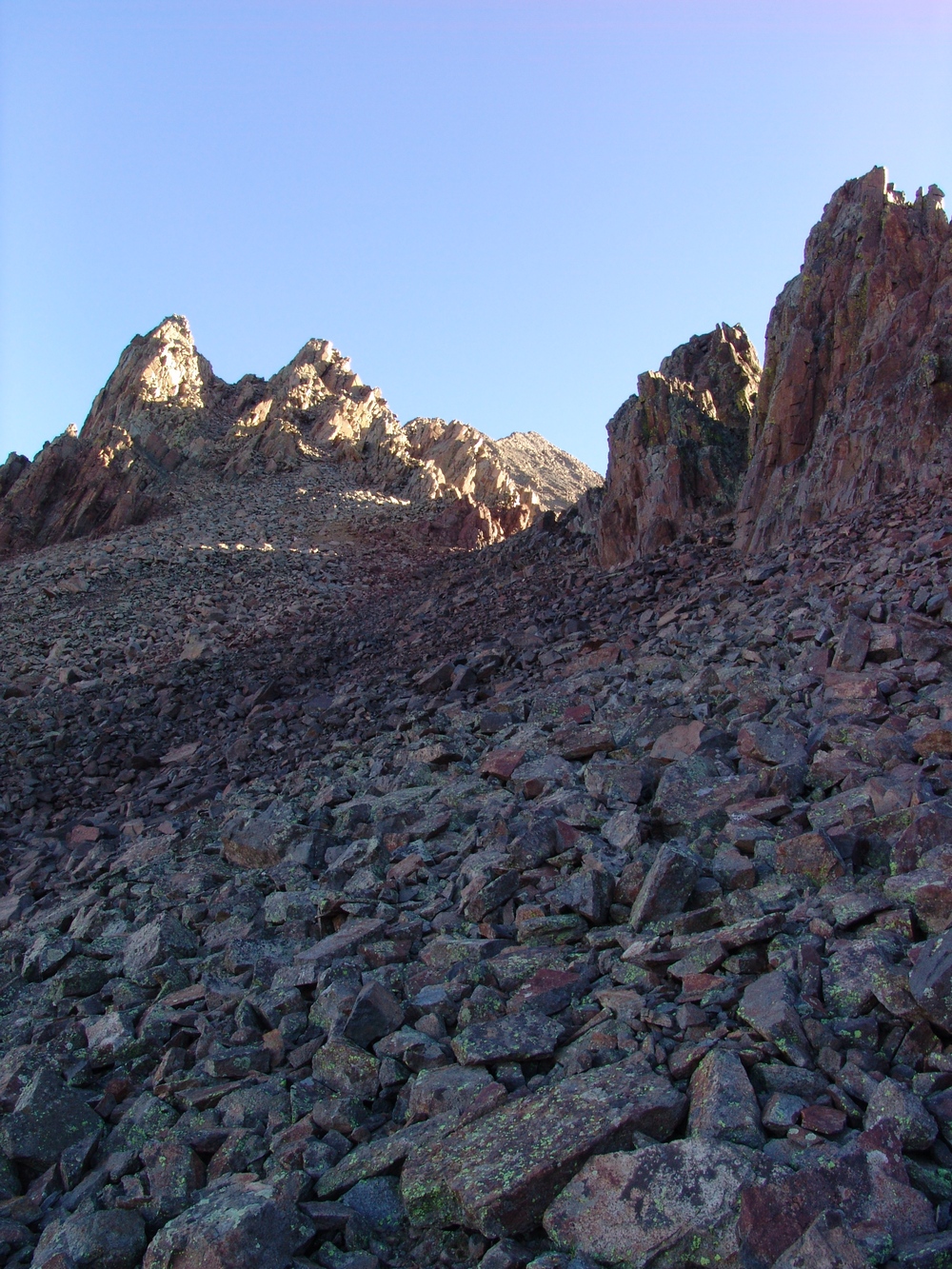
The backside of the pinnacles of Sneffels.
The trail here was fairly easy to find and the route seemed fairly self-explanatory - up! As the sun continued to rise, we could see the awesome Blue Lakes basin below Dallas Peak.
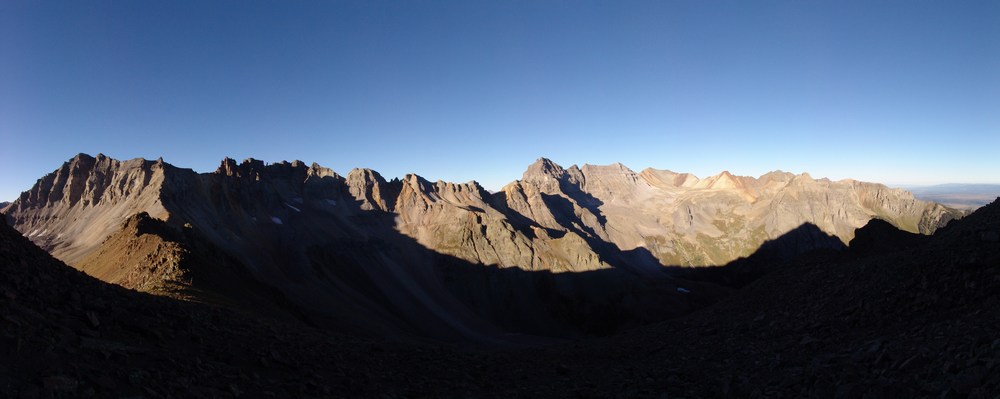
As we continued to climb up the gullies, Lizard Head finally came into view for the first time. Lizard Head is a tall spire near the Wilson group to the Southwest of Sneffels and is only climbed by experienced rock climbers, as the route up it is 5.8 on the YDS. For a great read on the Lizard Head approach and climb, see Sarah Thompson's site, 13ergirl.com.
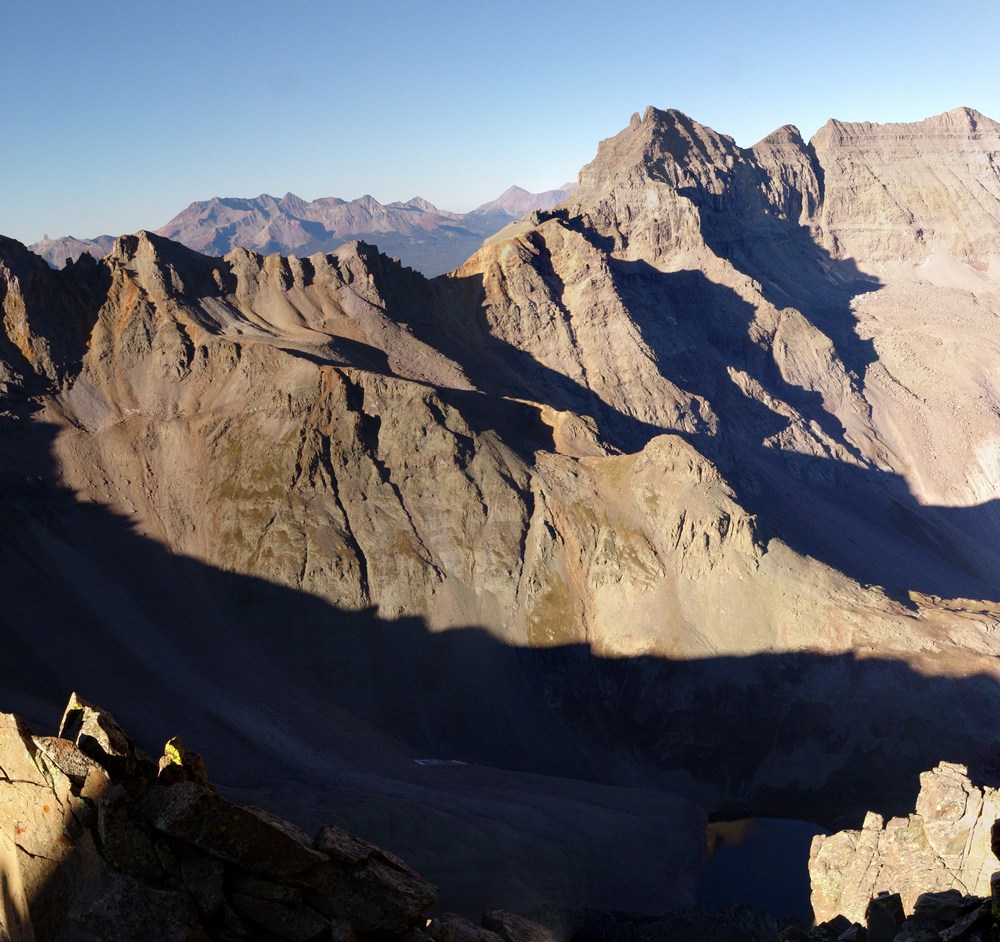
Lizard Head is barely seen at far left, with the Wilson group rising above the ridge between Dallas Peak and Gilpin Peak.
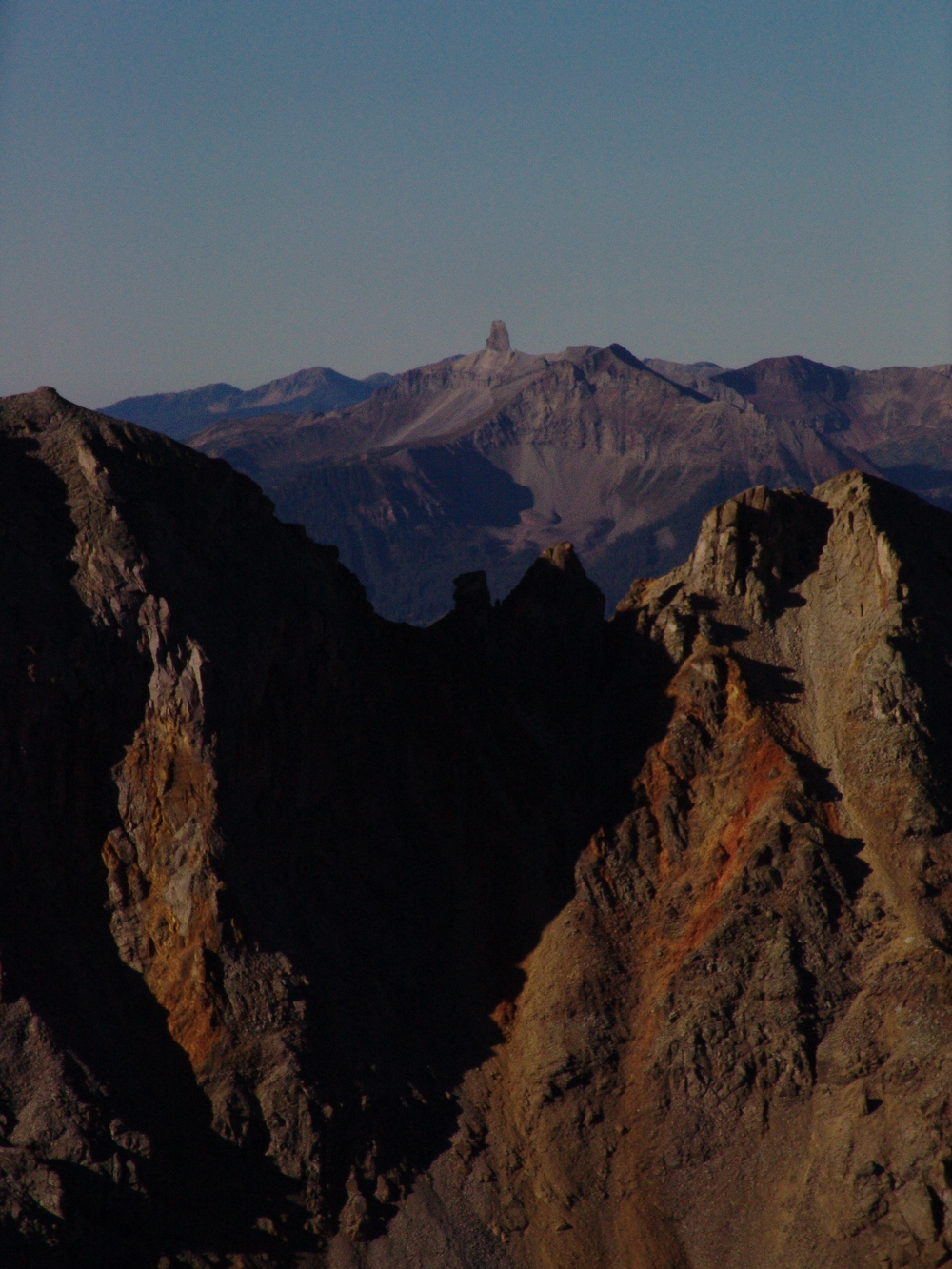
Lizard Head - zoomed-in.
As we continued to climb up the first gully on the Southwest ridge, we finally reached the top of the gully and were forced to down-climb to a ledge, which led us to the base of some class 4 sections just before the obviously last ridge section.
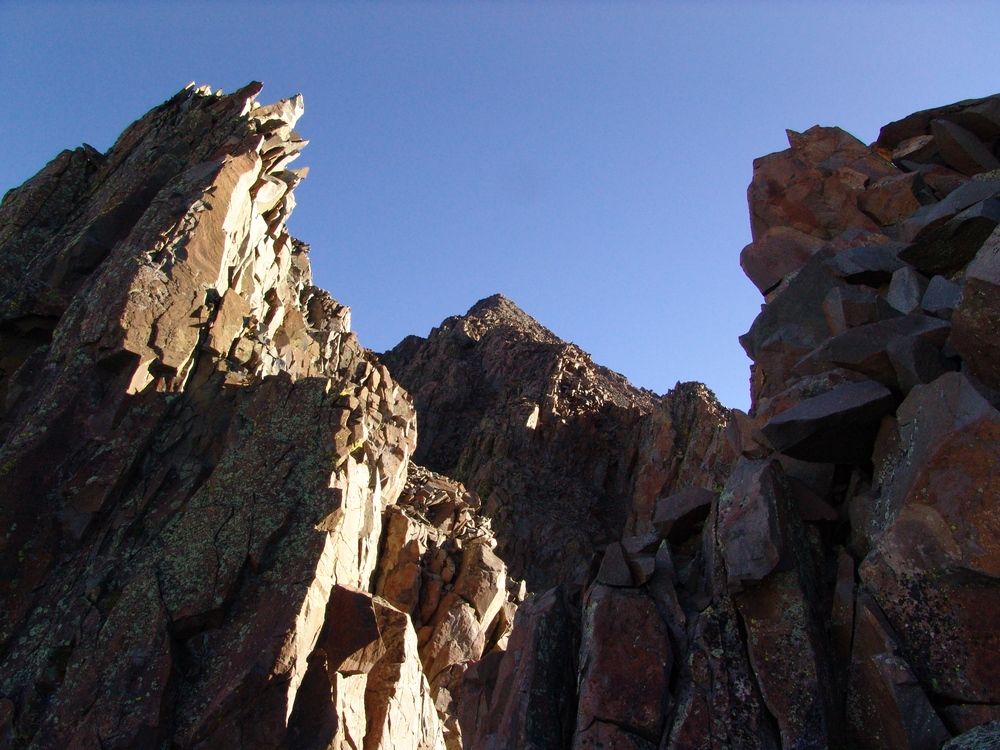
The terrain on the Southwest ridge was crumbly and jagged.
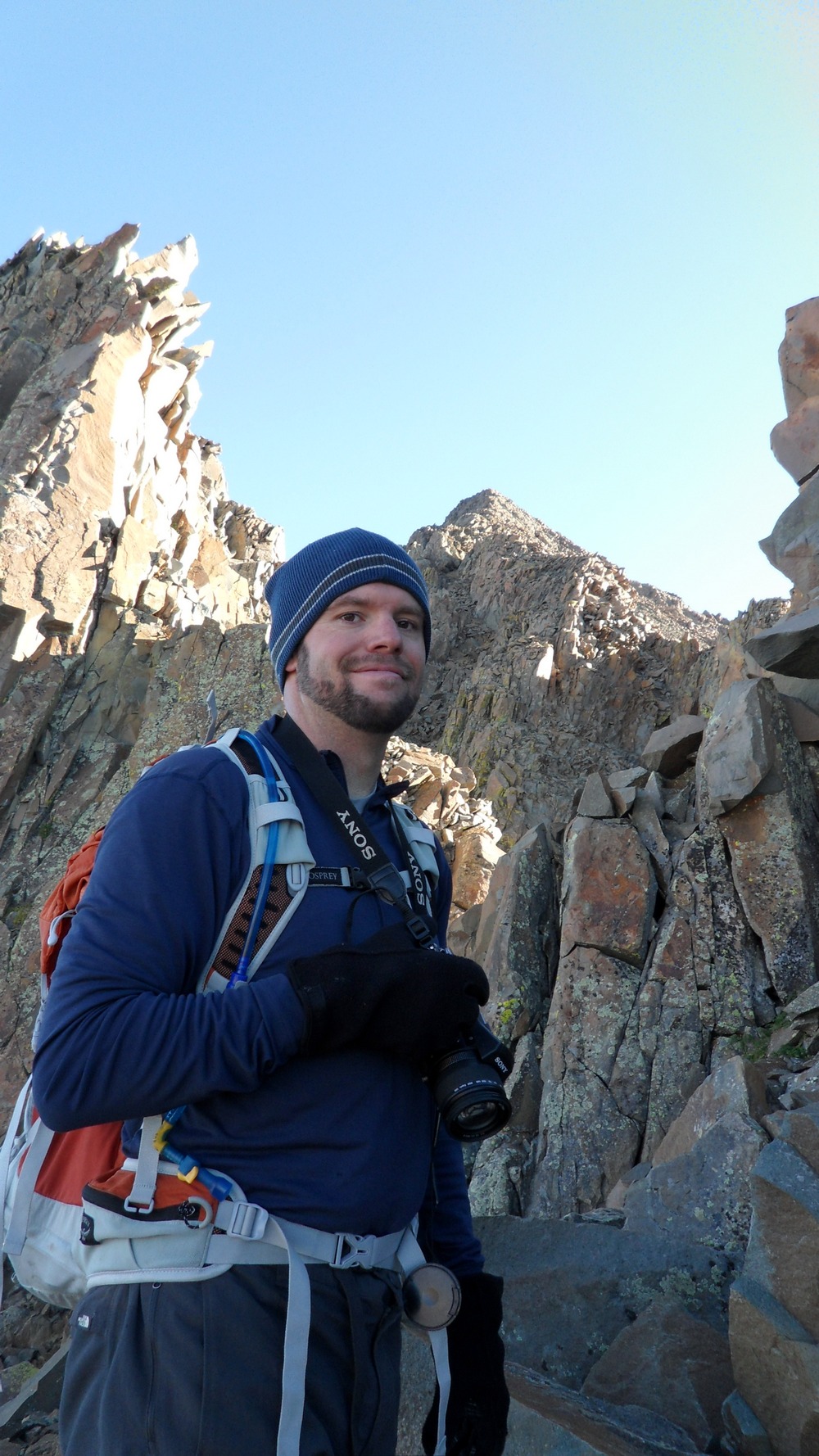
Matt Payne starting the Southwest Ridge of Sneffels.
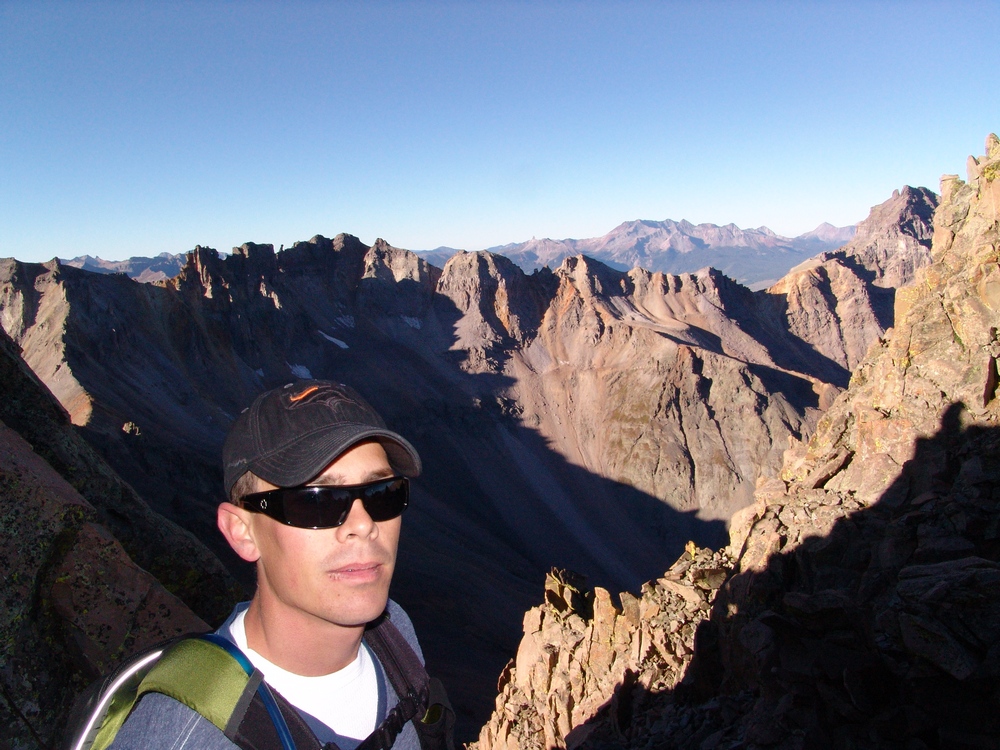
Arron Shaver on the Southwest Ridge of Sneffels.
The climbing up the ridge was quite enjoyable. The rock was quite solid, with ample hand-holds and foot-holds during the class 4 sections. Finally, Teakettle and Potosi came back into view, and they did not disappoint. Teakettle is one of the most appropriatly named mountains in Colorado. Shaped like an actual teakettle, sporting a spout and a handle - Teakettle is both a geologist's and a photographer's dream.

Teakettle Mountain is seen at far left, with it's handle represented as a large hole in the rock. Potosi Peak seen at far right.
I remember being very impressed by Teakettle, even as a child. My dad climbed Teakettle in the 1980's and this photo was taken of him inside the handle of the teakettle:
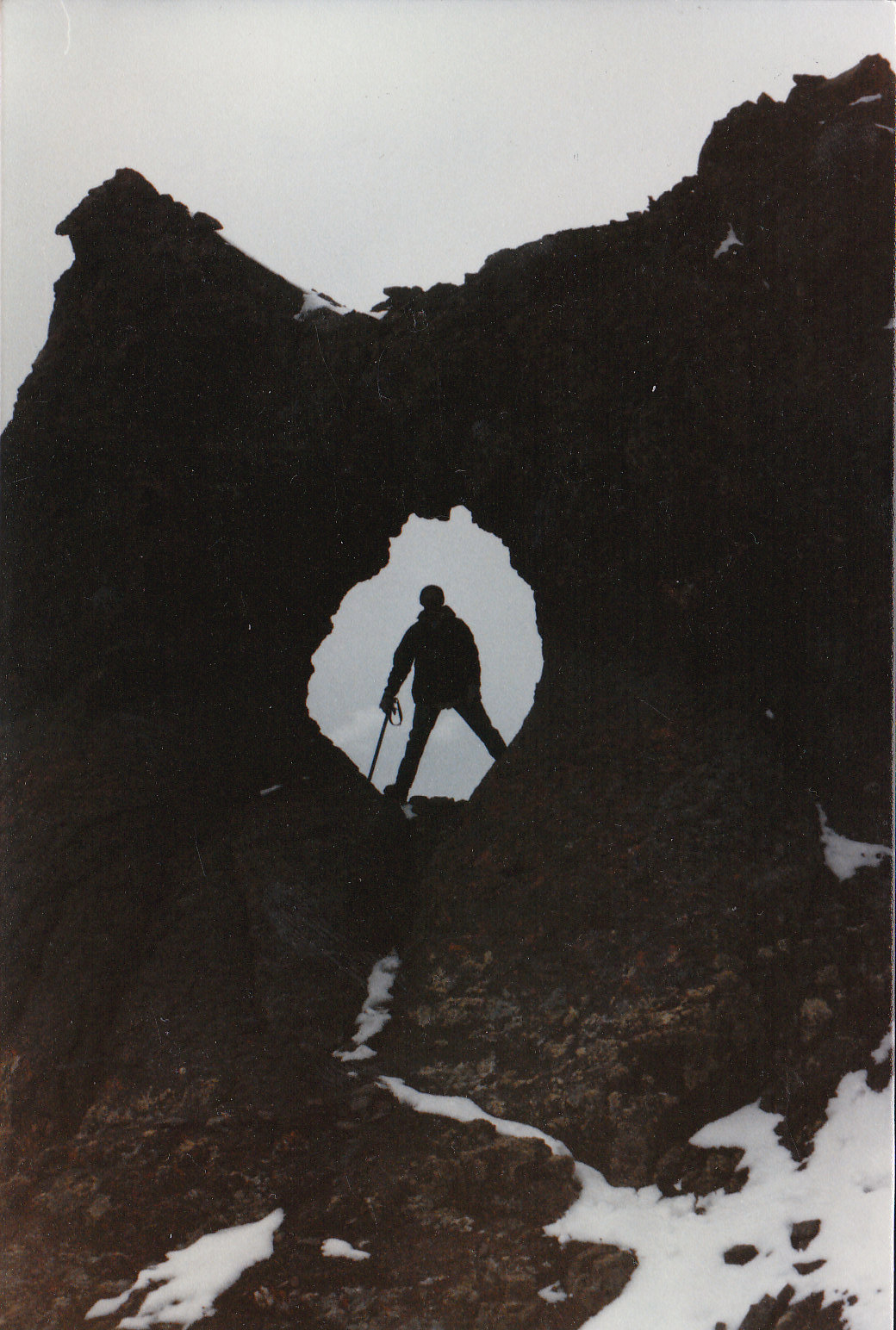
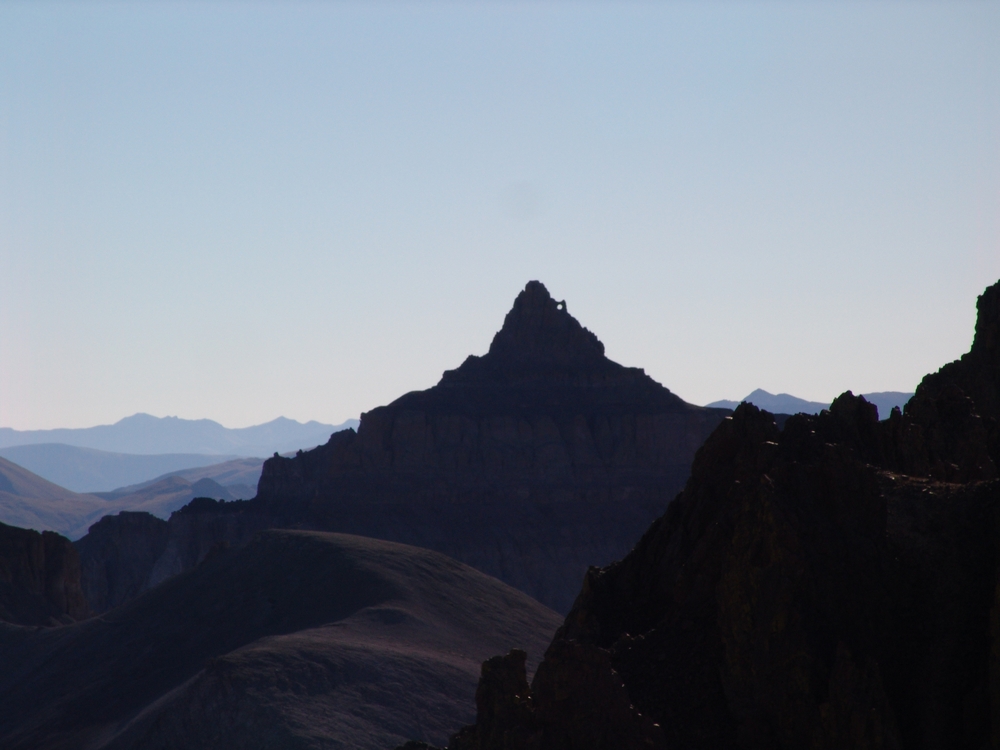
Teakettle Mountain, zoomed-in.
At this point, our views of Yankee Boy Basin below was quite impressive as well, with the golds, browns, yellows and greens of fall accentuating the pristine basin.
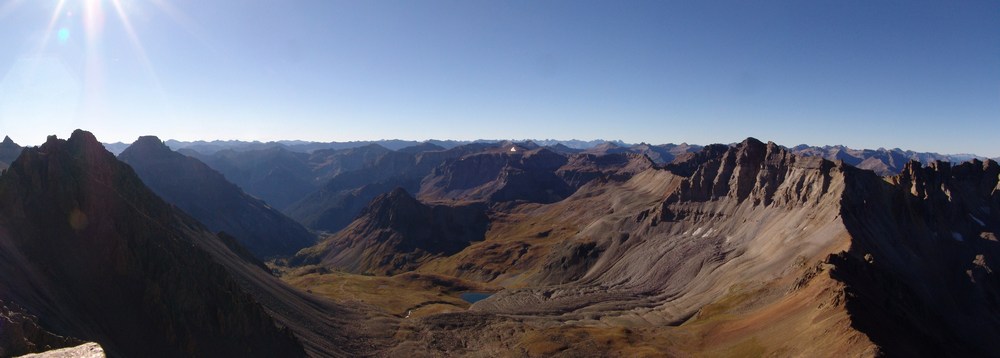
Yankee Boy Basin.
Looking in any direction, we could see some amazing peaks. Teakettle, Potosi, Gilpin, and Dallas made for quite the fall back-drop.

On the way up the ridge, we were able to find the Kissing Camels rock outcropping that is often described on route descriptions for Sneffels. The landmark is almost impossible to miss.
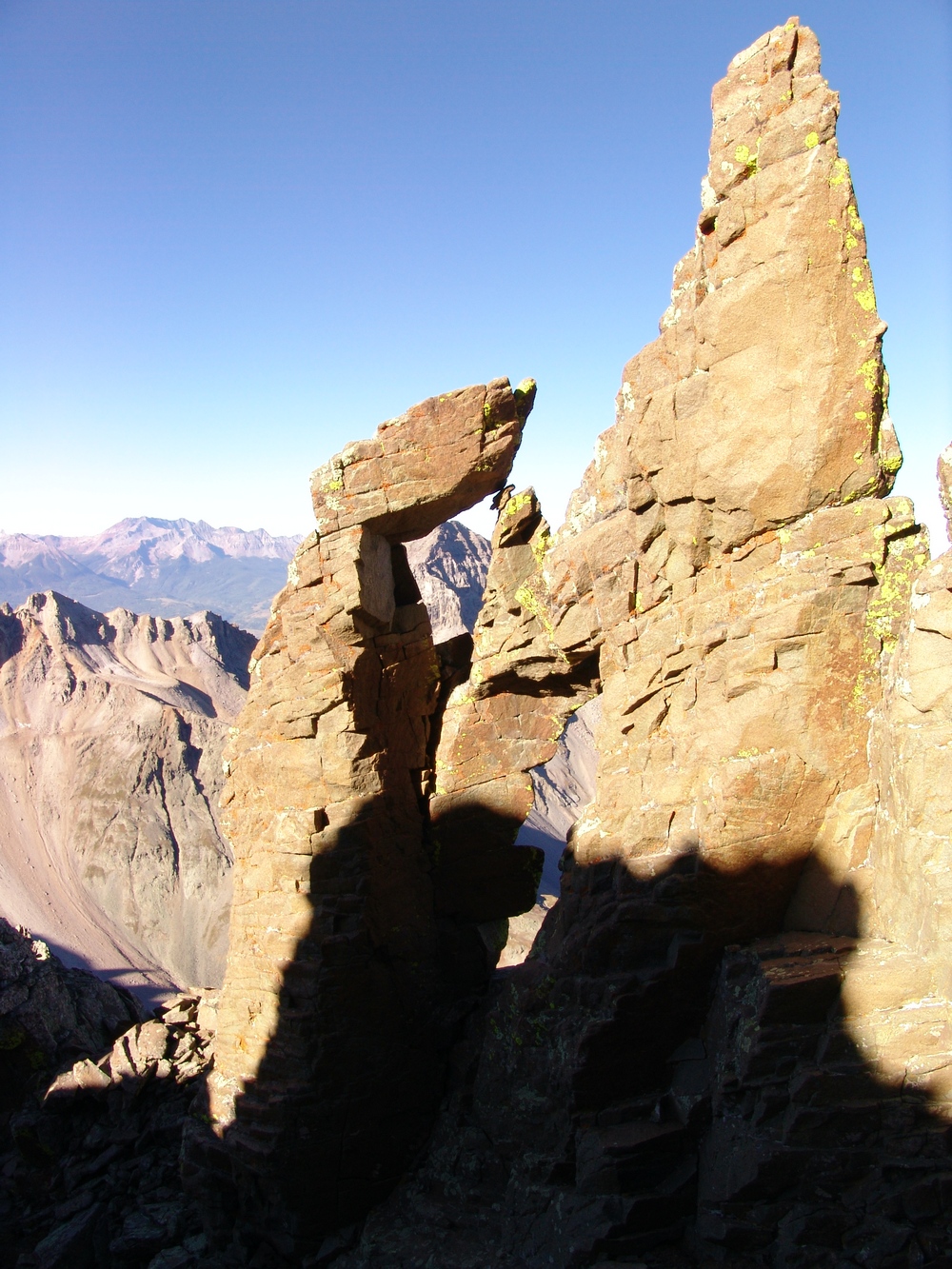
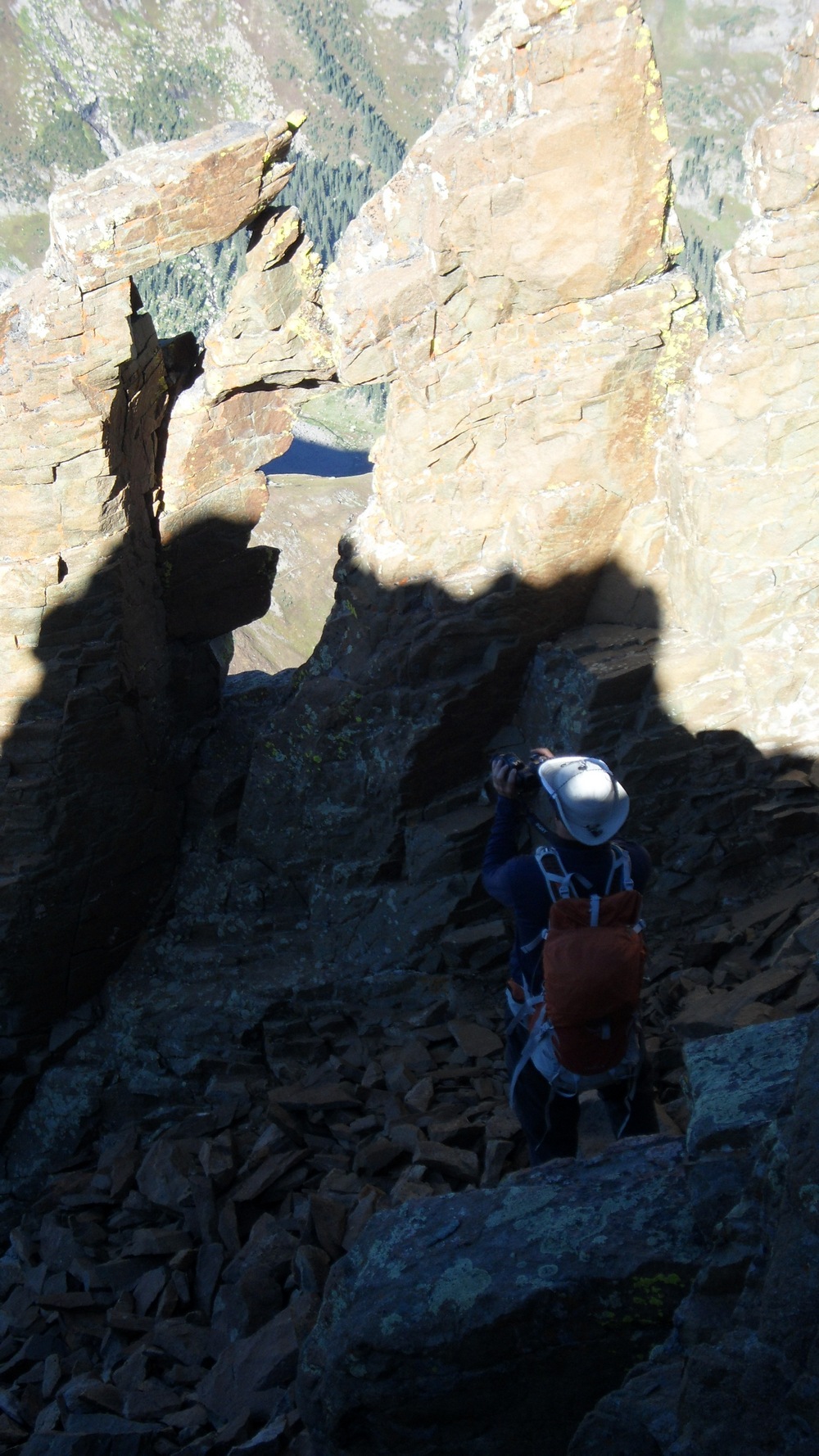
Dallas Peak can be seen through the Kissing Camels rock outcropping. Arron caught me in the act of taking that photo...
Yankee Boy Basin far below.
The climb from the Kissing Camels was very straight-forward - we continued up the steep ridge, appreciating the added difficulty and greater views of the Southwest Ridge route over the standard route.
Teakettle Mountain was difficult to keep from staring at. It truly is one of the more remarkable mountains I've seen. So remarkable, that I had to get a super-zoomed in view of it!
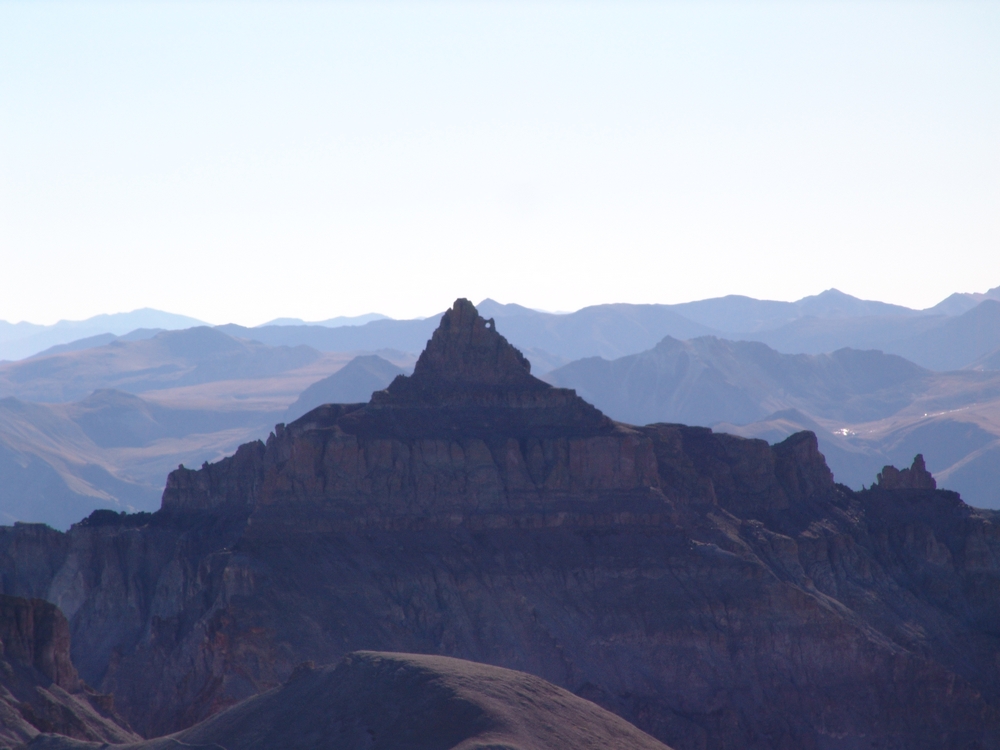
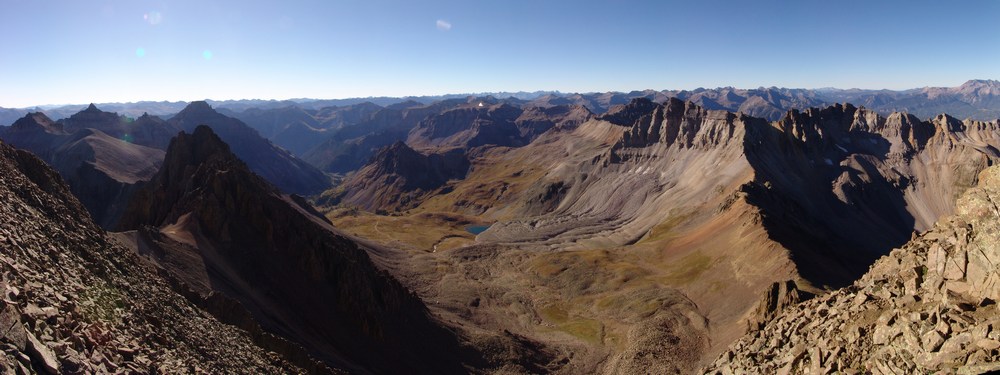
Arron was also excited about the route - being that Sneffels was his first 14er of his life - I think I may have spoiled him with one of the more fun routes of any 14er.
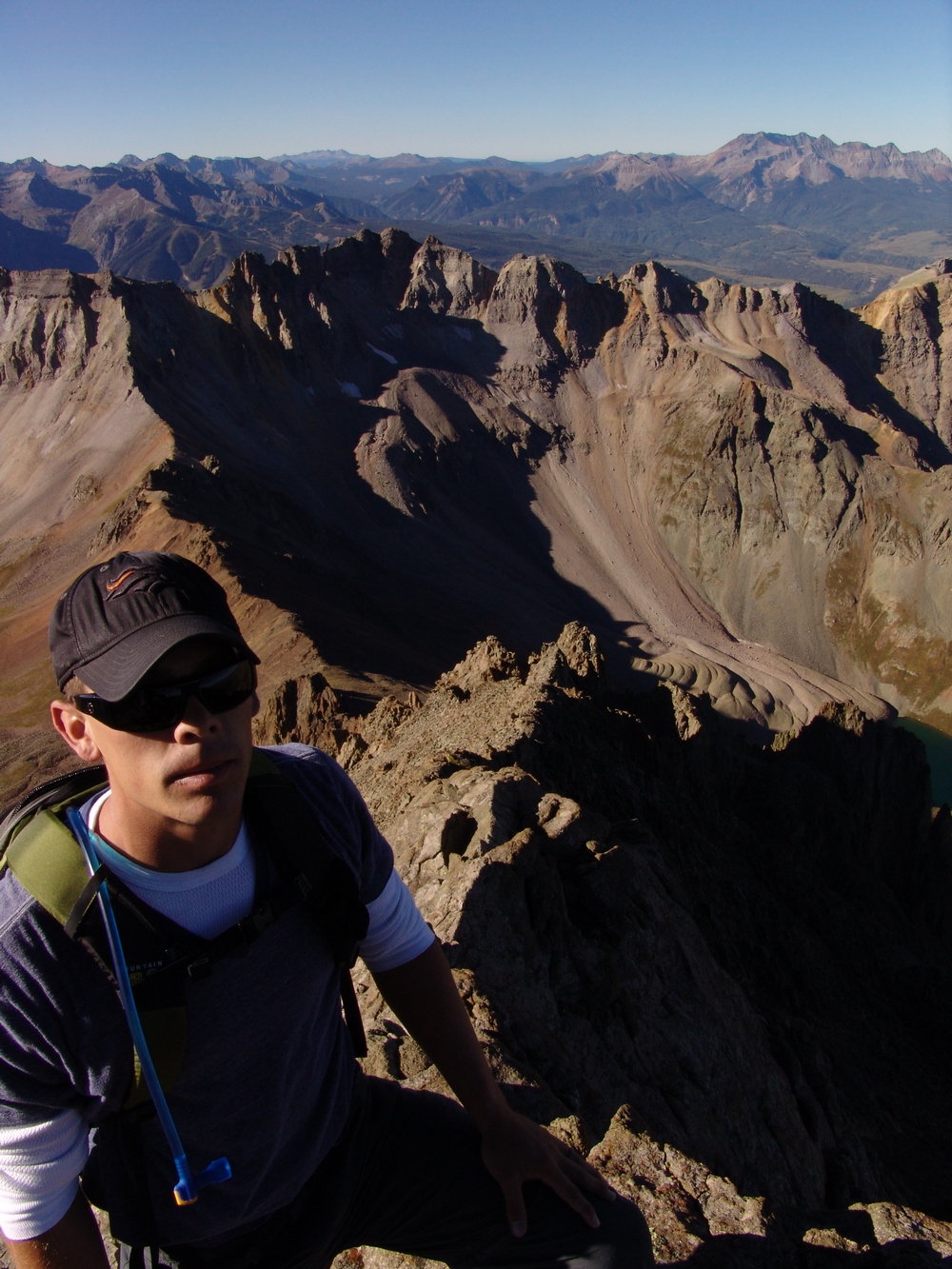
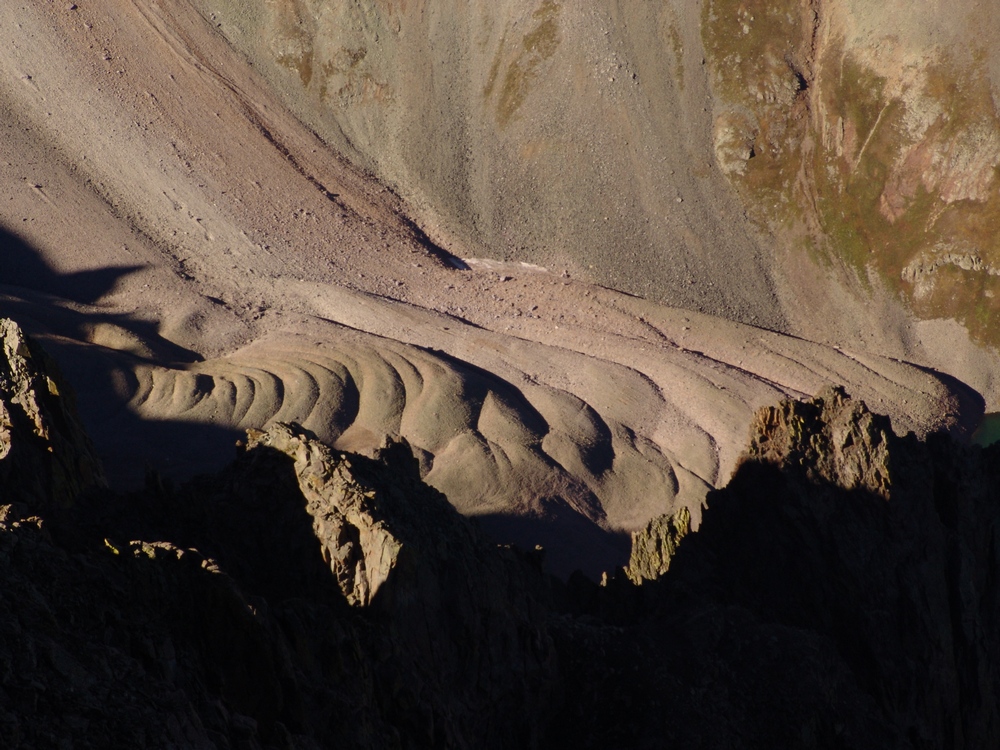
Arron with the ridge behind him. "Cake Batter" spills down the ridge between Dallas and Gilpin. (Zoomed in at right)
I suspect that the "cake batter" looking stuff is probably caused by mud slides during the monsoon seasons that often plague the San Juan Mountains.
We finally reached the summit just as the other group was reaching the top as well. The weather was perfect. No clouds. No wind. Warm. We could not have picked a better day to climb.
As usual, I took several photos from the summit and celebrated with the other climbers.

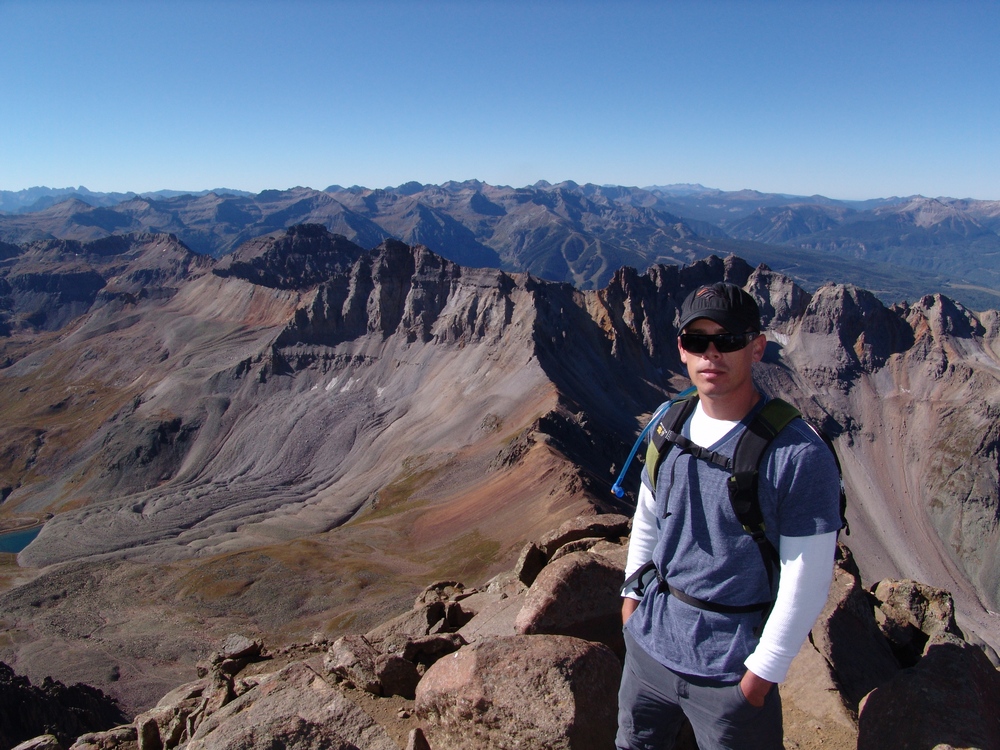
Arron's summit shot.
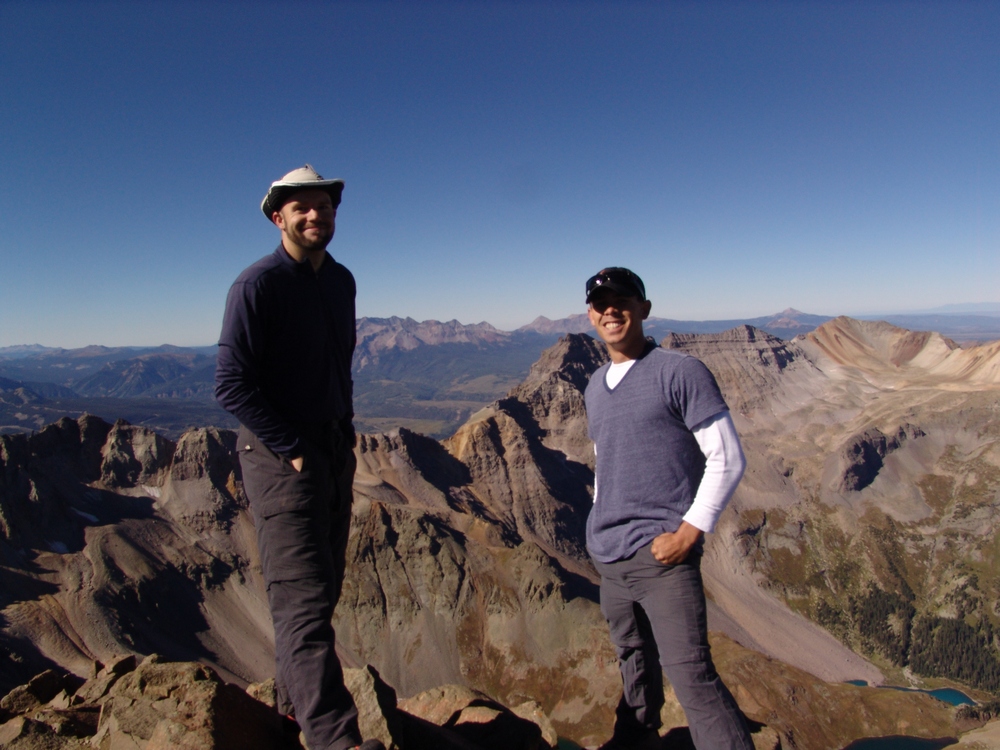
Matt and Arron on the summit of Mount Sneffels.
Views of the Grenadier Range (Vestal, Arrow, etc), and the Needle Range (Eolus, Windom, Sunlight, Pigeon, etc) were great as well as views of Uncompahgre and Wetterhorn. What I was most impressed by was the views of the Grand Mesa and the land between Sneffels and the mesa. The town of Ridgway, Ridgway State Park, and Ridgway Reservoir could all be seen easily as well. What was also impressive were the views of the Telluride Ski Area, the Wilson group (Mount Wilson, Wilson Peak, El Diente, and Gladstone Peak), and the La Plata Mountains.
Mount Sneffels East to West Summit Pano.

Gilpin Peak and Telluride Ski Resort. The Grenadier and Needle ranges seen in the far distance to the left.
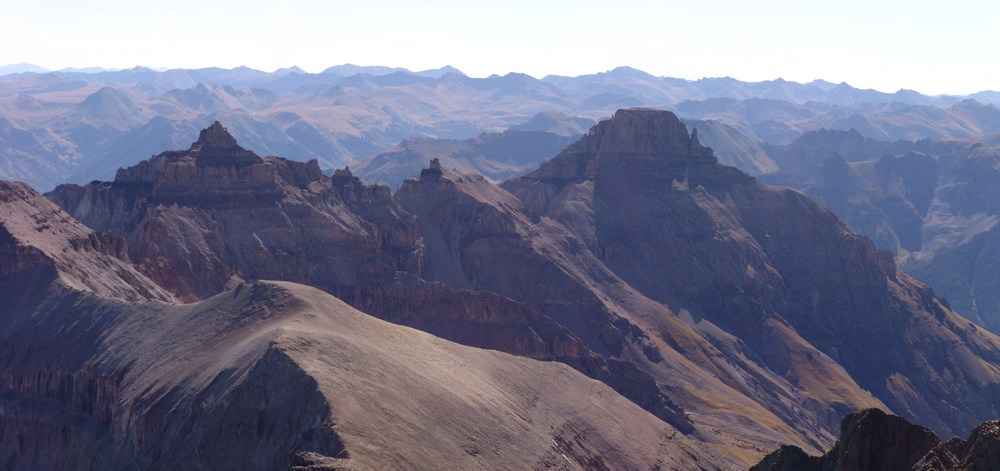
Teakettle Mountain and Potosi Peak zoomed in.

Teakettle, Potosi, Yankee Boy Basin, Gilpin, and Telluride.


360 Degree Summit Pano from Sneffels.
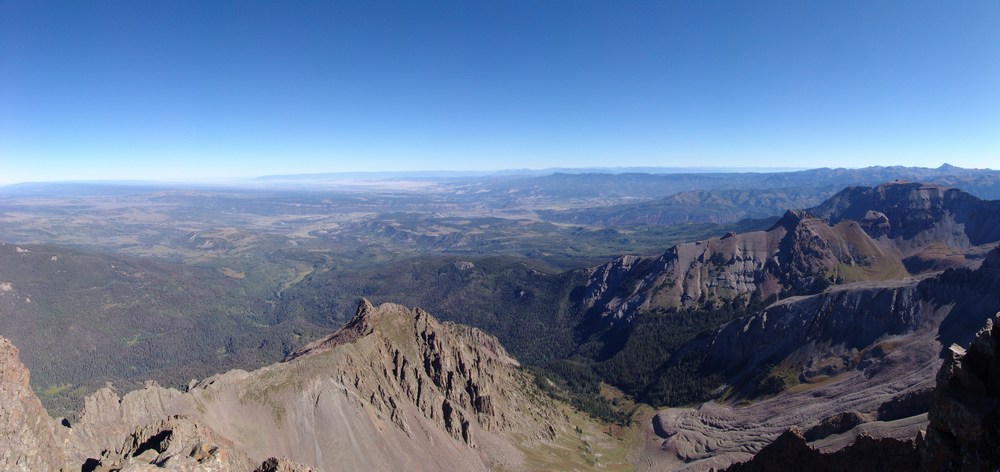
Sneffels summit pano - north and east
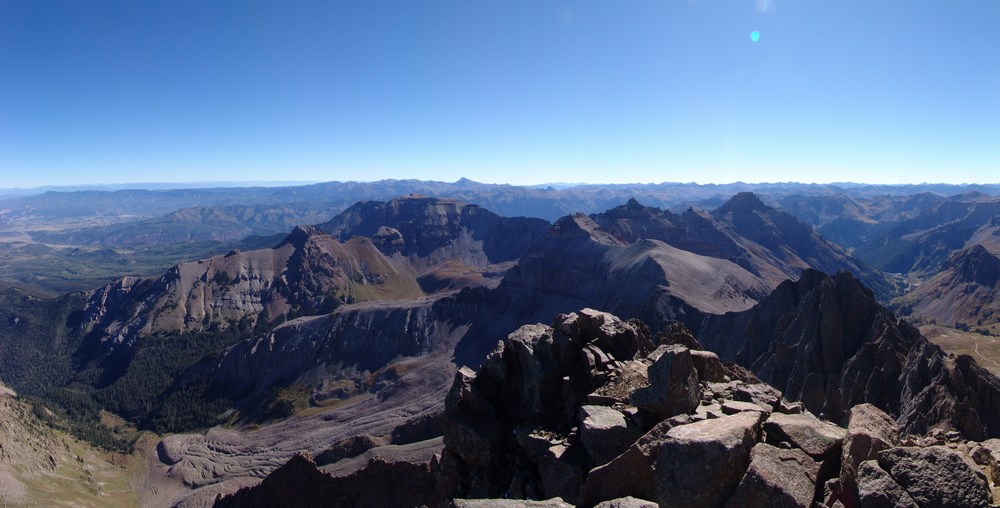
Uncompahgre seen in the distance...

Sneffels Summit - looking south
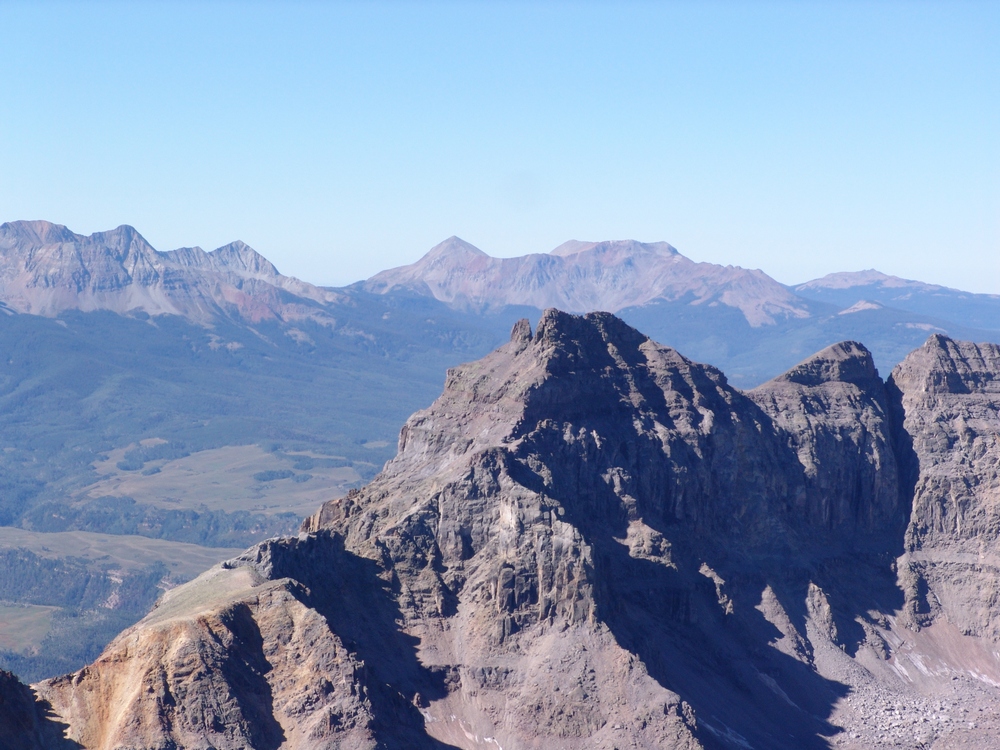
Dallas Peak, Zoomed-in.
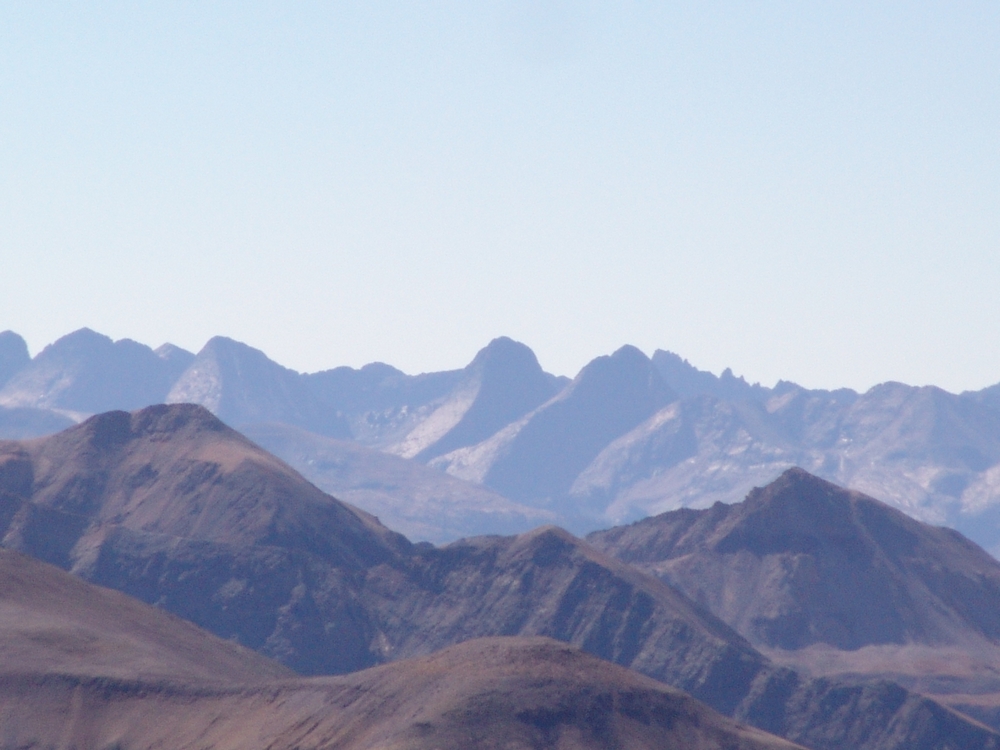
The Grenadier Range - Zoomed-in - including Vestal Peak and Arrow Peak. See that trip report here.
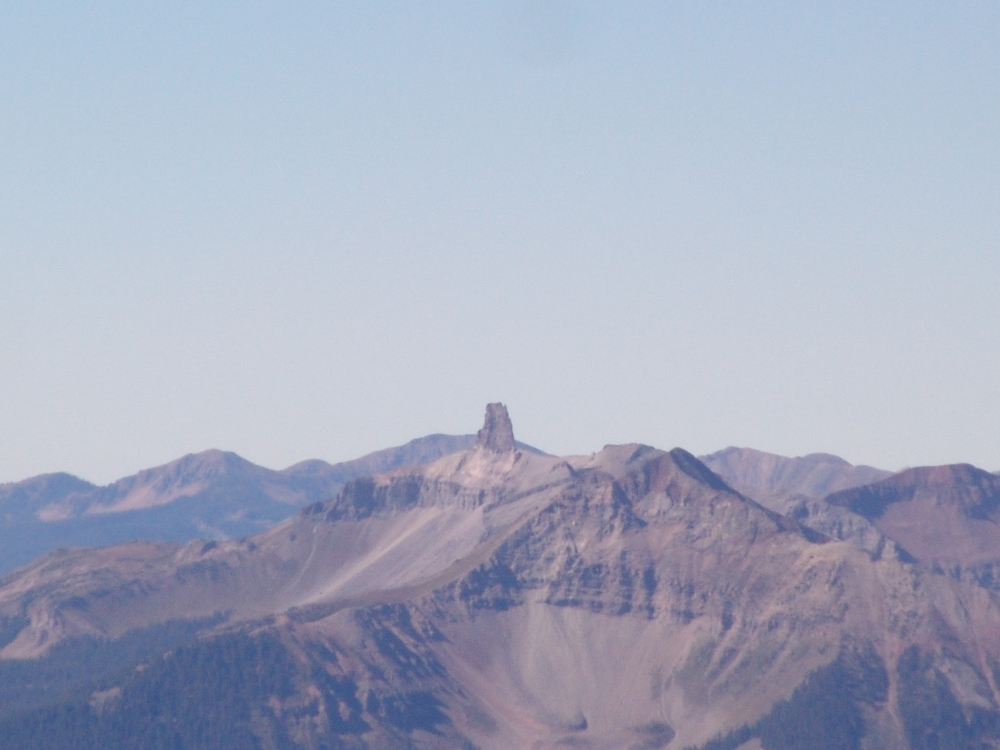
Lizard Head Zoomed-In
And of course, a summit photo is no fun unless I'm posing in a silly way...
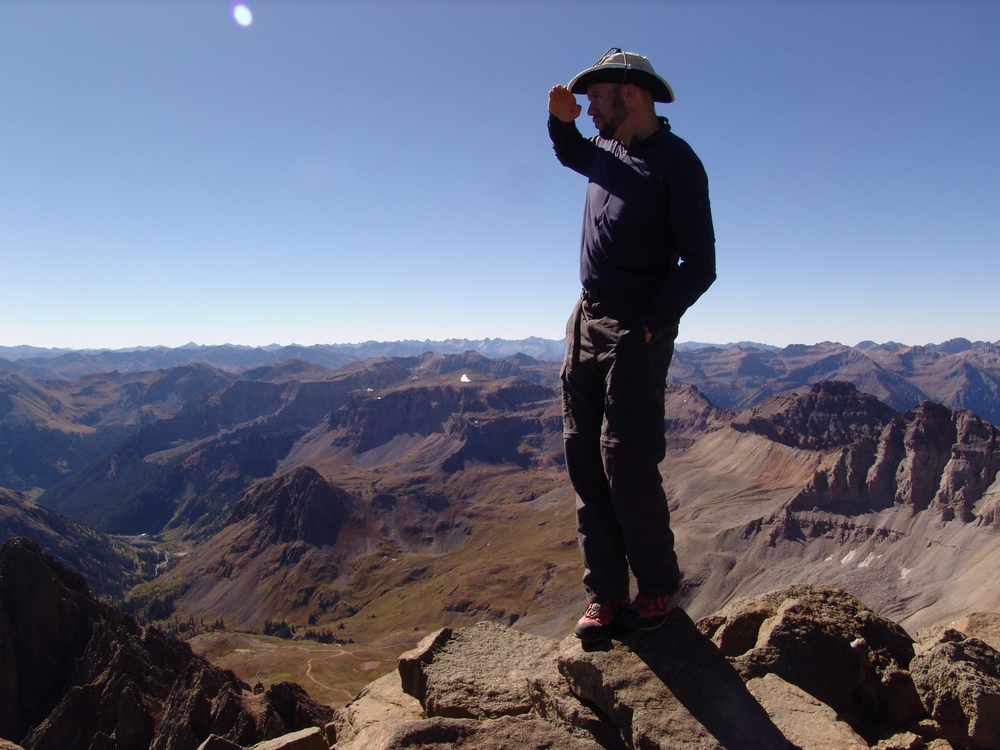
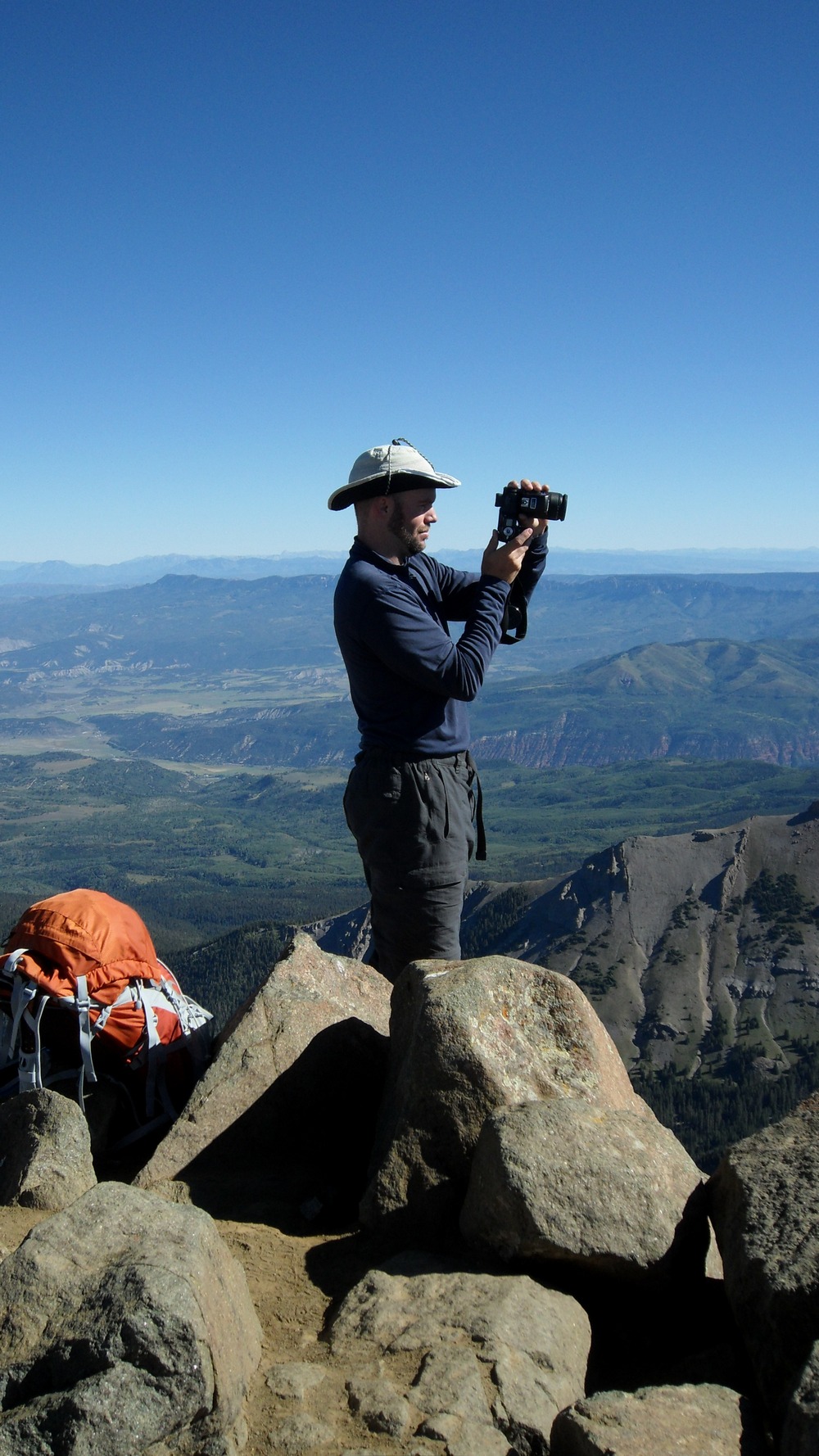
Matt Payne taking photos on the summit of Sneffels.
After quite some time on the top, Arron and I decided to descent the same way we ascended. The down-climb was challenging but solid. There were some tricky sections that required some in-facing down-climbing, and a few spots where we needed to wait for each other to ensure neither of us were hurt by rock-fall from above.
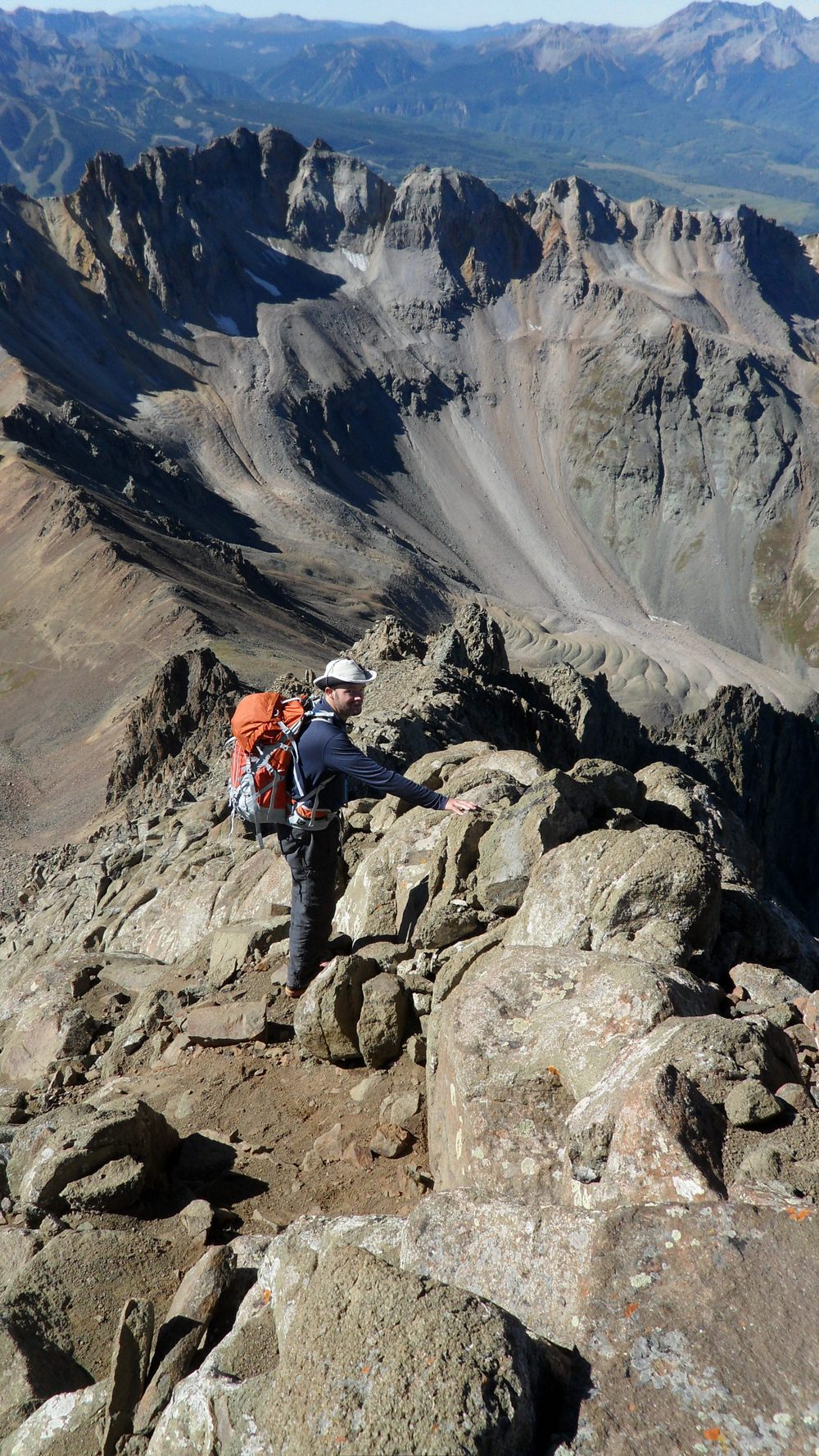
Down the Southwest Ridge!
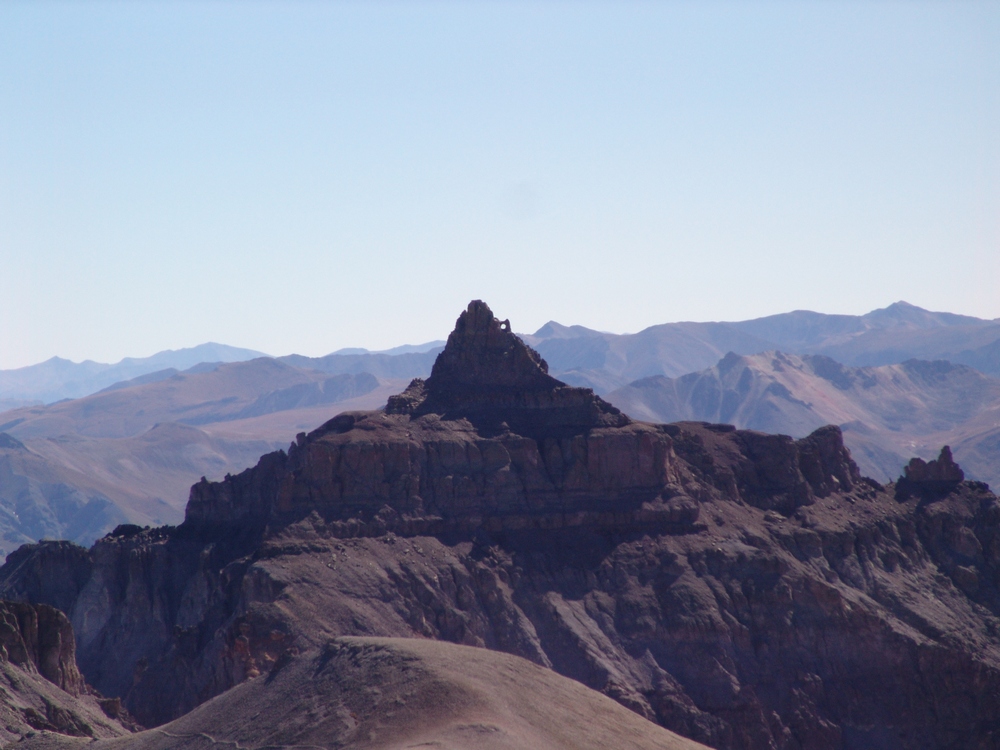
Teakettle Mountain
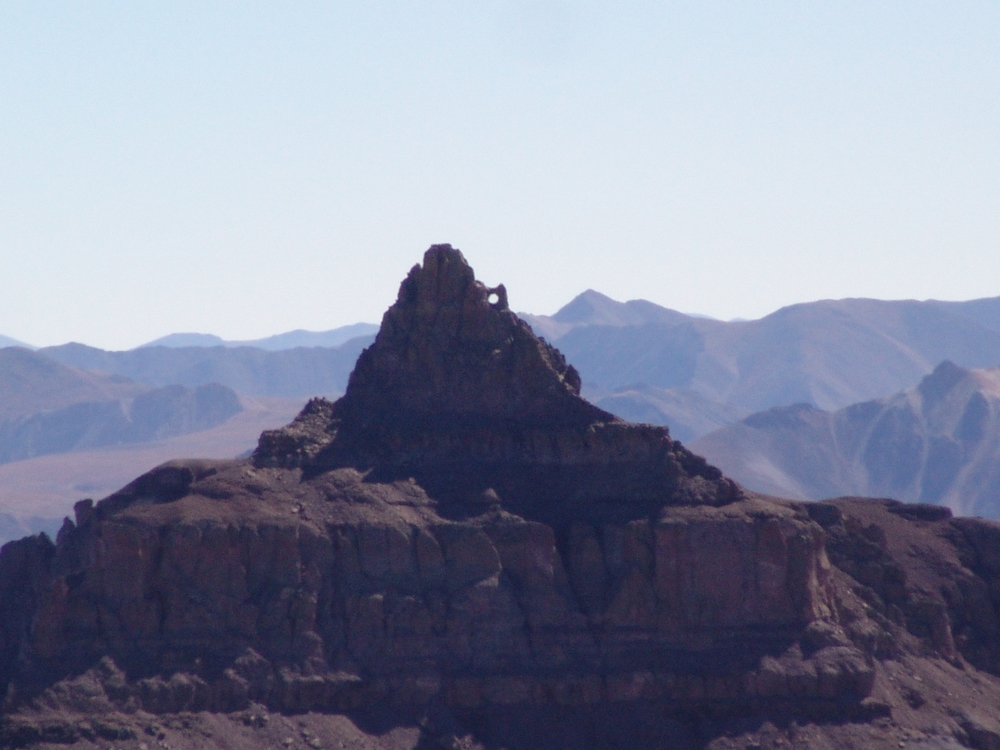
Teakettle with digital zoom.
We reached the camels again in no time and I took one last shot of the Wilson group.
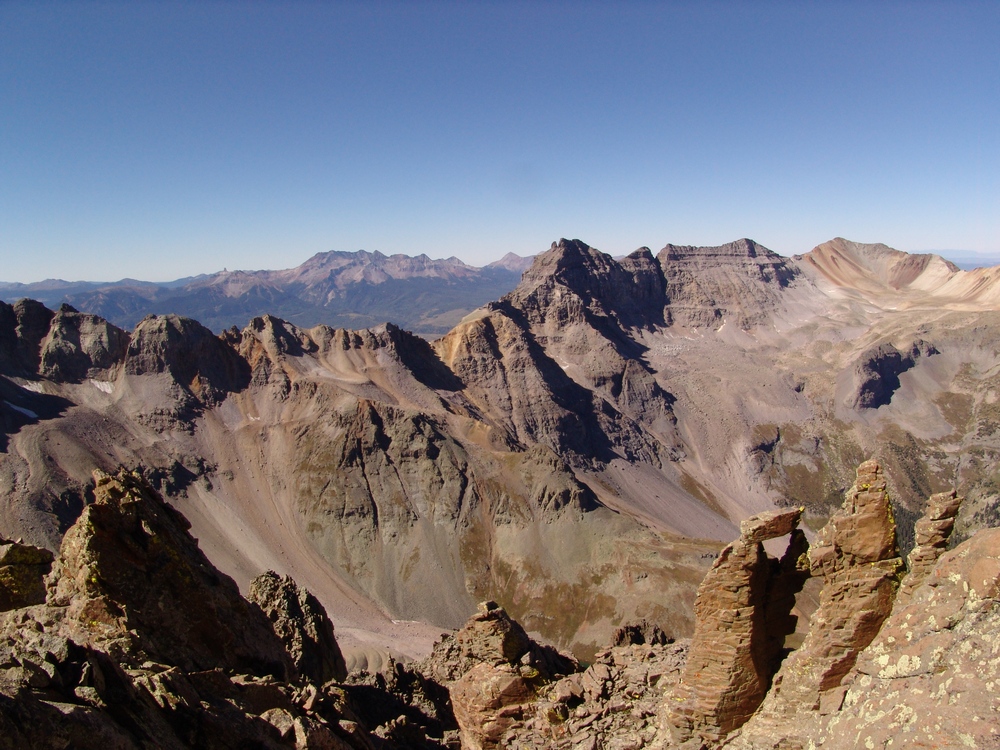
The trickiest part was when we came across some class 4 rock that we had to negotiate. It was a fun challenge for sure.
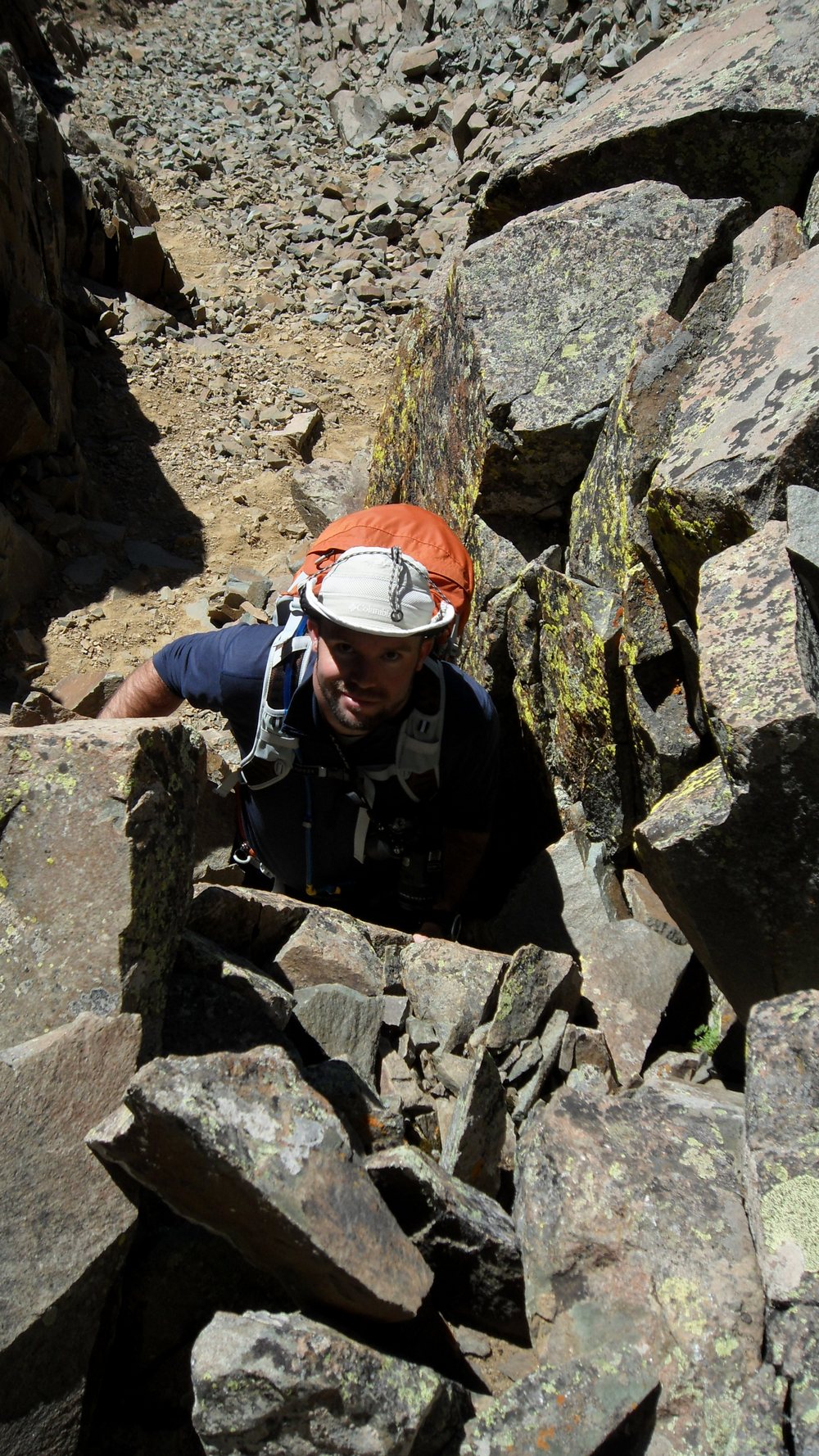
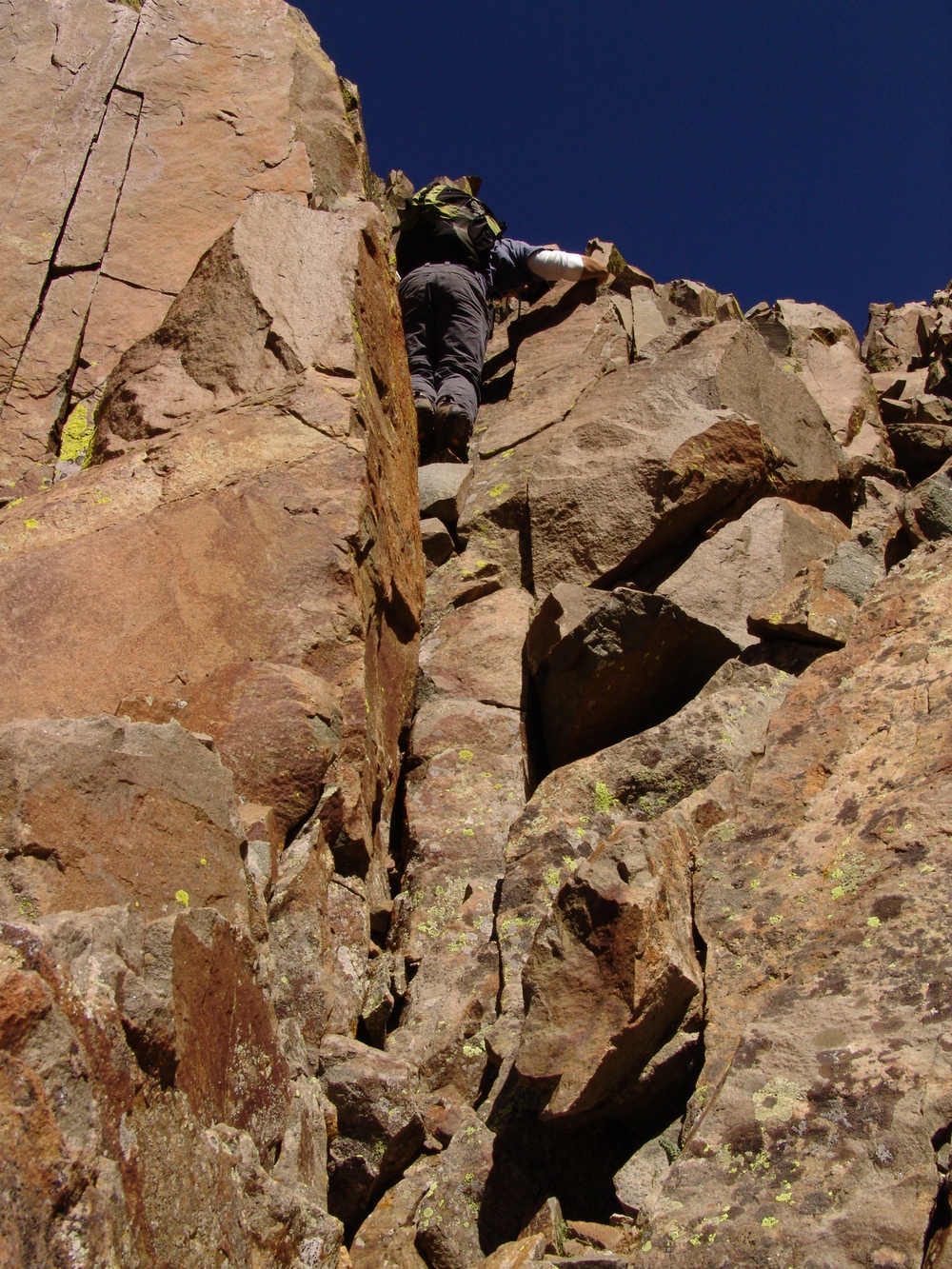
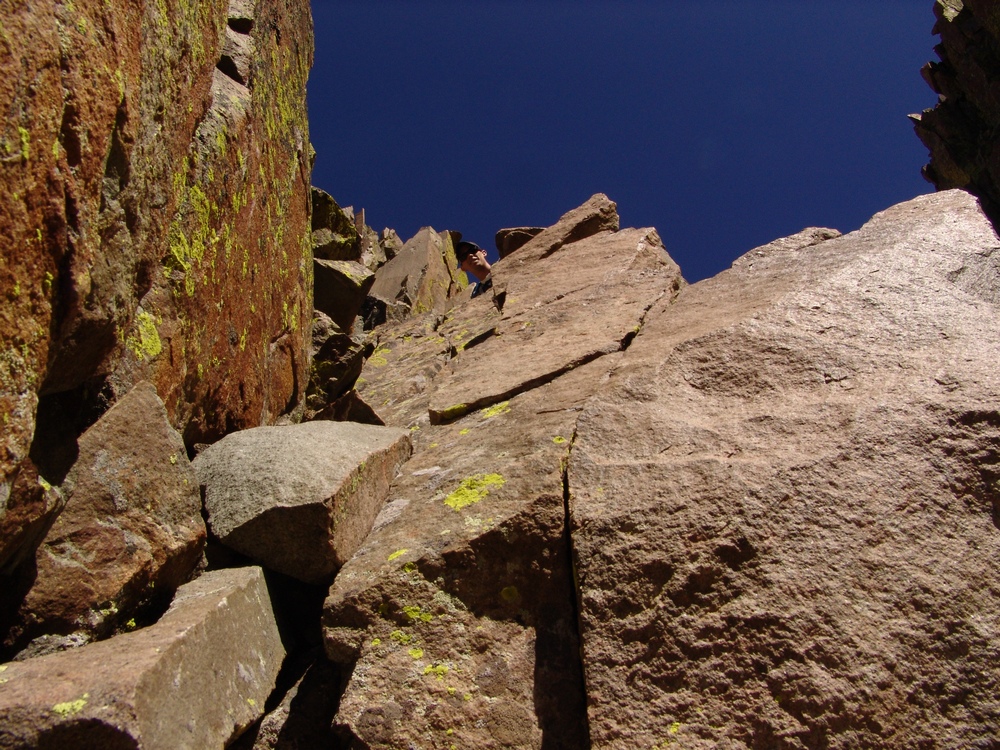
The class 4 section provided some entertainment.
We headed back down to the Blue Lakes Pass ridge without any problems.
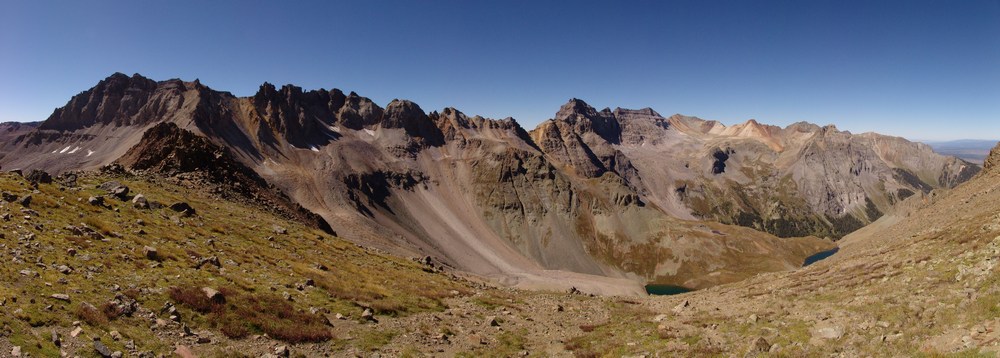
Blue Lakes Pass. I wonder why it is called Blue Lakes Pass?
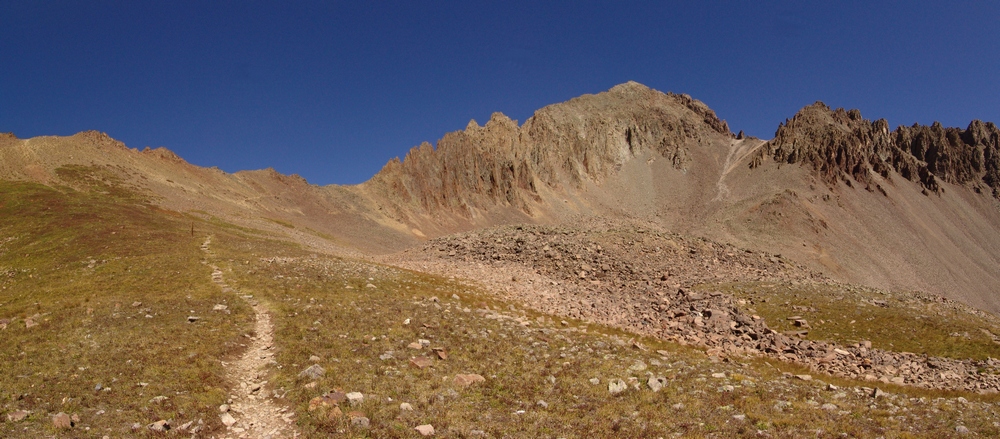
The Blue Lakes Pass trail and Mount Sneffels.
We hiked down the Pass back towards Yankee Boy Basin and decided to take a side trail that led us to a small lake at the base of Gilpin Peak.
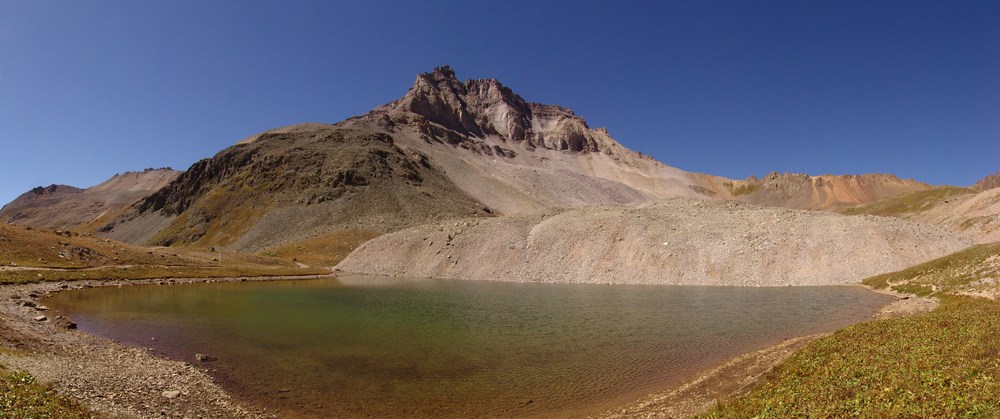
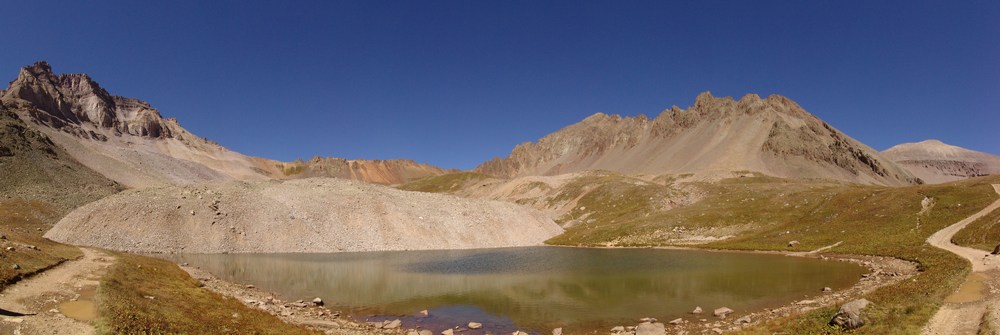
Gilpin Peak and Mount Sneffels.
As we hiked down, we were blessed with one last great view of Yankee Boy Basin.

Yankee Boy Basin
We reached my Jeep at 12:00 PM and drove out. The road was quite enjoyable in 4WD without power steering...
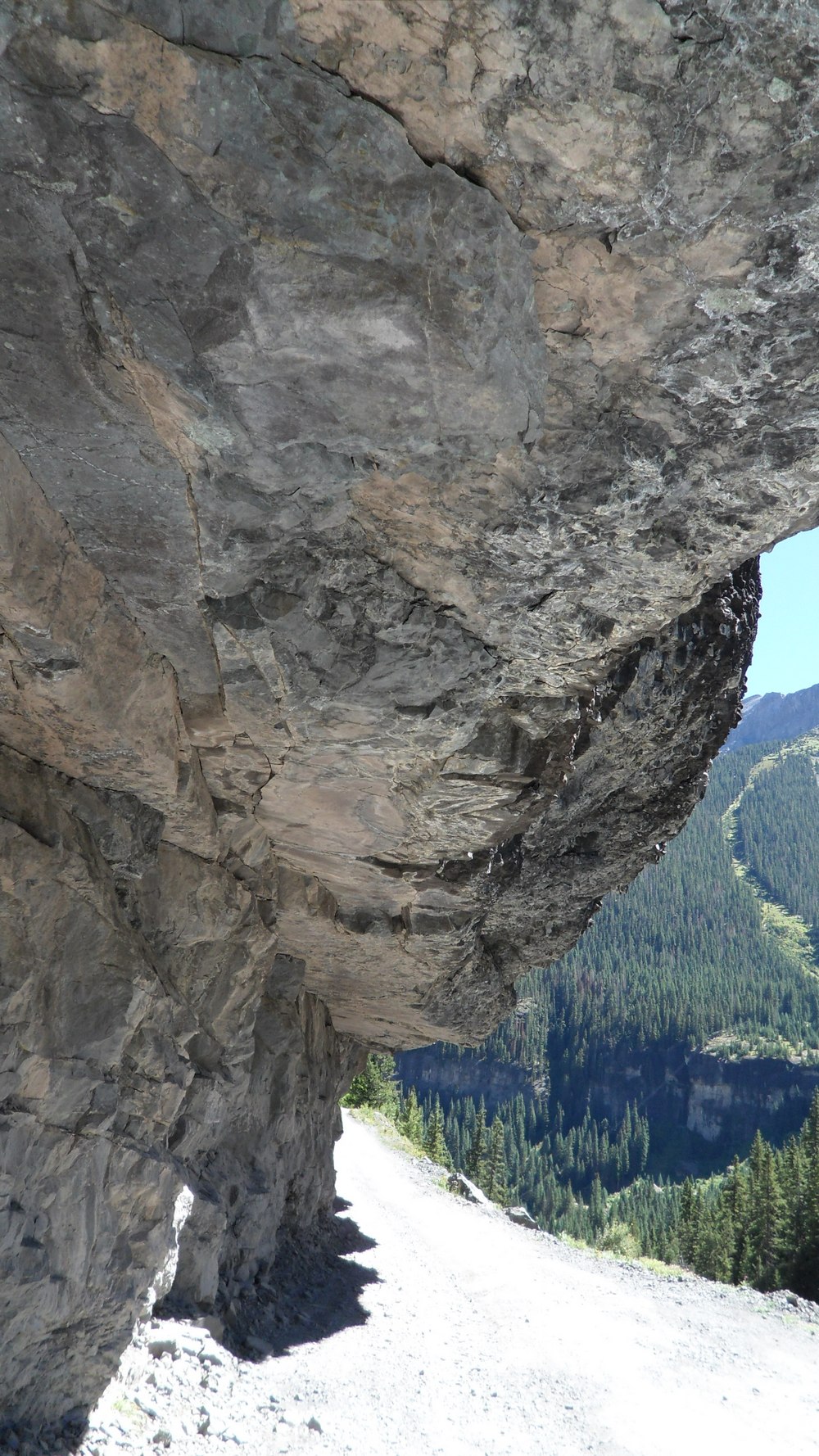
If you've never been up the road, it is worth it to drive up it. There is a really awesome overhang about halfway up the road that is quite impressive.
We drove into Ouray and ate lunch at the Ouray Brewery, which proved to be a great decision because they have a patio on their roof that made for excellent fall weather dining.
I hope you found this trip report useful and / or enjoyable! Thanks for reading!
References:
1 Rhoda, Franklin, Summits to Reach, An Annotated Edition of Franklin Rhoda's "Report on the Topography of the San Juan Country," edited and with preface by Mike Foster, Boulder, Pruett Publishing (1984).
2 Rosebrough, Robert F., The San Juan Mountains: A Climbing and Hiking Guide, Evergreen, Cordillera Press (1986).



